Japan is one of the best countries for food, not just in Asia, but in the world. The fact that Japan trails only France in number of Michelin stars speaks for itself.
Unlike many travel bloggers, we don’t have a desire to visit every country in the world but we do intend to visit every prefecture in Japan, and a lot of that has to do with our love for traditional Japanese food culture. If the cost of living weren’t so high, we’d actually love to live in Japan. That would be a dream!
To be honest, I don’t think I’ve ever met a Japanese dish I didn’t like so it was hard limiting this food guide to just 45 dishes. To make it as well-rounded as possible, I focused on creating a balanced list that featured both popular Japanese dishes and more obscure regional specialties from the different prefectures in Japan.
Traditional Japanese foods like ramen and tempura are represented well but so are lesser known prefectural delicacies like fukagawa meshi and kaga ryori. You’re probably familiar with maguro sushi and sashimi, but have you tried kabura zushi?
Japanese cuisine is my favorite cuisine in the world so a lot of love went into writing this guide on traditional Japanese foods. No matter what your level of affection for traditional Japanese cuisine, I hope you find something delicious to whet your appetite before that next trip to Japan.
JAPANESE FOOD QUICK LINKS
If you’re planning a trip to Japan and want to really dive into the cuisine, then you may be interested in joining a food tour or taking a cooking class.
TOURS & OTHER SERVICES
- Food Tours: Food and Drinking Tours in Japan
- Cooking Classes: Cooking Classes in Japan
- Other Food Experiences: Food Experiences in Japan
- eSIM: Japan eSIM
Save This on Pinterest!
No time to read this guide on traditional Japanese foods? Click on the save button and pin it for later!
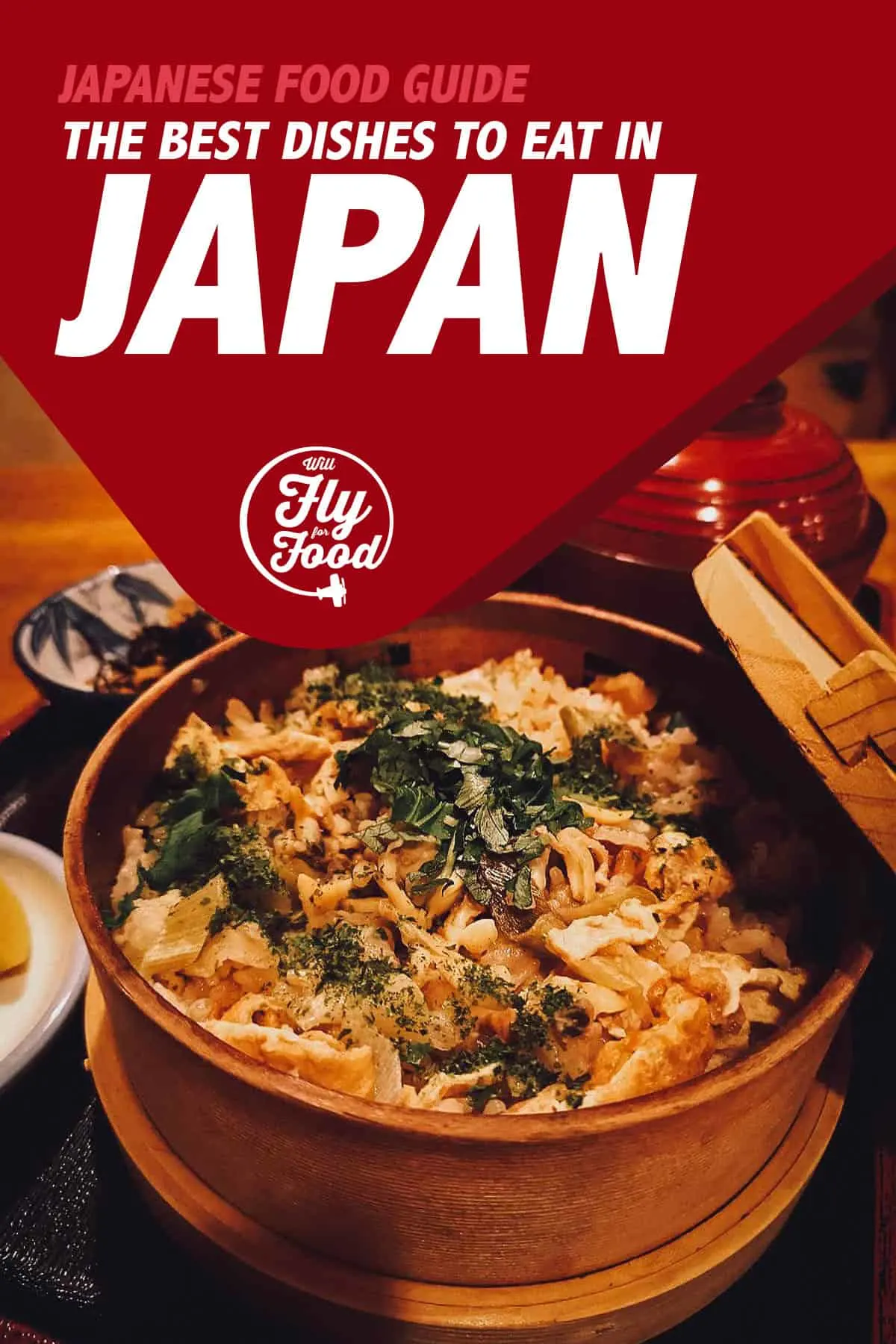
WHAT IS TRADITIONAL JAPANESE FOOD?
Traditional Japanese food or washoku is characterized by its sense of balance, aesthetics, and the seasonality and freshness of its ingredients. Different dishes are served depending on the season. Rice is a staple dish in Japanese cuisine, and to a lesser extent, so are noodle dishes like soba and udon.
Like many countries in Asia, rice is combined with one or two main dishes to go with a number of side dishes that typically include miso soup and tsukemono (Japanese preserved vegetables). The phrase ichiju-sansai – meaning “one soup, three sides” – describes the makeup of a typical Japanese meal.
When Buddhism became the official religion in Japan during the Kofun period, the consumption of meat became limited. This led to a minimal use of spices in Japanese cooking and an increase in the use of fish and other types of seafood as the main source of protein in Japanese cuisine.
In the 9th century, grilled and raw fish were widely consumed throughout Japan and a new way of preserving fish was invented. This Japanese method of preserving raw fish by fermenting it in boiled rice is recognized as the earliest form of sushi.
Only when Japan started opening up to the west in the mid- to late-19th century did meat find its way back into the Japanese diet. This gave rise to the popular Japanese meat dishes of today like tonkatsu, wagyu, and yakiniku.
Historically, traditional Japanese cuisine was influenced by Chinese cuisine but modern Japanese food culture has been influenced by western cuisines as well. You can see (and taste) this western influence in dishes like Japanese curry, spaghetti, pizza, and hamburgers.
THE BEST JAPANESE DISHES
To help organize this list of the best-tasting Japanese foods, I’ve divided them up by category. Click on a link to jump to that section.
POPULAR JAPANESE FOODS
If you don’t have a lot of experience with Japanese cuisine and want to try the most popular dishes, then you can start with these ten famous Japanese foods.
1. Sushi
Sushi is the most famous Japanese dish and the first thing people think of when they think of Japanese cuisine. For sushi connoisseurs, it’s more than just food. It’s an art form.
Sushi refers to a family of artfully presented dishes made with vinegared sushi rice and a variety of ingredients, mostly raw fish and other types of seafood. It can be made with any type of fresh raw fish, some of the most popular being maguro (tuna), shake (salmon), hamachi (yellowtail), saba (mackerel), and unagi (freshwater eel).
Sushi is commonly eaten with pickled ginger and dipped in soy sauce mixed with wasabi.
RECIPE: Sushi rolls
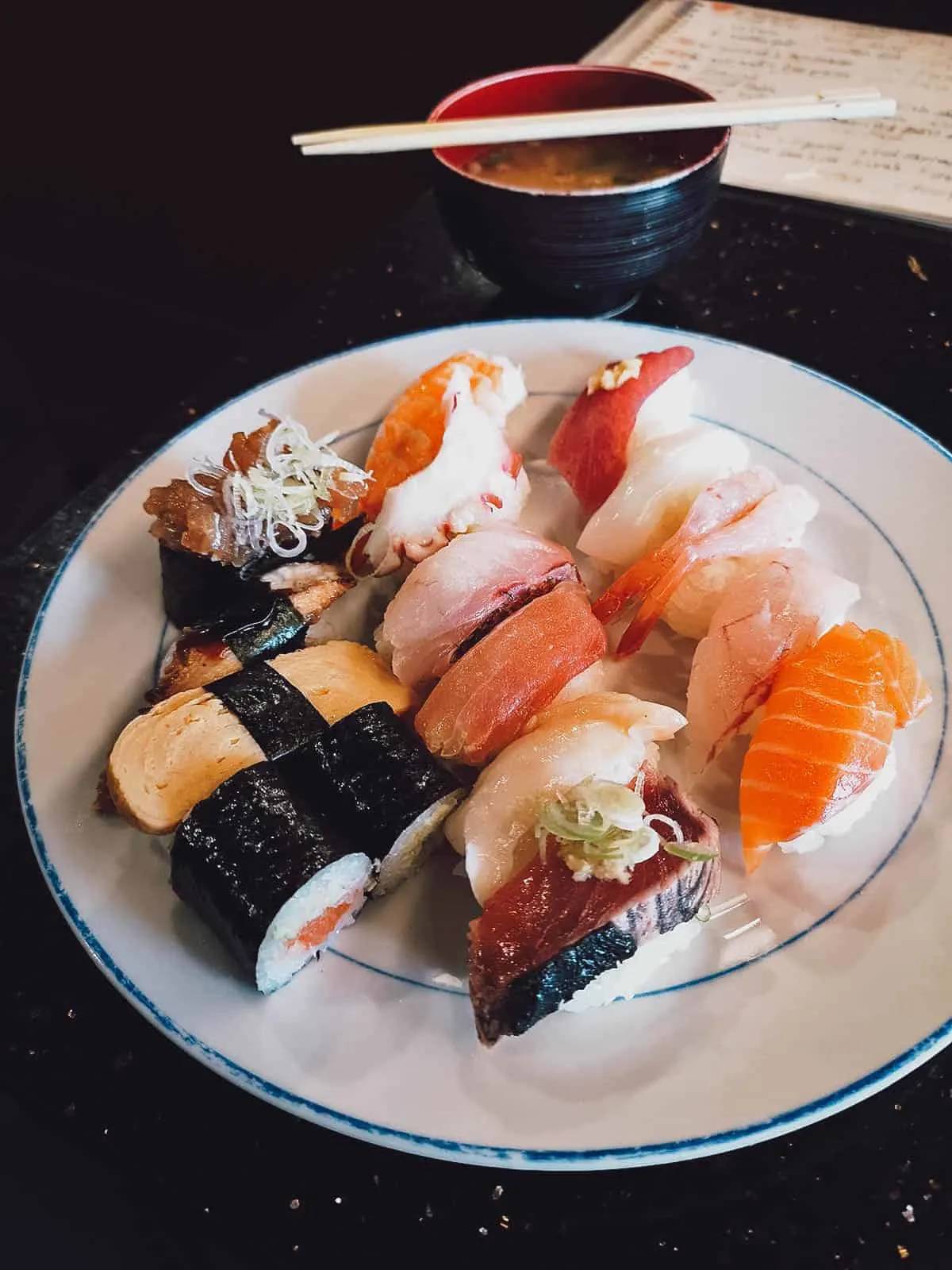
Sushi was invented in Japan as a way of preserving raw fish by storing it in fermented rice. This early type of sushi is known as narezushi and can still be enjoyed in Japan today.
Pictured below is kabura zushi, a more modern type of narezushi associated with Kanazawa. It’s a Kanazawa food specialty made with salted buri (Japanese amberjack or yellowtail) sandwiched between pieces of pickled turnip.
More common types of sushi in Japan include maki sushi, nigiri sushi, chirashizushi, and inari sushi. Non-Japanese people are probably most familiar with nigiri sushi and maki sushi.
Nigiri sushi refers to oblong-shaped rice balls topped with a sliver of fish and other types of seafood, while maki sushi is the type of sushi commonly referred to as “sushi rolls”. You can see examples of both in the picture above.
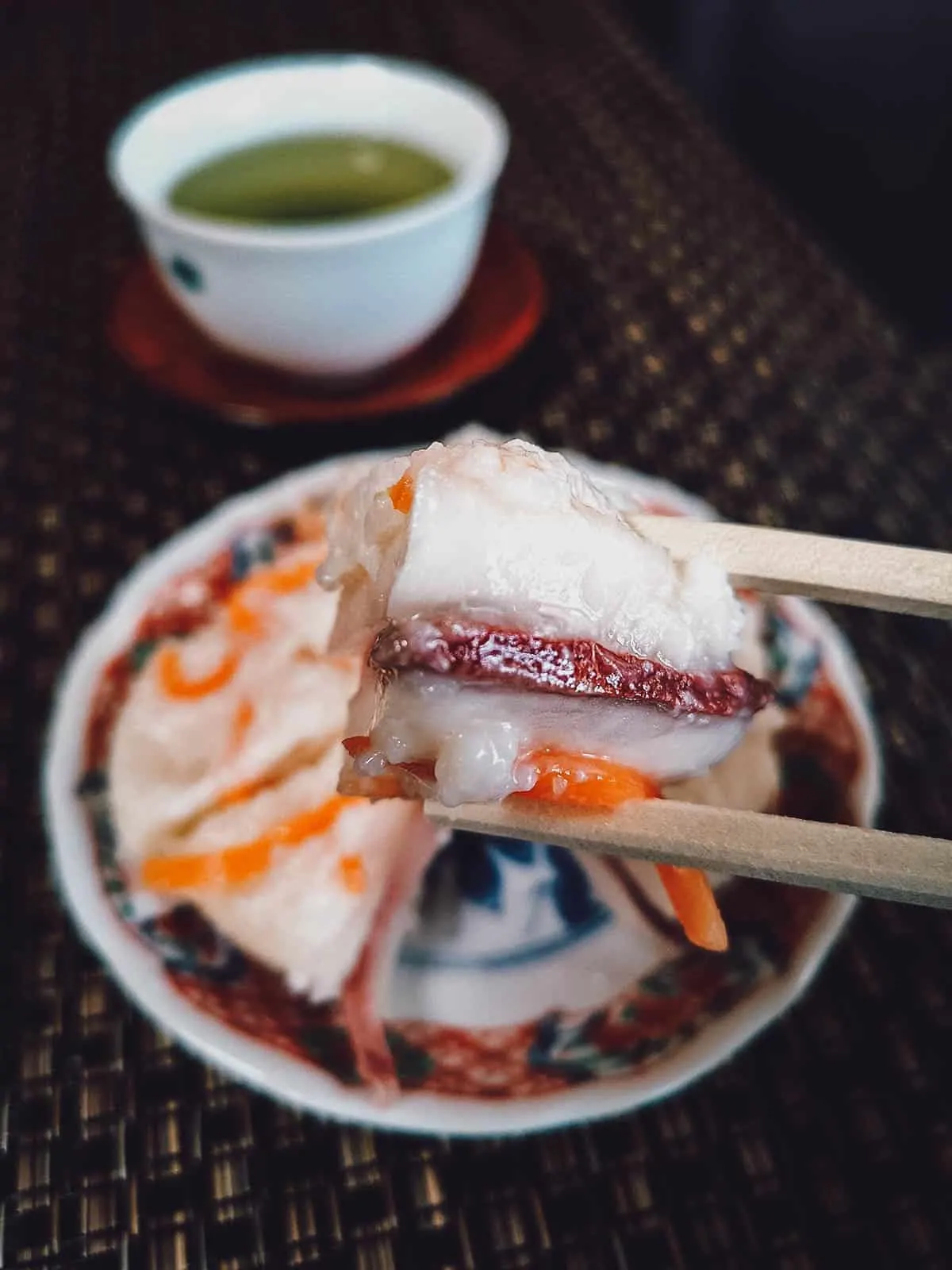
2. Sashimi
Sashimi refers to thinly sliced raw fish or seafood. It can even refer to different types of raw meat. It’s basically sushi minus the vinegared rice. Like sushi, it’s usually eaten with soy sauce mixed with wasabi.
It isn’t fish but pictured below is one of my favorite types of sashimi – uni or sea urchin sashimi. Often served in its own shell, I had this golden glistening bowl at Kuromon Ichiba Market in Osaka but you can pretty much find uni sushi and sashimi at any seafood market in Japan.
RECIPE: Sashimi
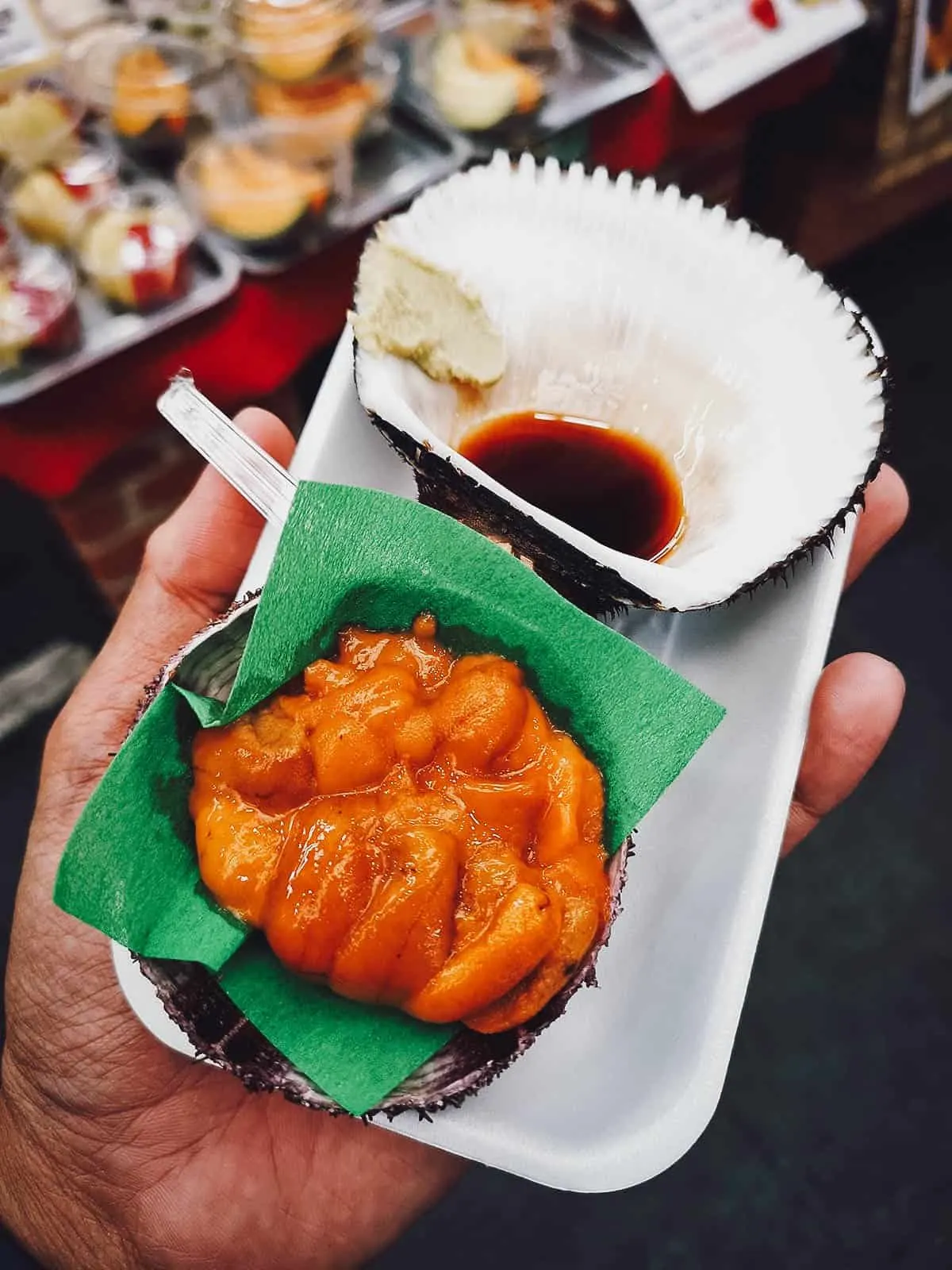
Spoiler alert, the sashimi below isn’t made with fish either. If you’re a daring eater, then you may want to try chicken sashimi. Yes, you read that correctly – RAW chicken sashimi.
Chicken sashimi is made from a specific breed of Japanese chicken known as the “blue foot chicken”. This breed of chicken presents a lower risk of salmonella though the raw chicken meat still needs to be super fresh to be safely eaten. Because of obvious health concerns, a special license is required to serve raw chicken in Japan.
Chicken sashimi is absolutely delicious and one of the most surprising Japanese dishes we’ve had so far in Japan. If you can get past the fact that it’s raw chicken, then I suggest trying it if you see it on a Japanese restaurant’s menu.
We haven’t seen it that often but we did get to try it at Korombia Izakaya in Sapporo.
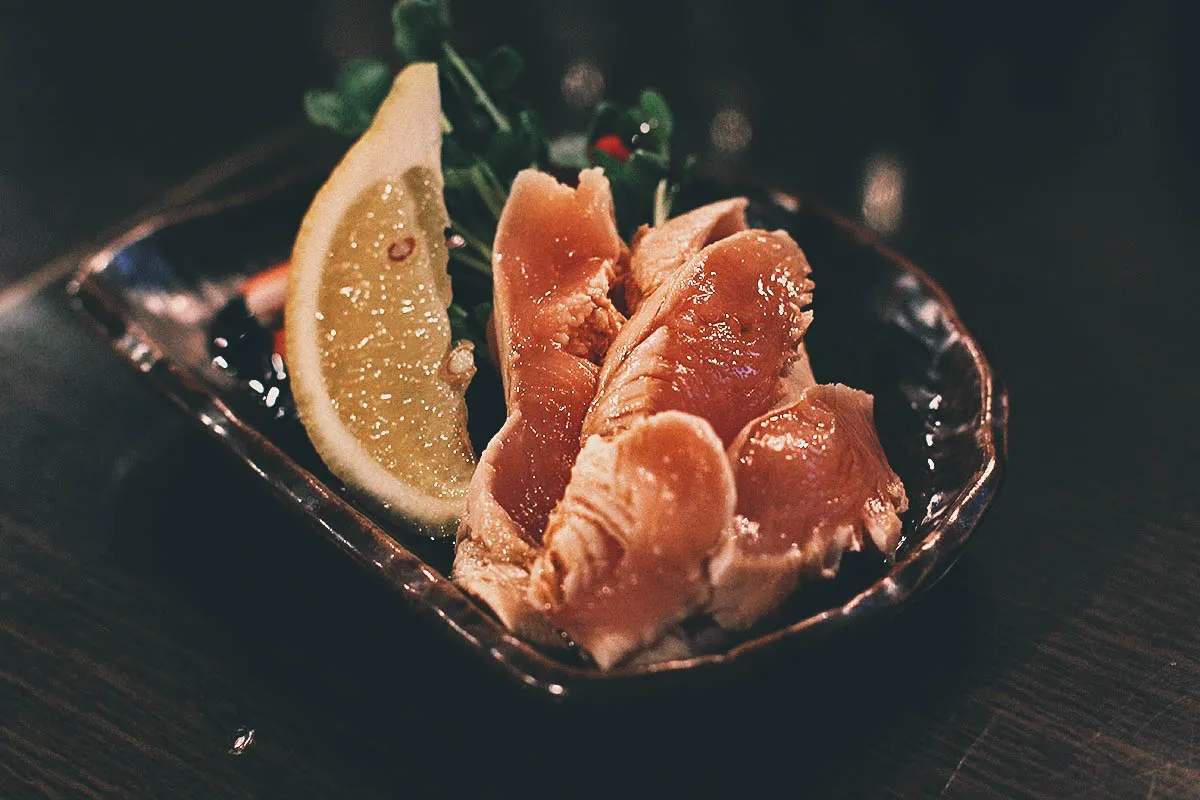
3. Ramen
Like sushi, ramen is a Japanese food favorite and one of the best dishes you can eat in Japan. It refers to a noodle soup made with four basic components – the broth, tare (seasoning), wheat noodles, and toppings.
Tare (or kaeshi) is the salty concentrated essence placed at the bottom of every ramen bowl. Together with the broth, it’s what determines the style of the ramen, of which there are four main types – shoyu, miso, shio, and tonkotsu. The noodles and toppings enhance the experience but the true star of this beloved Japanese dish is the seasoned broth.
It’s important to understand that even with the four recognized styles of ramen, limitless variations exist within each style. Every bowl of ramen falls into one of the four basic types but the variations within each style are immense. And we aren’t even talking about the type of noodles or combination of toppings yet!
So vast are the possibilities with ramen that a large number of varieties have been established throughout the different regions of Japan. In fact, you can write an entire Japanese food guide on ramen alone.
Pictured below is a bowl of miso ramen from Ramen Alley in Sapporo. It’s made by mixing miso (soy bean paste) with oily chicken or fish broth to create a heavy and hearty soup suitable for Hokkaido’s harsh winters. It’s one of the best Japanese dishes to look for when you visit Sapporo.
Toppings between restaurants vary but miso ramen is usually topped with a variety of ingredients like chashu (thinly sliced braised pork belly), nori (seaweed), ground pork, leeks, scallions, bean sprouts, and a ramen egg.
RECIPE: Miso ramen
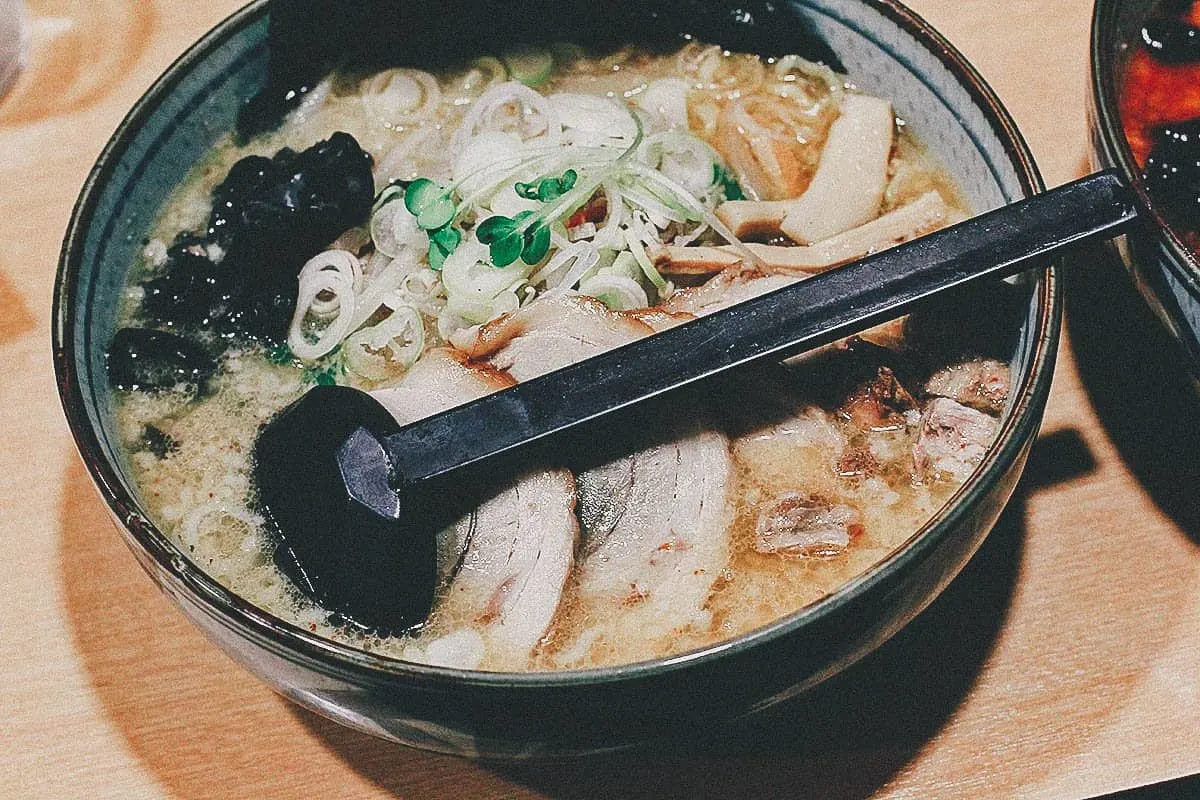
Personally, my favorite type of ramen in Japan is Fukuoka’s Hakata ramen. Also known as tonkotsu ramen, it’s made by boiling pork bones, fat, and collagen over high heat for anywhere between 12-20 hours. This long boiling process breaks down the marrow, causing it to ooze out and create a rich and milky broth.
Hakata ramen is often made with thin wheat noodles and usually topped with scallions, wood ear mushroom, chashu pork, and a ramen egg. It’s creamy and delicious and one of the best Japanese dishes you can have when you visit Fukuoka.
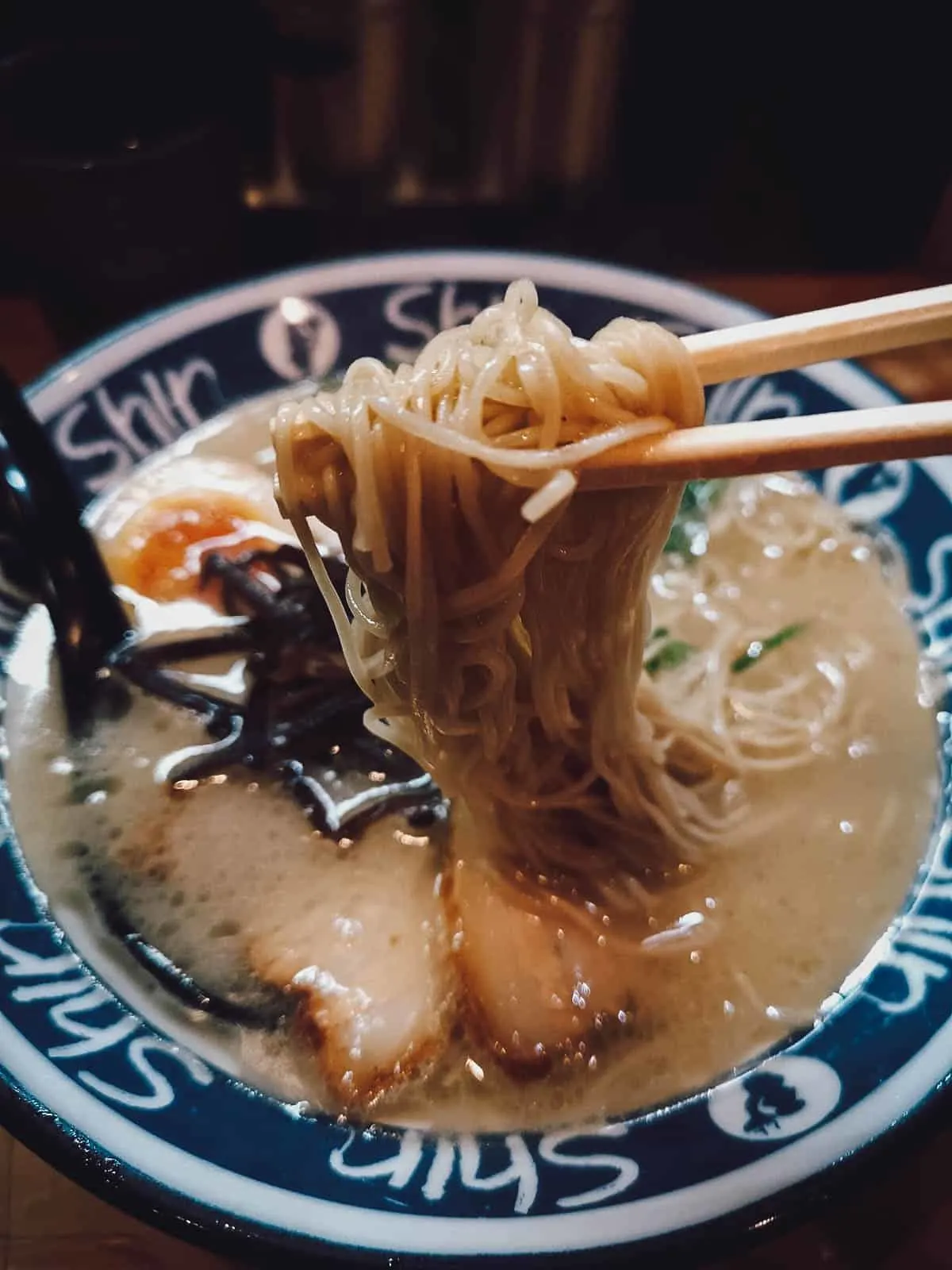
Another variation of ramen you might want to try in Japan is tsukemen. Tsukemen refers to any style of ramen where the broth and noodles are served separately. This is to ensure that the noodles stay firm throughout your meal.
To eat, you dip the noodles into the soup. Tsukemen broth is more intensely flavored than typical ramen broth to make sure the noodles are coated with as much flavor as possible.
Pictured below was one of the most delicious and interesting bowls of ramen I’ve ever had in Japan. It’s a type of tsukemen made with motsu or offal. You can check out our Kyoto food guide for more details.
It’s funny, I went on this Kyoto foodie night tour later that day and my guide was surprised when I told him I had this motsu tsukemen for lunch. Coincidentally, it’s his favorite bowl of ramen in Japan.
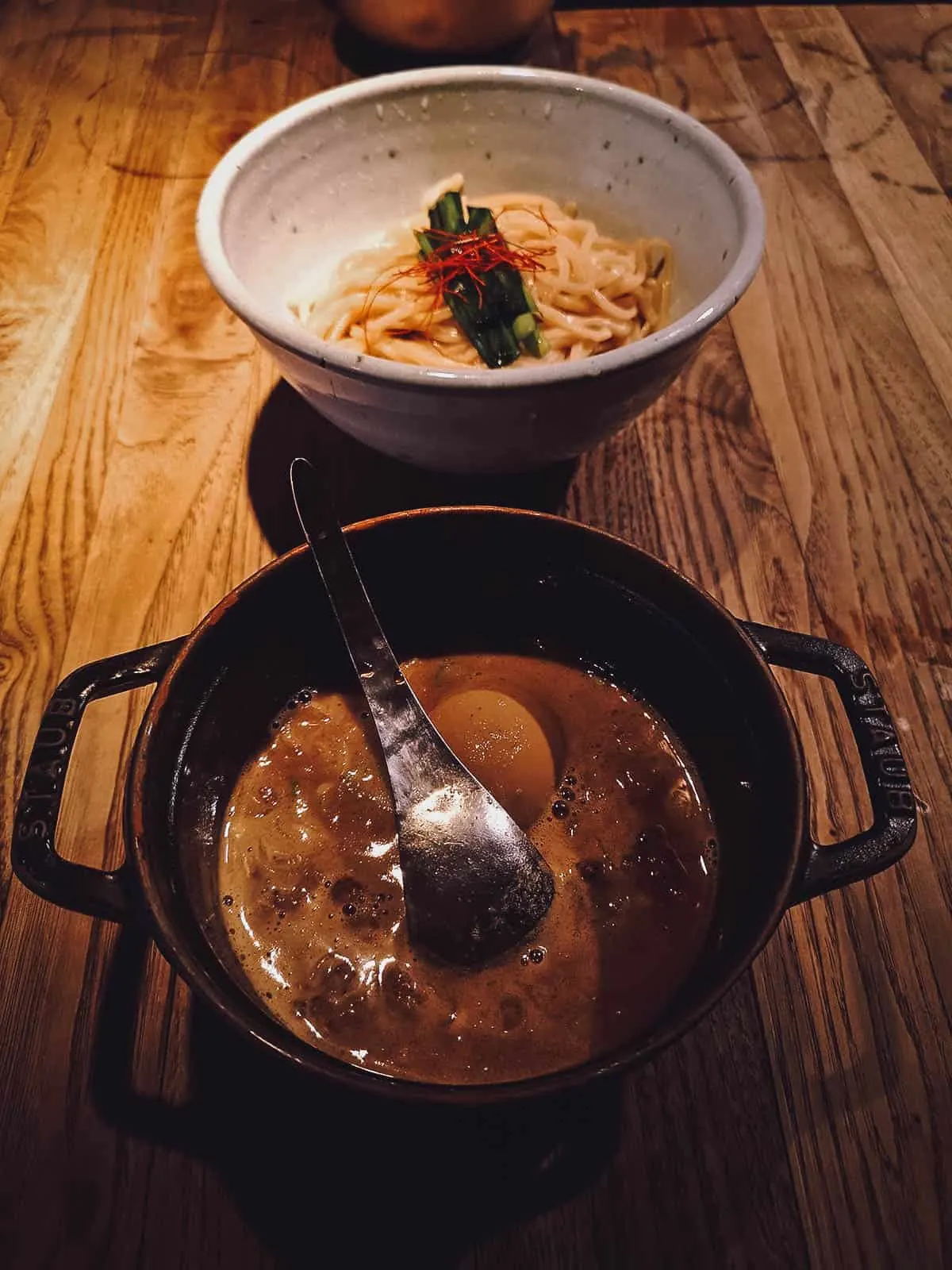
4. Tempura
Tempura is a traditional Japanese cooking method that involves deep-frying seafood or vegetables coated in a light batter made with cold water and soft cake flour. The tempura batter is lightly mixed and kept cold with lumps to create a crisp and fluffy texture when fried.
Most tempura is cooked for just a few seconds before being served with grated daikon radish and a dipping sauce, most often tentsuyu which is made with dashi (soup stock), mirin (rice wine), and shoyu (soy sauce). Alternatively, it can be sprinkled with sea salt or mixtures of powdered green tea, salt, and yuzu before eating.
Different types of fish, seafood, and vegetables are used to make tempura in Japan though ebi (shrimp) is the most popular.
RECIPE: Tempura
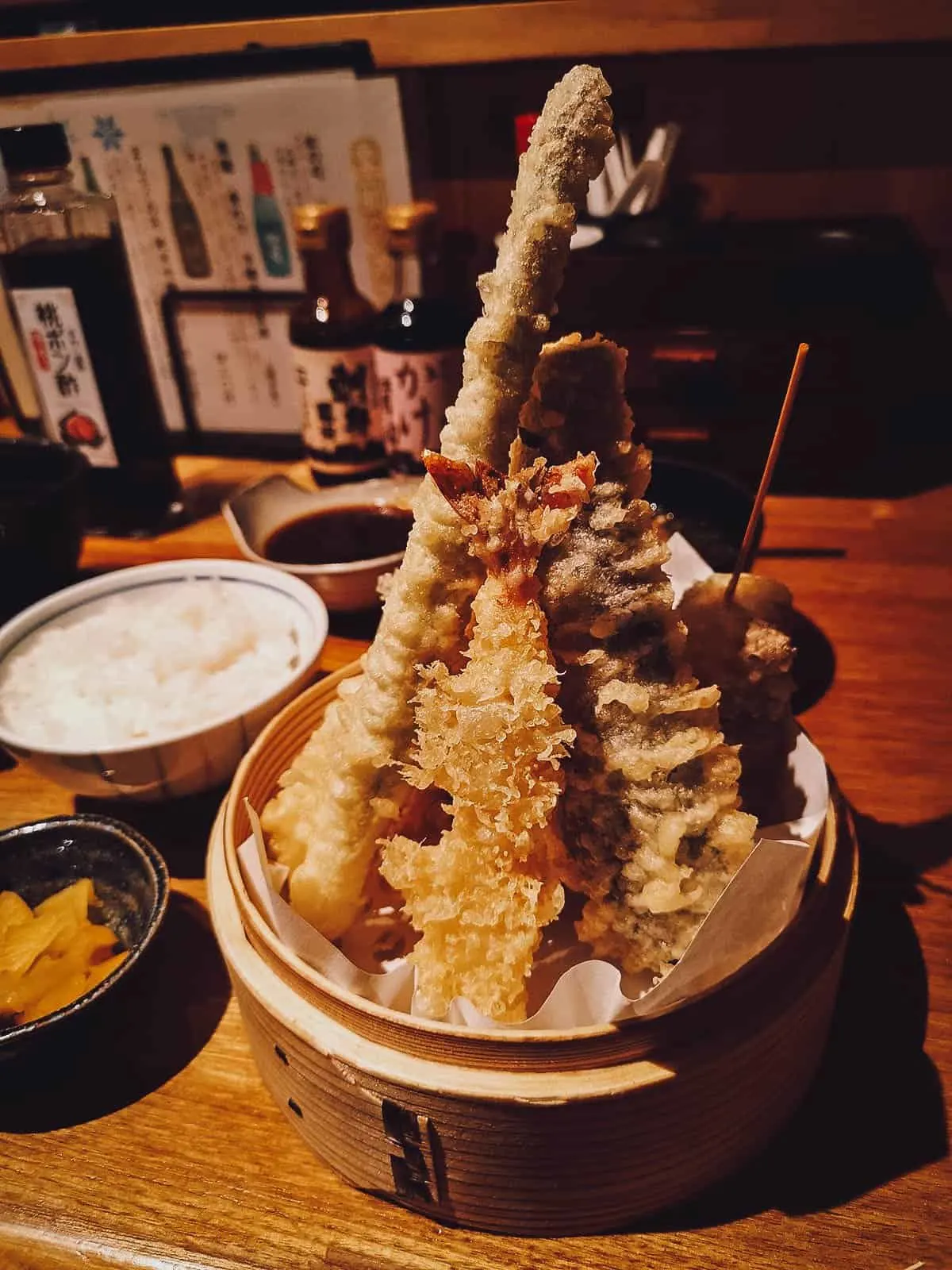
5. Unagi
Unagi is freshwater eel. It isn’t to be confused with anago which is saltwater or conger eel.
To prepare unagi, the eel is cut open and its head and bones are removed. The meat is then skewered and broiled before being slowly grilled over charcoal while being basted with a kabayaki sauce (sweet soy sauce).
Grilled unagi is commonly served as sushi in Japan, or over a bed of rice in a dish called unagi donburi or unadon for short.
RECIPE: Unagi don
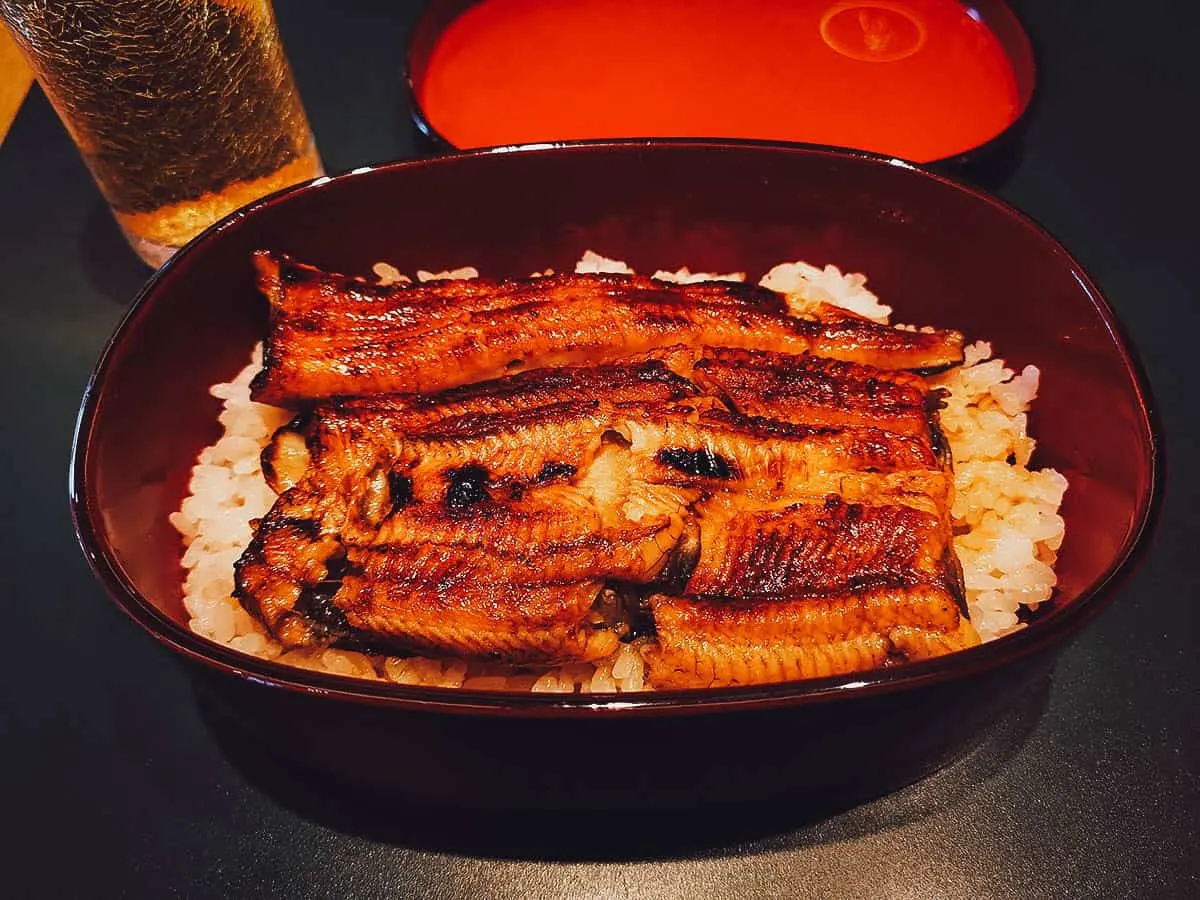
One of the best unagi dishes you can eat in Japan is hitsumabushi. It refers to a Nagoya specialty of grilled unagi over rice that’s eaten in three stages.
Unagi is served in a bowl over rice with yakumi (condiments) and dashi as a side dish. The first stage involves eating the eel over rice as is.
After you’ve had a few bites, you then mix the yakumi into your bowl in the second stage. The type of yakumi varies between restaurants but they typically include ingredients like wasabi, pickled vegetables, nori (seaweed), and green onions.
When you’re down to your last few bites, you pour the dashi (sometimes tea) into your bowl and finish the rest. It’s a fun way of eating unagi in Japan that isn’t as common as unadon or unagi sushi.
No matter how it’s served, unagi is one of my favorite traditional Japanese foods. Smokey and savory-sweet with great texture, it’s something you need to have when you visit Japan.
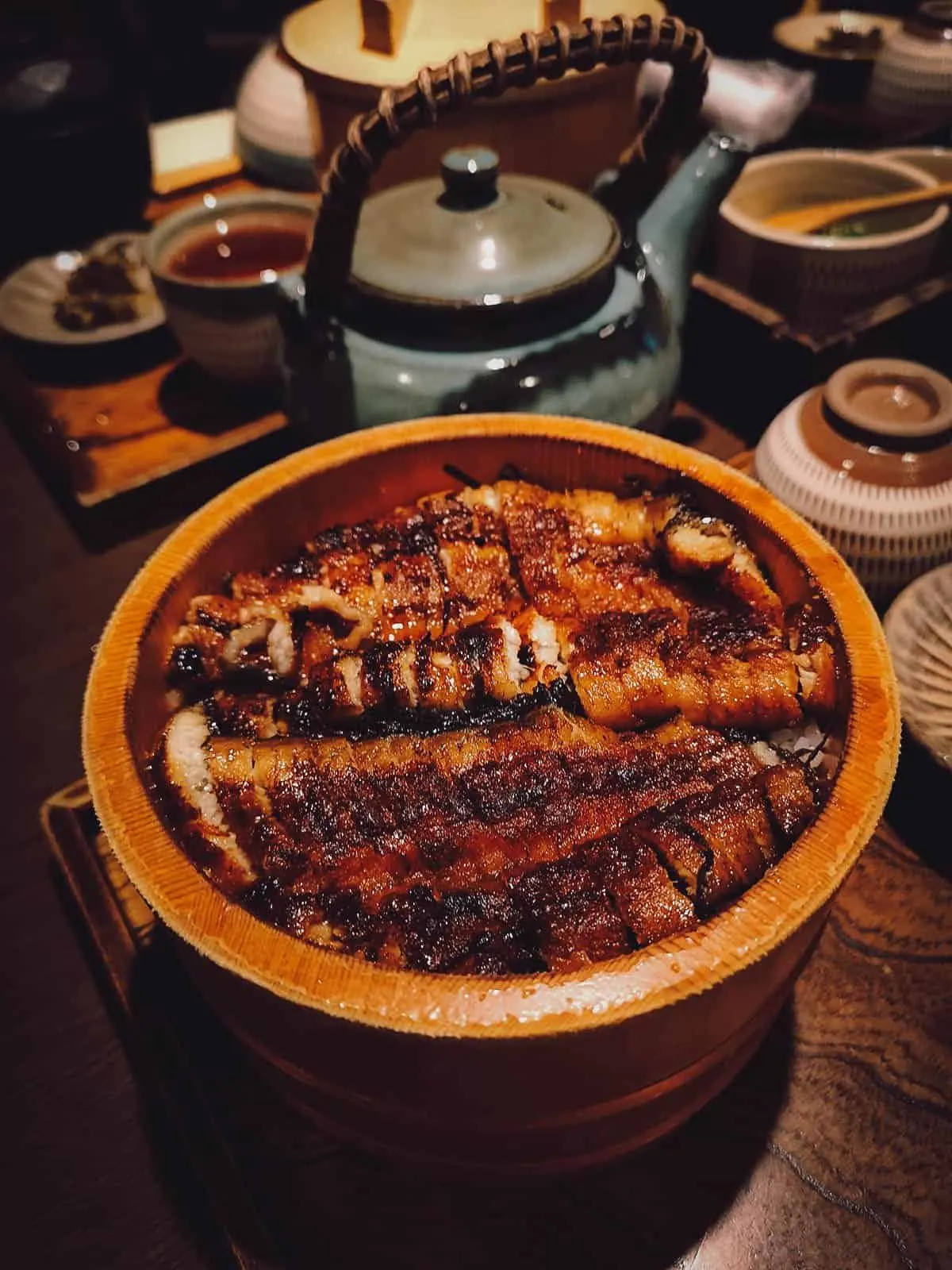
6. Wagyu
The term wagyu refers to any of the four Japanese breeds of cattle – namely Japanese Black, Japanese Brown, Japanese Polled, and Japanese Shorthorn.
Any beef produced from these four breeds of cattle is known as wagyu, However, not all types of wagyu are equal. The most desired wagyu comes from Japanese cattle that’s genetically predisposed to intense marbling, like the Tajima strain of cattle raised in Hyogo. You’ve probably heard of it as Kobe Beef.
Wagyu in Japan is branded according to where it was raised, so Kobe Beef means it came from Kobe, Aso Beef means it came from Aso, and so on and so forth.
Kobe is the most famous but other top wagyu brands in Japan include Matsusaka, Saga, Ohmi, and Hida. Try any of these wagyu brands and you’ll never think of beef in the same way again. They’re so incredibly tender they practically dissolve in your mouth.
Pictured below are the most tender slices of Kobe Beef yakiniku at Tsurugyu, one of our favorite restaurants in Osaka.
RECIPE: Wagyu steak don
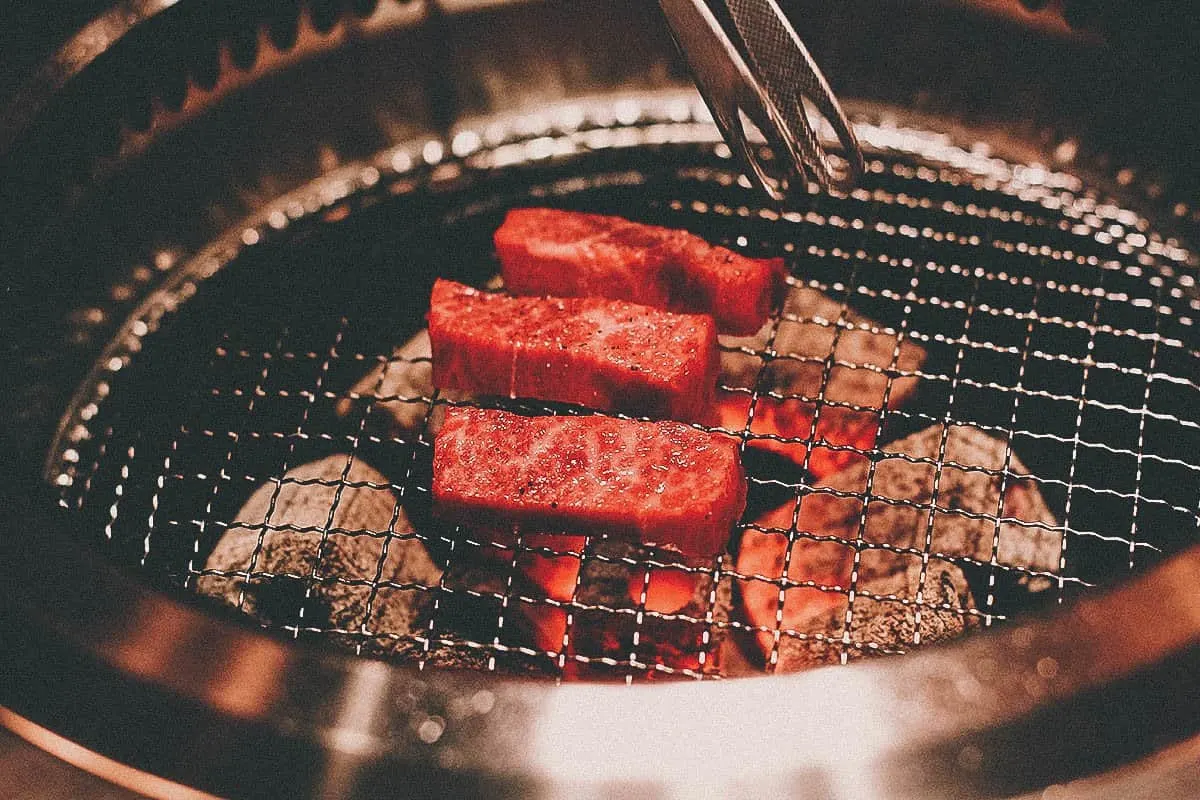
7. Kushiyaki / Yakitori
Many non-Japanese have probably heard of the term “yakitori”, but not “kushiyaki”. Both refer to skewers of grilled meat popular at izakayas or informal Japanese gastropubs. Like oden, it’s one of the most popular bar foods in Japan.
Strictly speaking, yakitori refers specifically to skewered and charcoal-grilled chicken, though it’s often used to describe skewered meat in general, both poultry and non-poultry.
The proper blanket term to describe all types of skewered grilled meat in Japan is kushiyaki. Different types of meat and vegetables are skewered on bamboo or metal sticks before being grilled over charcoal and seasoned with a tare sauce. It’s one of the best Japanese dishes you can have with beer.
RECIPE: Yakitori
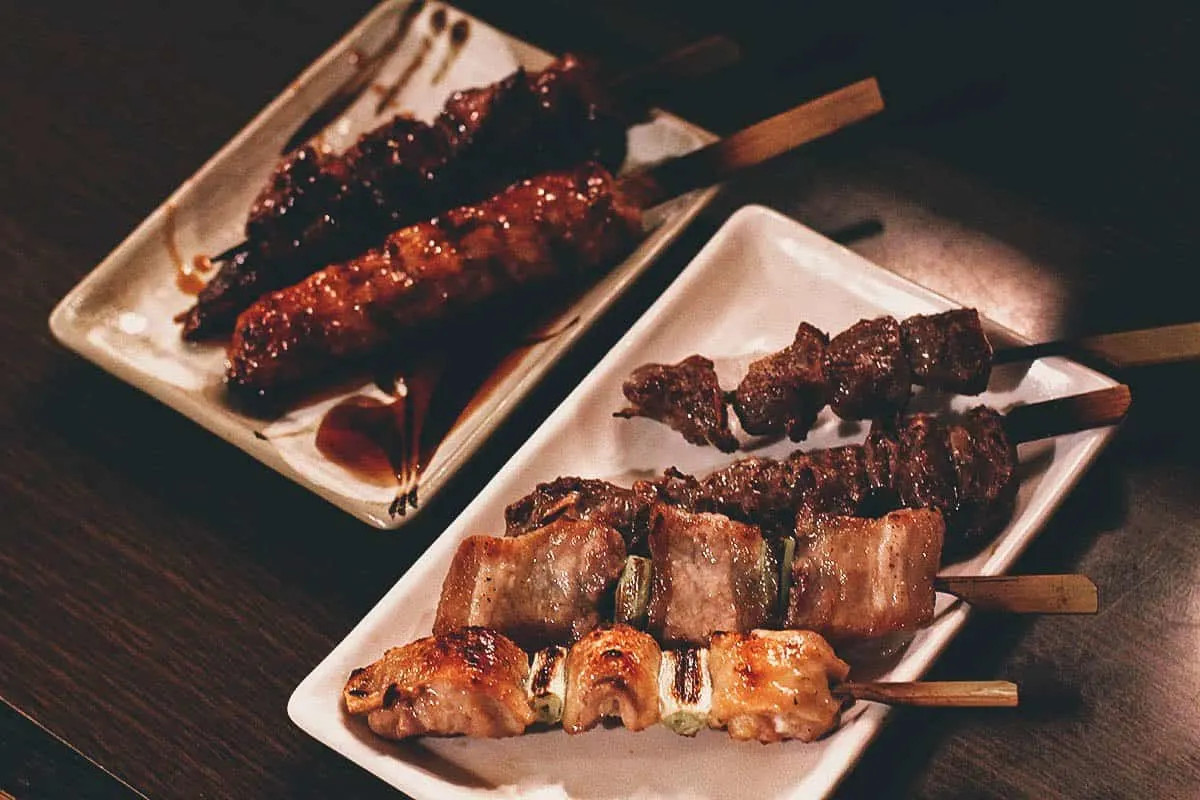
8. Takoyaki
Takoyaki is an Osaka food favorite. It refers to a ball-shaped snack made from wheat flour batter filled with minced or diced octopus, tempura scraps, pickled ginger, and green onions. It’s usually topped with a sweet and savory takoyaki sauce, Japanese mayo, green laver, and bonito fish flakes.
Like okonomiyaki, takoyaki is one of the best dishes you can have when you visit Osaka.
RECIPE: Takoyaki
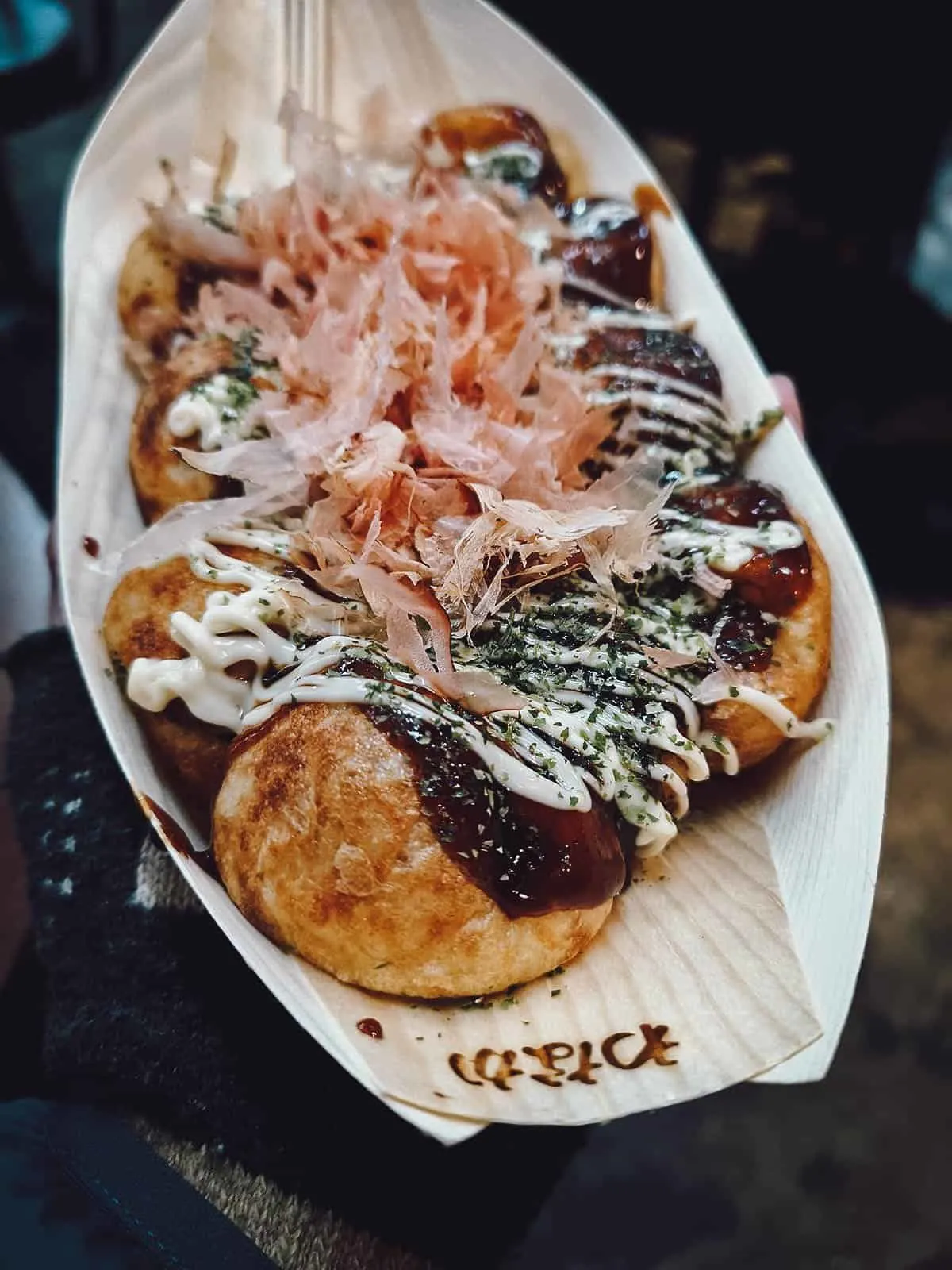
9. Okonomiyaki
Okonomiyaki refers to a Japanese sweet-savory pancake dish made with a batter of flour, eggs, dashi, and shredded cabbage mixed with ingredients like pork belly, vegetables, shrimp, squid, and other seafood.
The batter and fillings are pan-fried on both sides then finished with a variety of toppings like a sweet and savory brown sauce, Japanese mayo, dried seaweed, and bonito fish flakes.
Okonomiyaki is one of the most popular Japanese foods. It’s widely available throughout Japan but it’s most closely associated with Osaka and Hiroshima. Pictured below is an Osaka version of okonomiyaki.
RECIPE: Okonomiyaki
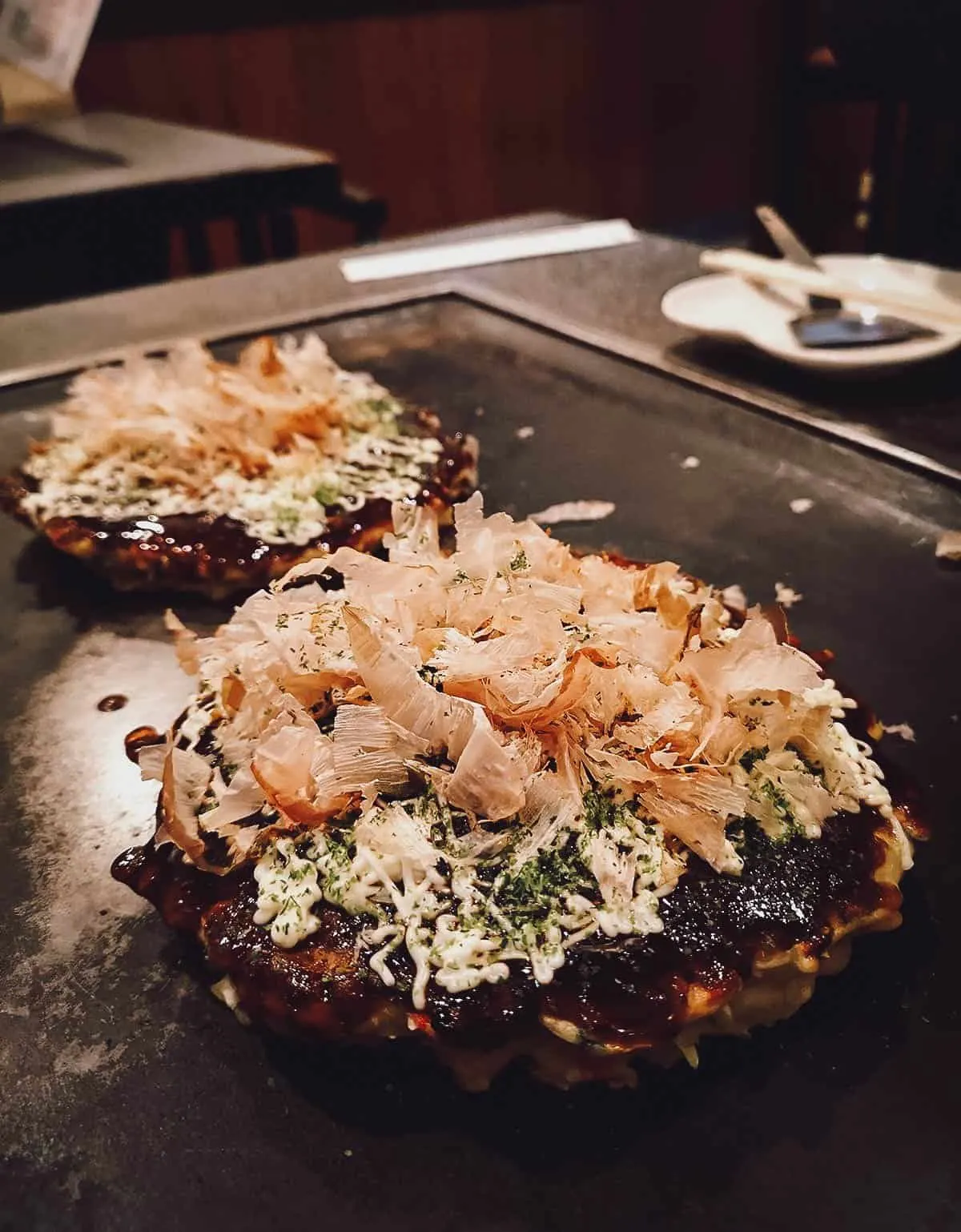
This is what a Hiroshima-style okonomiyaki looks like. Both versions use similar ingredients but they differ in how they’re prepared.
In Osaka, the fillings are mixed into the batter before being cooked on the grill. In Hiroshima, the ingredients are layered one at a time instead of being mixed together.
Like in Osaka, okonomiyaki is a quintessential Hiroshima food and something you need to try when you visit Hiroshima.
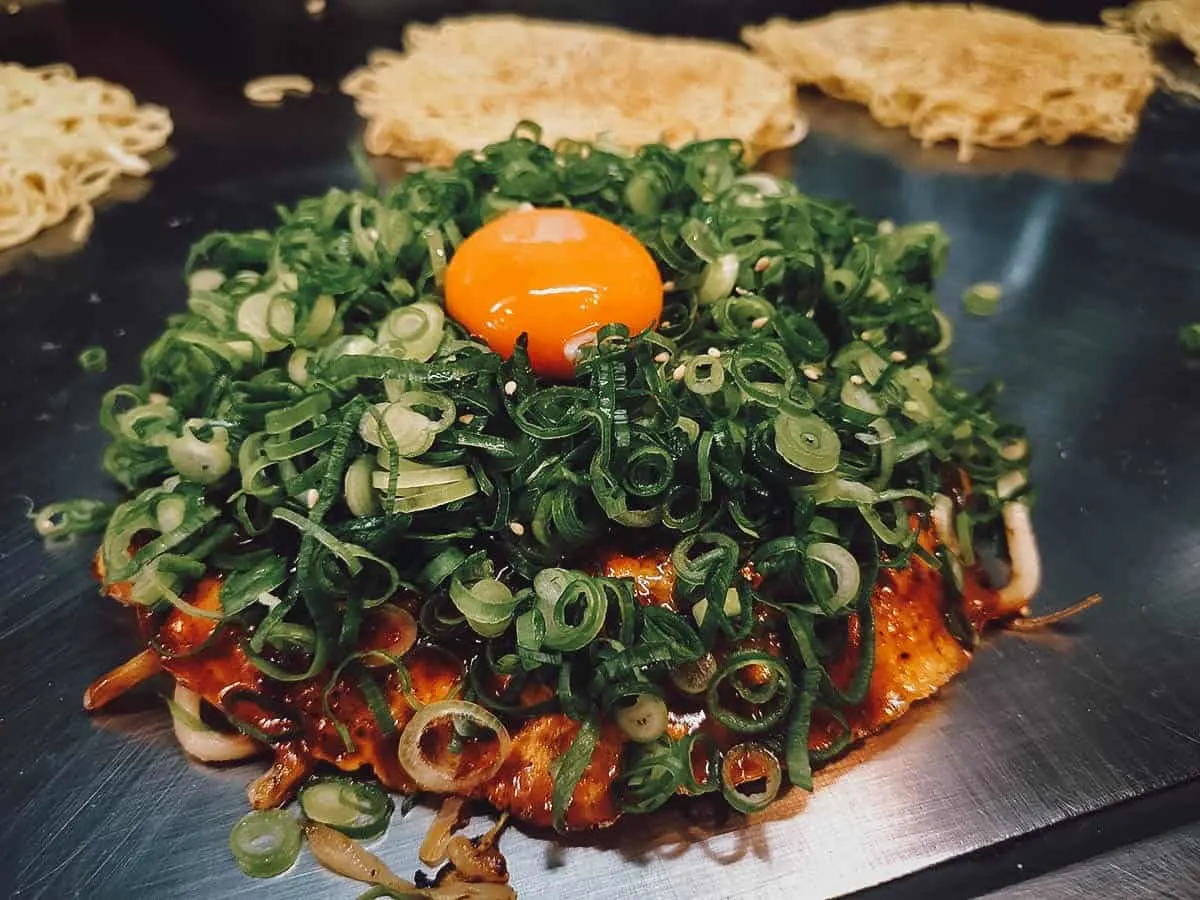
10. Miso Soup
Miso soup is a traditional Japanese soup made with dashi, miso paste, and any number of optional ingredients like vegetables, tofu, abura-age (deep-fried tofu pouches), fish, and seafood. It’s a Japanese food staple that’s served with many set meals in Japan.
Personally, miso soup is my favorite dish to eat at the end of a Japanese meal. I prefer it over anything, even dessert. Not only is it delicious, but it’s good for you as well. It’s made with fermented soybeans which is considered a type of health food in Japan.
RECIPE: Miso soup
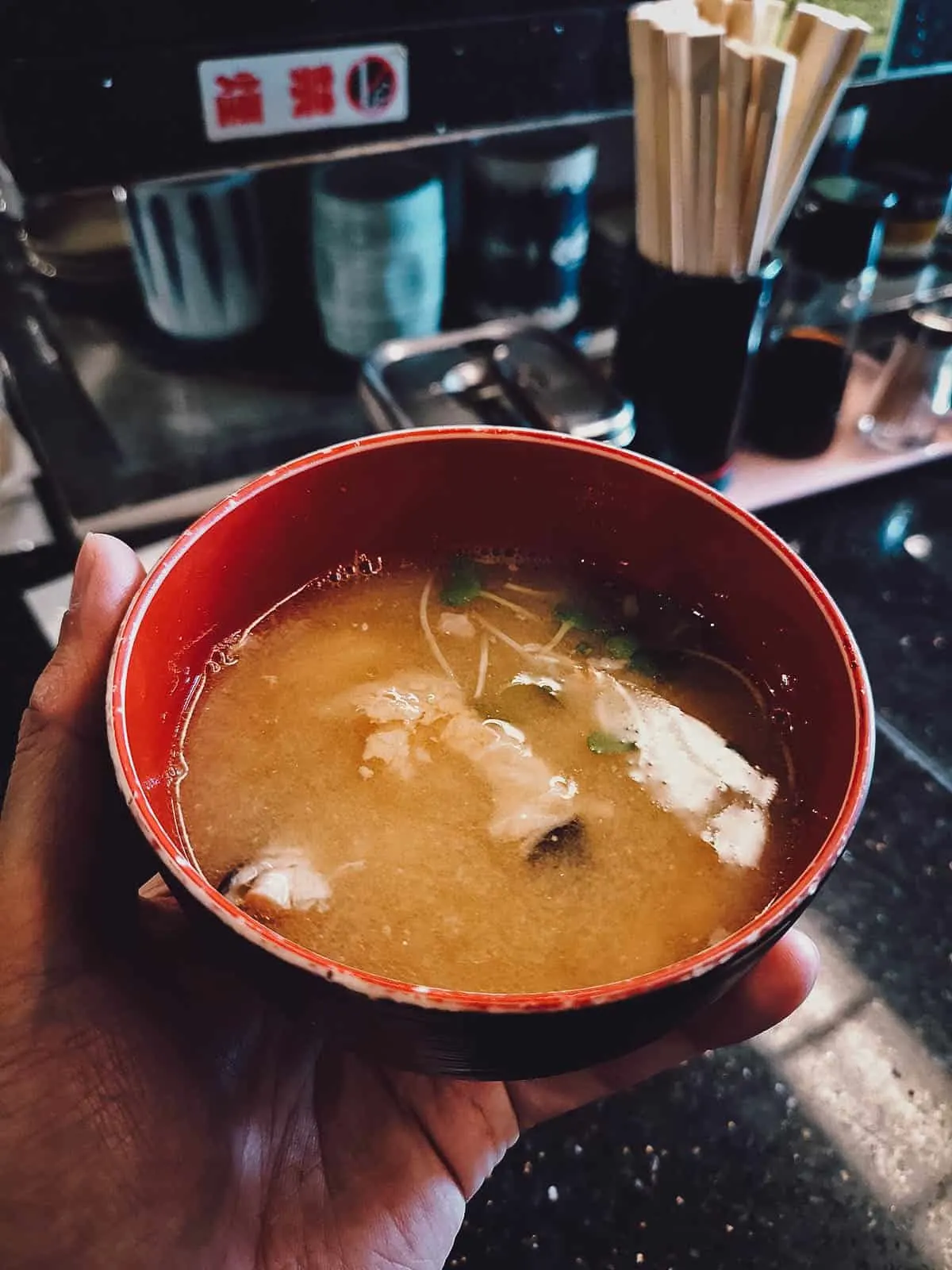
JAPANESE FISH / SEAFOOD DISHES
11. Kaisendon
Kaisen is the Japanese word for “seafood” while donburi translates to “rice bowl”, so kaisendon literally means “seafood rice bowl”. It refers to a family of Japanese dishes made with raw fish and seafood sashimi topped over unseasoned white rice.
Kaisendon isn’t to be confused with a similar-looking dish called chirashizushi. At first glance, both dishes look the same but chirashi is topped over vinegared sushi rice while kaisendon is made with plain steamed rice.
You can find kaisendon at markets and restaurants in Japan that offer fresh fish and seafood. I had this overflowing bowl at Takinami Shokudo in Hokkaido.
RECIPE: Kaisendon
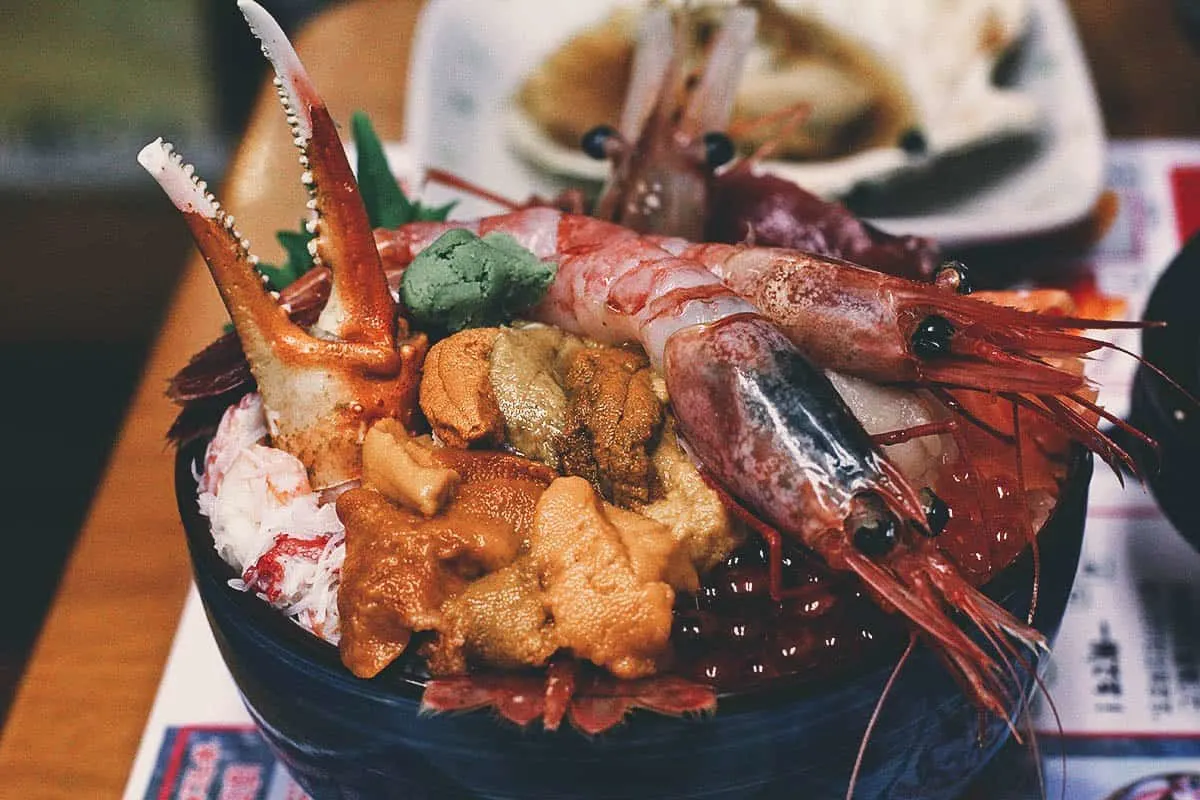
12. Anago Meshi
Anago meshi is a very similar dish to unagi donburi, but instead of freshwater eel, it’s made with anago which is saltwater or conger eel.
Compared to unagi, anago is softer in texture and glazed with a sauce that isn’t as sweet as kabayaki sauce. It’s more subtle in flavor and not quite as oily.
Anago is often used as an ingredient for sushi but anago meshi is considered a specialty dish of Hiroshima prefecture.
RECIPE: Anago meshi
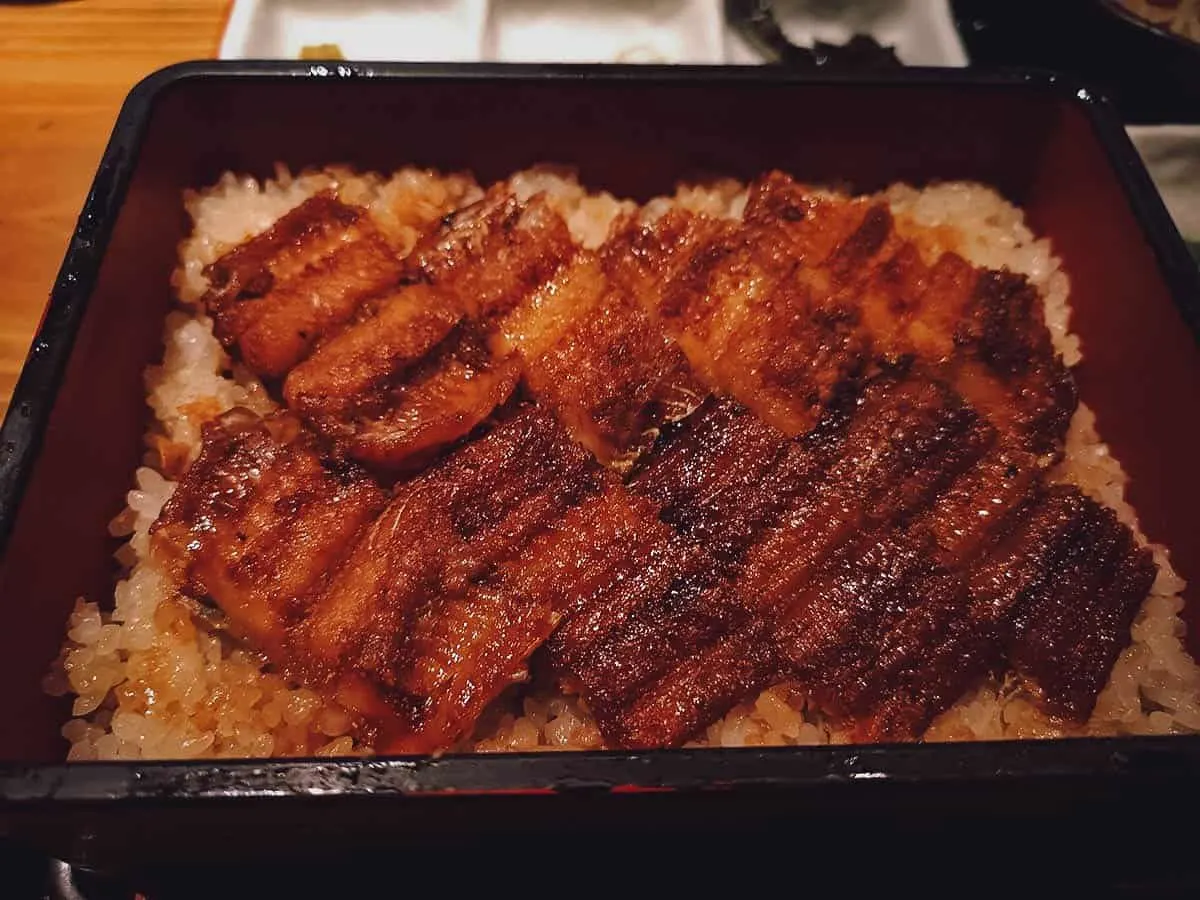
13. Zuke
Zuke refers to an old Japanese method of preserving raw fish by soaking fish fillets in a soy sauce mixture. It was a technique long forgotten since the onset of refrigeration but has seen a resurgence in recent decades as a method of food preparation in Japan.
Today, thinly sliced fillets of raw fish are marinated in the zuke method not for preservation, but for flavor. We had this delicious bowl of maguro and shake zuke (tuna and salmon) at a restaurant in Nagasaki.
RECIPE: Tuna zuke
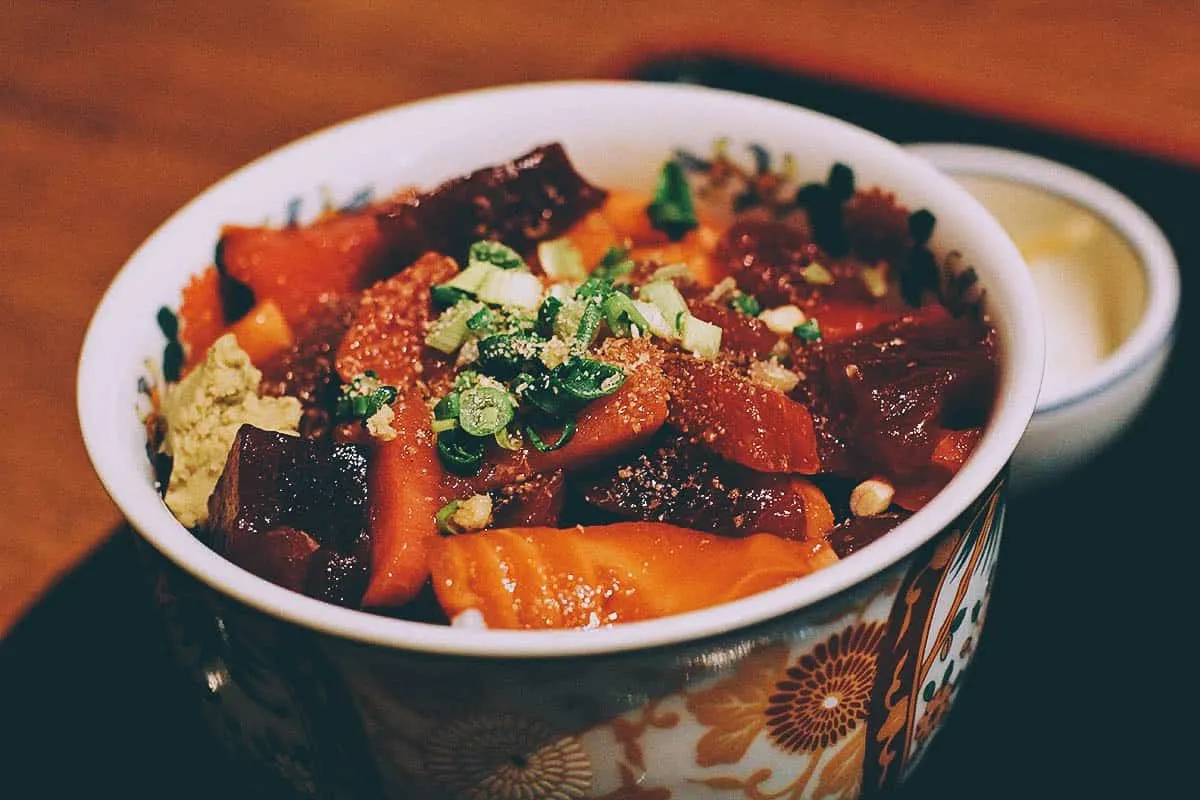
14. Tako Tamago
Tako tamago refers to these glazed baby octopuses stuffed with whole quail eggs. They’re skewered on sticks and commonly sold as street food in Japan.
Tako tamago seems to have originated at Nishiki Market in Kyoto but you can find them at similar food markets throughout the Kansai region. This picture was taken at Kuromon Ichiba Market in Osaka.
RECIPE: Tako tamago
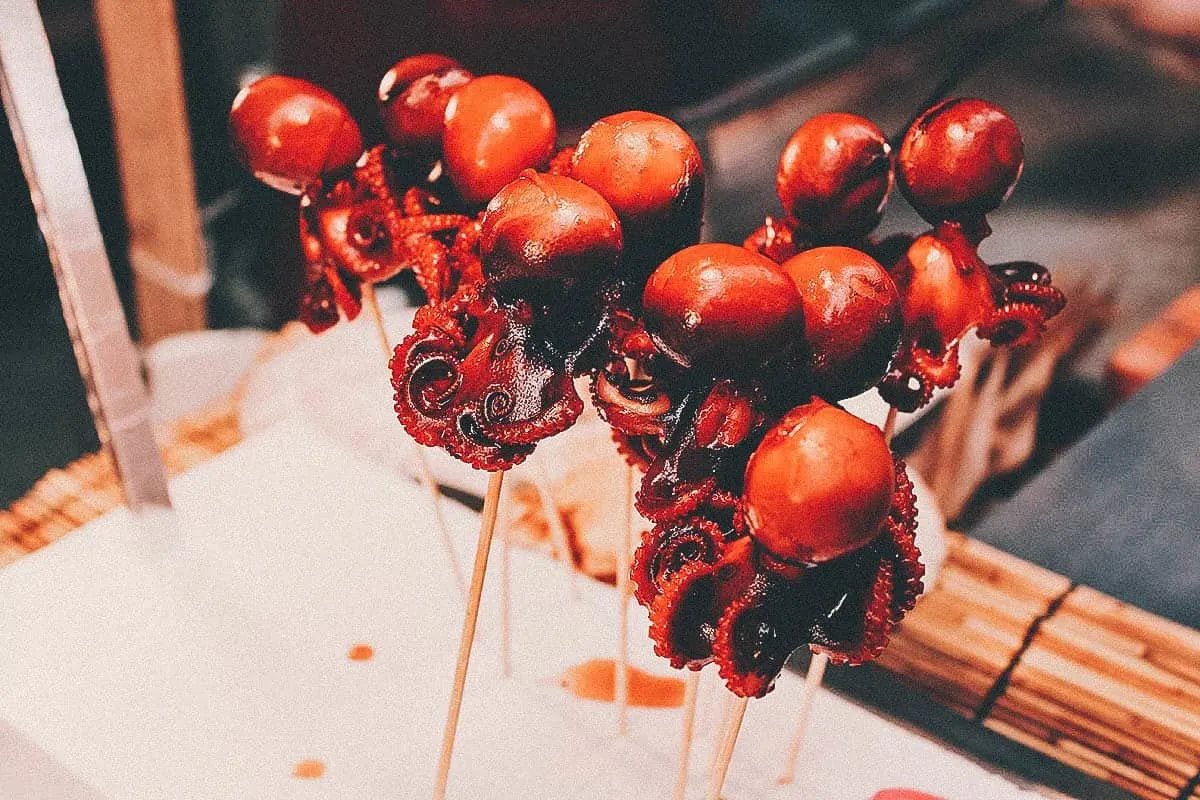
15. Fukagawa Meshi
Fukagawa meshi refers to a Tokyo food specialty of clam and long onion cooked in miso then topped over rice. It’s named after the area in Tokyo where it was invented – Fukagawa.
During Japan’s Edo period, Fukagawa was a fishing town and the people who lived there earned a living by catching fish, gathering clams, or harvesting laver. This dish was invented during that time and is still enjoyed to this day.
RECIPE: Fukagawa meshi
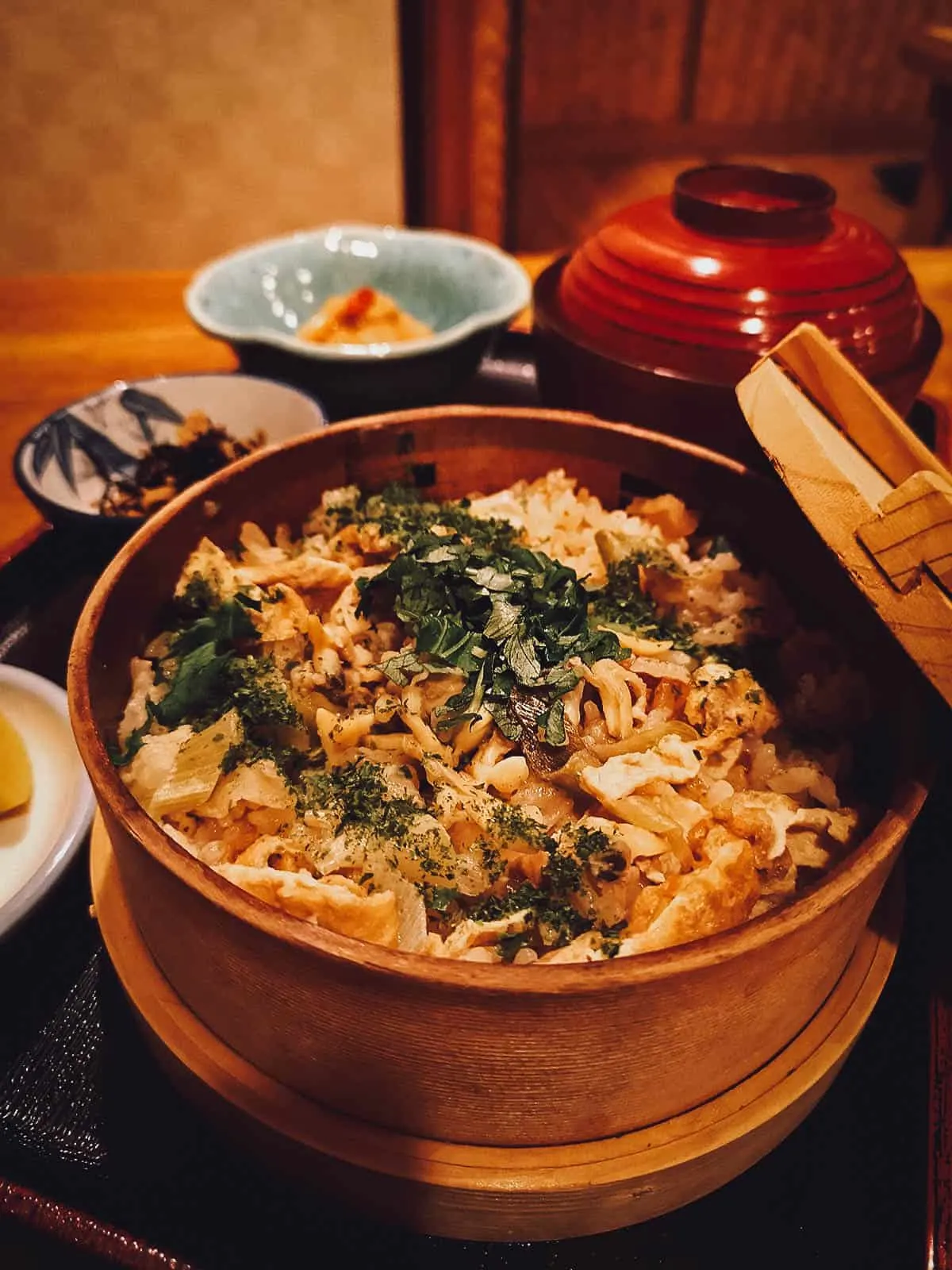
16. Fugu
Fugu is the Japanese word for pufferfish. It’s a highly toxic fish containing a powerful neurotoxin about 1,200 times stronger than cyanide.
So dangerous is this fish that the preparation of fugu in Japan is strictly controlled by law. Only qualified chefs with three or more years of rigorous training are allowed to prepare the fish. Even then, it’s said that it takes a minimum of ten years of apprenticeship to be a proper fugu chef in Japan.
Fugu can be prepared a number of ways but it’s most usually served as sushi or sashimi or in a winter hot pot dish known as fugu chirinabe. It’s said that the liver is the tastiest part, but it also happens to be the most poisonous so serving liver in Japanese restaurants has been banned since 1984.
We tried fugu at Zuboraya, one of the most recognizable but touristy restaurants in Osaka. If you’re serious about trying the best fugu in Japan, then it’s best to make a trip to Yamaguchi.
The city of Shimonoseki in Yamaguchi is the largest harvester of pufferfish in Japan and is nicknamed the country’s “Fugu Capital”.
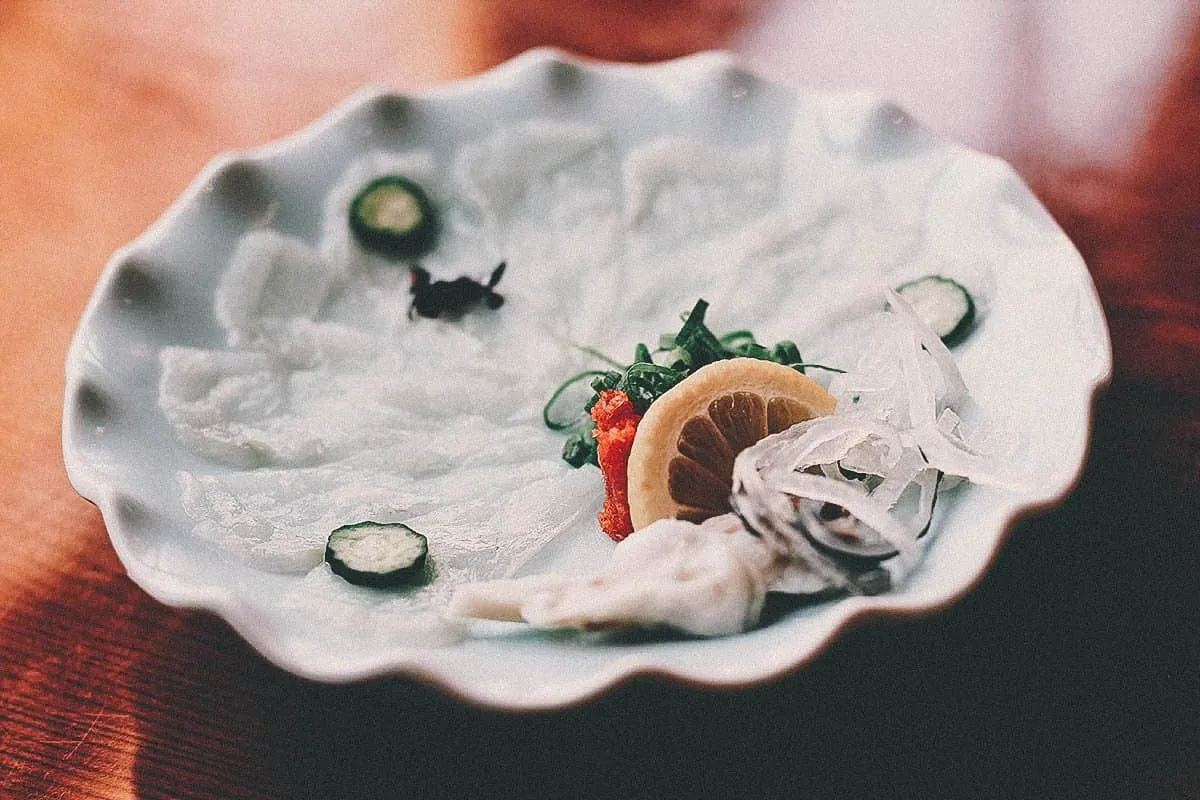
17. Crab
Japan’s love for crab is legendary. The crab consumption in Japan ranks among the highest in the world and their love for it reaches fever pitch in winter.
Typically eaten in the colder months, crab is the quintessential winter dish in Japan. You can find crab throughout Japan but one of the best places to have it is in Hokkaido.
We were in Sapporo for the Sapporo Snow Festival and Nijo Market and Sankaku Market in Otaru were practically drowning in several types of crab – king, snow, hairy, and thorny.
RECIPE: BBQ king crab
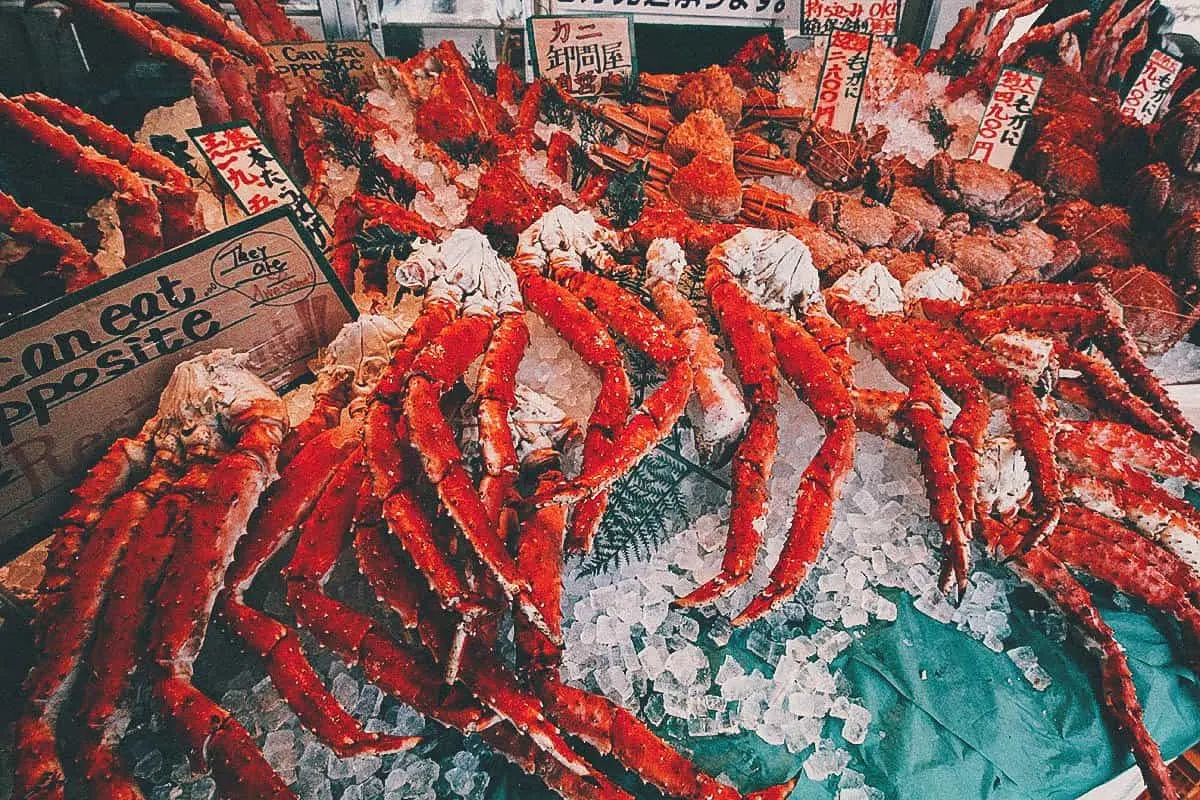
Hokkaido may be home to some of the best crab in Japan but northern Hyogo is a haven for crabs as well. It’s home to the prized Matsuba Crab, a term given to male snow crabs caught from the Sea of Japan.
What sets Matsuba Crab apart from other snow crabs in Japan is the plankton-rich environment where it lives. This results in crabmeat loaded with flavor.
So prized is Matsuba Crab in Japan that the Japanese make trips to Tottori, northern Kyoto, and northern Hyogo in winter just to feast on this delectable crustacean.
I went to Kinoaski Onsen and found many vendors and restaurants offering Matsuba Crab. I tried it at a minshuku called Nashikisou and it was one of the best crabs I’ve ever tasted in my life, even better than the crabs in Hokkaido.
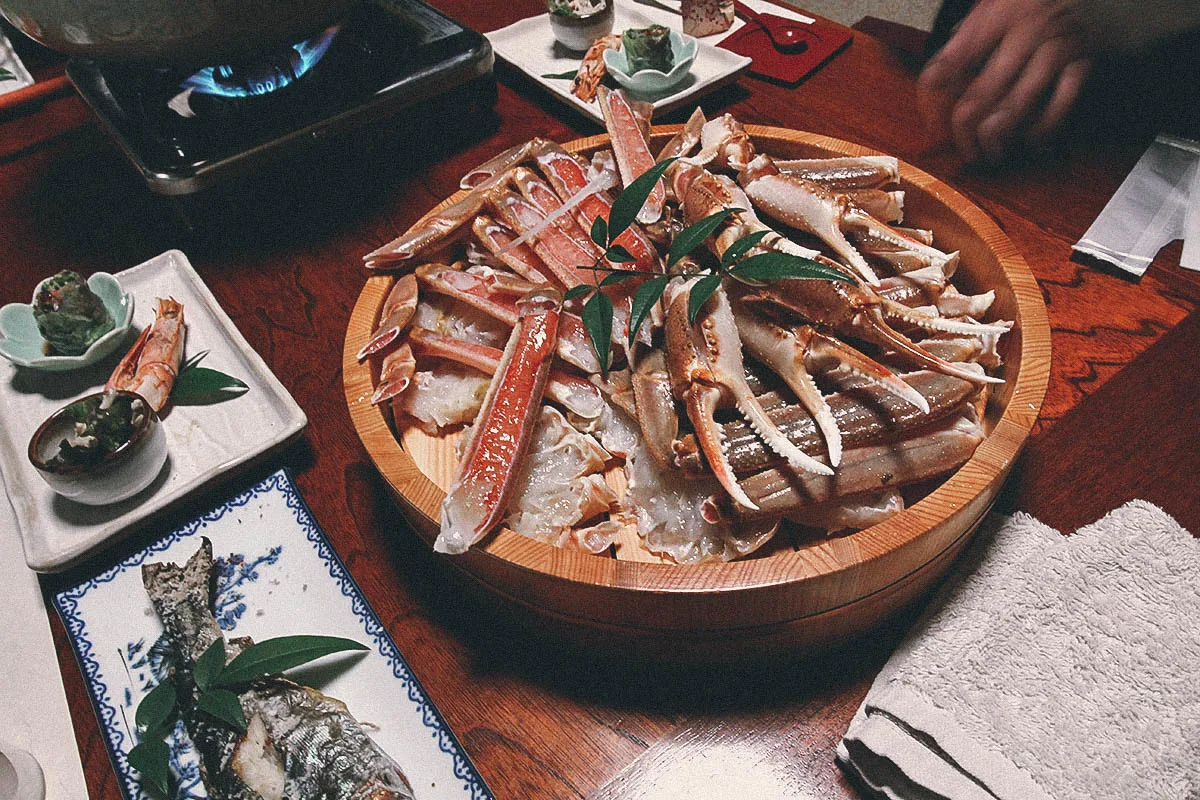
18. Oysters
Like okonomiyaki and anago meshi, oysters are a Japanese food specialty in Hiroshima. They’ve been cultivated in Hiroshima Bay for almost 500 years with the region accounting for over two-thirds of oyster production in Japan.
Hiroshima oysters are fairly large, about the size of an infant’s fist. They’re at their most plump in January and February and from March till April.
Although they can be eaten raw, oysters in Hiroshima are more often served cooked – either grilled, steamed, deep-fried, smoked, or pan-fried.
You can enjoy an oyster set like this at one of the many Japanese restaurants on Miyajima Island. It came with deep-fried breaded oysters, grilled oysters, smoked oysters, oyster miso soup, pickled oysters, and kaki meshi. Kaki meshi is a dish of oysters cooked in soy sauce and topped over rice steamed in oyster broth.
Stuffing your face with fat juicy oysters is one of the best things you can do in Hiroshima.
RECIPE: Kaki fry
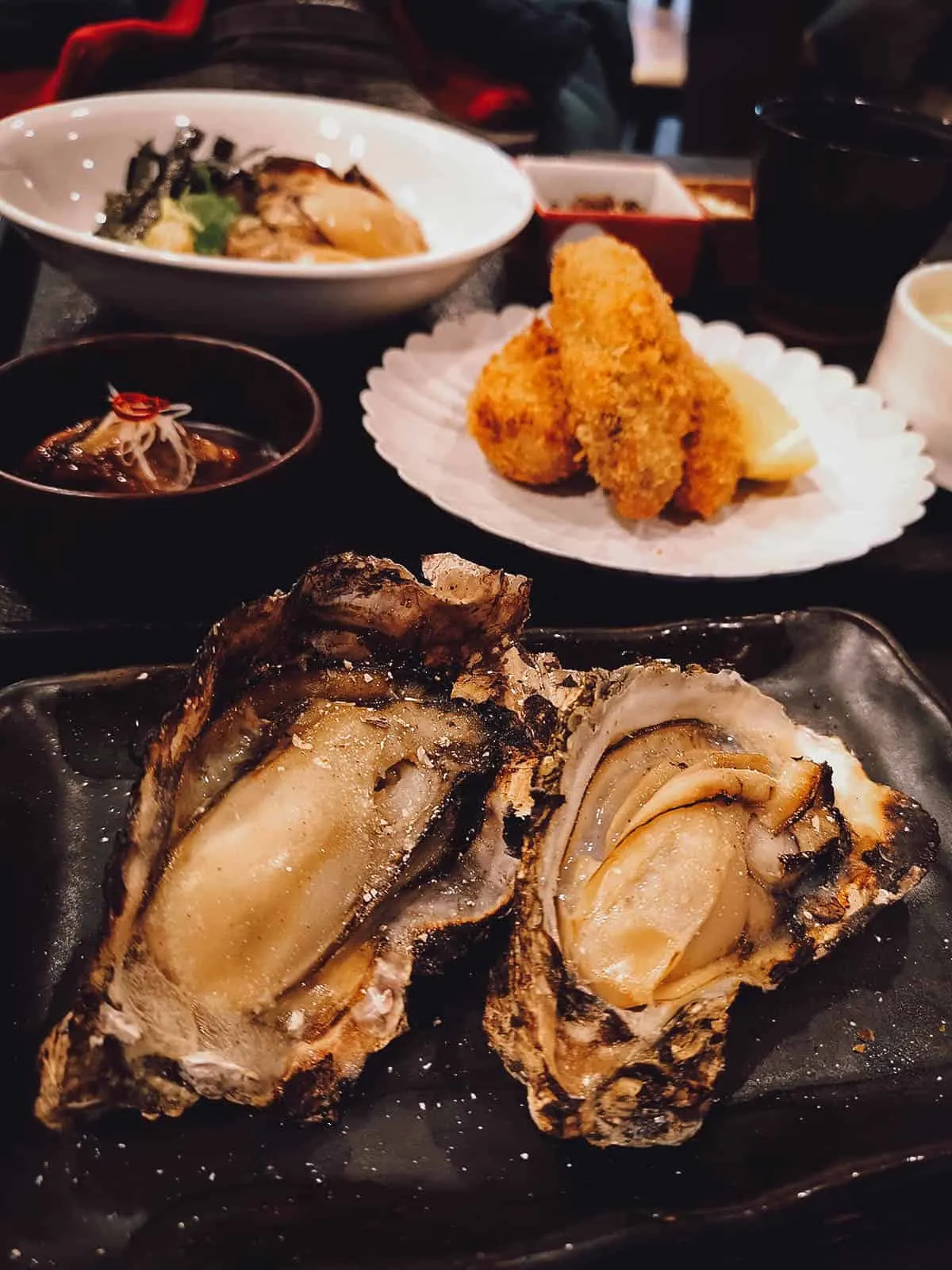
JAPANESE MEAT & POULTRY DISHES
19. Gyoza
Gyoza refers to Japanese dumplings filled with ground meat and vegetables wrapped in a thin sheet of dough. They’re originally from China but they’ve become very popular in Japan as well.
Gyoza are typically filled with ground pork, chives, garlic, ginger, sesame oil, and other ingredients. They’re usually pan-fried but they can be served steamed or deep-fried as well, either on their own or as a side dish to more substantial dishes like ramen.
RECIPE: Gyoza
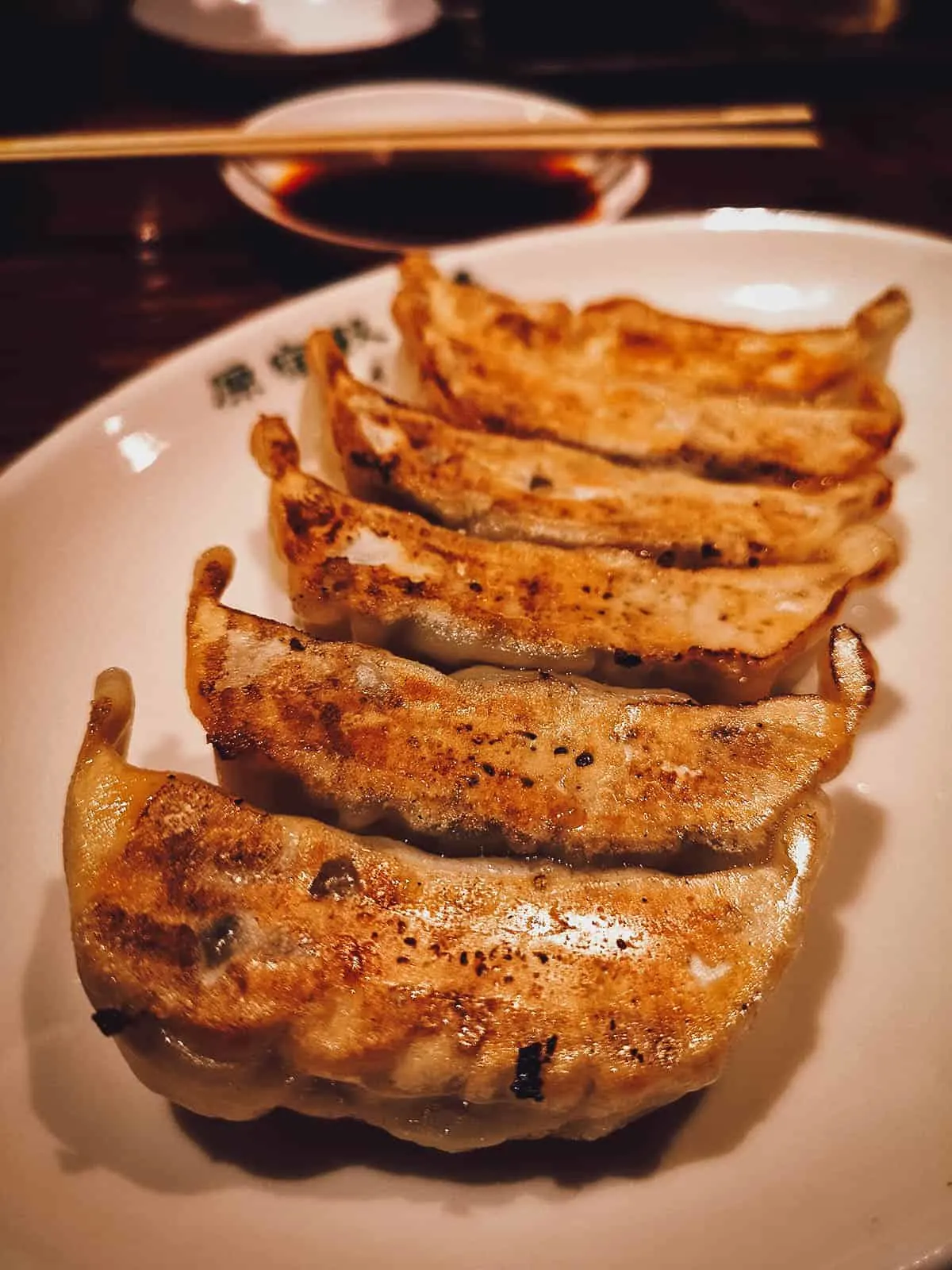
20. Karaage
Karaage is a Japanese cooking method that involves deep frying meat, poultry, or seafood in oil. Chicken karaage is most common though other types of meat and fish are also used.
Karaage is similar to tempura except the ingredients are marinated before being coated in a heavier wheat flour, potato or corn starch. This results in a thicker, crunchier coating.
RECIPE: Karaage
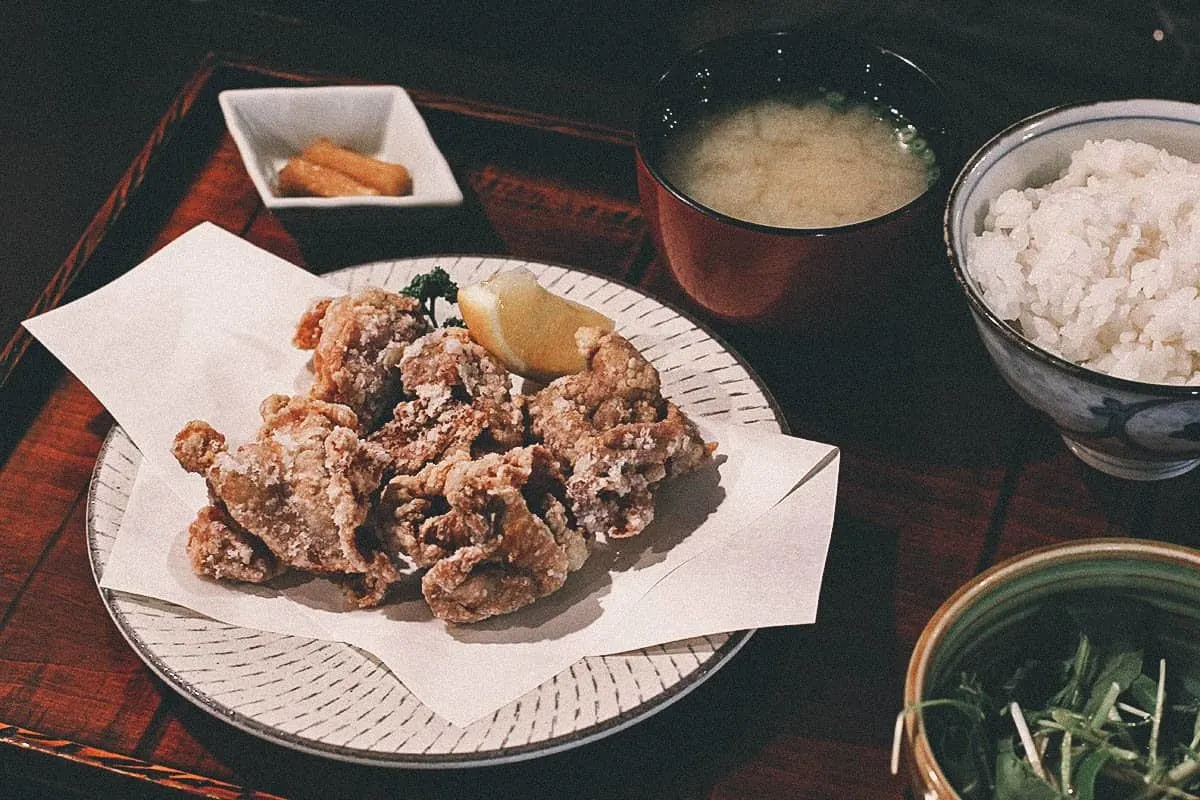
21. Japanese Curry
Curry rice is hugely popular in Japan. It was introduced to Japan by the British during the Meiji period but it wasn’t until the late 1960s that it exploded in popularity when it became widely available at supermarkets and Japanese restaurants.
Today, Japanese curry rice is considered by many to be a national dish of Japan. It’s available throughout the country and commonly served over rice, over udon, and in savory Japanese pastries.
A Japanese curry meal typically consists of curry sauce, rice, and different types of meat and vegetables like carrots, onions, and potatoes. Pork, beef, and chicken curry are the most common though it can be made with other meats as well.
Pictured below is a less common horse meat katsu curry (deep-fried breaded cutlet) from Kumamoto. We enjoyed it at Warokuya restaurant in Kurokawa Onsen. Kumamoto and Nagano are among the few prefectures in Japan known for farming horse meat.
RECIPE: Katsu curry
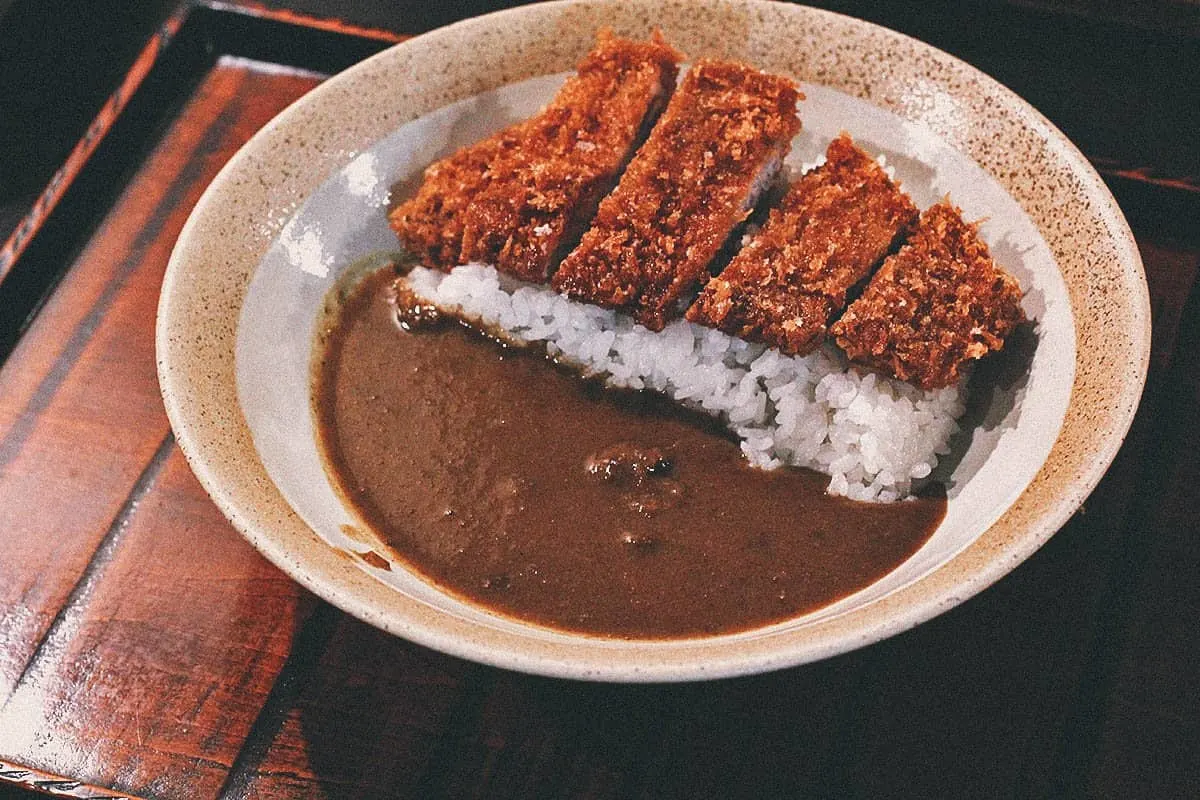
22. Korokke
Korokke is the Japanese term for croquette. It’s a breaded deep-fried patty containing meat, seafood, or vegetables mixed with mashed potato or white sauce. The patty is rolled in wheat flour, eggs, and then panko breadcrumbs before being deep-fried to a golden brown.
Korokke is widely available anywhere in Japan, even groceries and convenience stores. We had these delicious crab and octopus croquettes at a popular stand in Yufuin.
RECIPE: Korokke
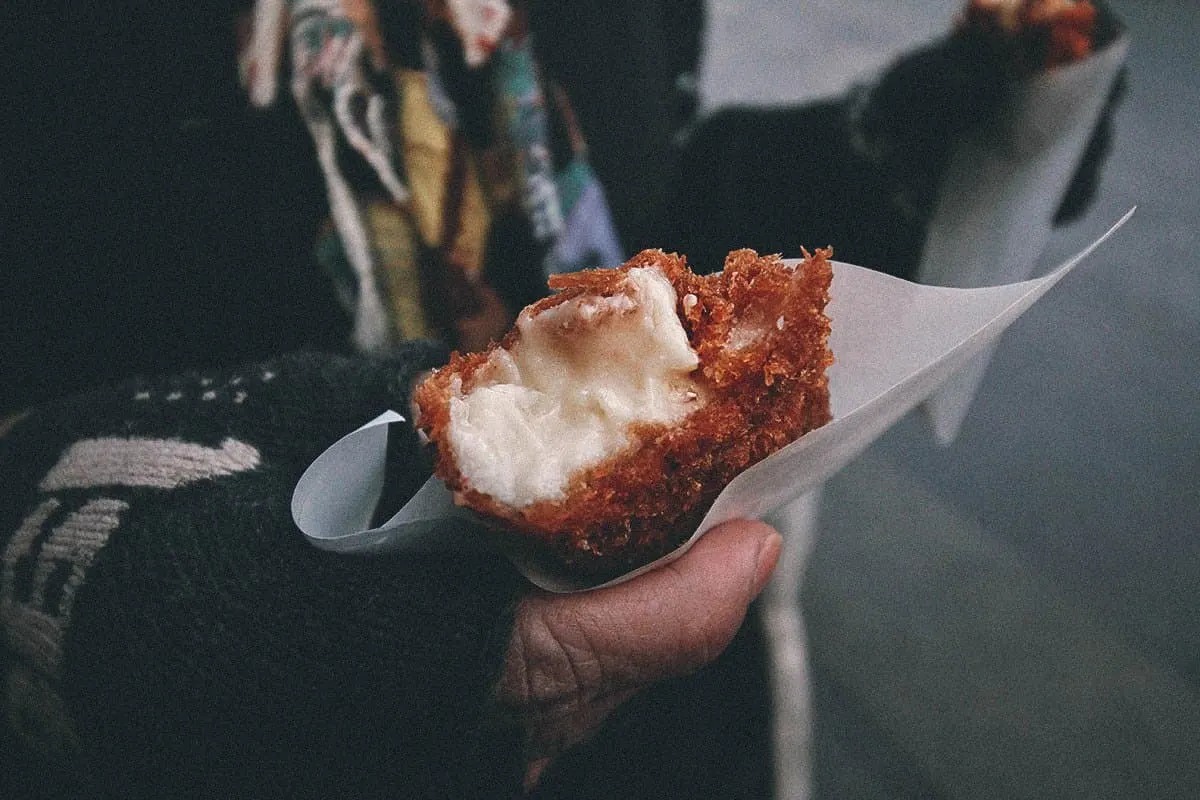
23. Yakiniku
Yakiniku technically isn’t a dish, but a Japanese style of cooking meat and vegetables on small tabletop grills. Raw meats and vegetables are brought to the table so diners can grill the food themselves.
The meats and vegetables are usually served with a tare made with any number of ingredients like soy sauce, sake, mirin, sugar, garlic, fruit juice, and sesame.
It’s interesting to note that although yakiniku is a Japanese culinary term, this style of cooking is widely considered to have Korean roots. It became widespread in Japan after WWII and is believed to be a variant of Korean bulgogi or galbi which was modified to suit Japanese tastes.
This may explain why some yakiniku restaurants in Japan serve Korean dishes like kimchi as well. I noticed this at yakiniku restaurants in Sapporo and Fukuoka.
If you’ve been to Sapporo, then you may recognize jingisukan as a specific type of yakiniku. It’s native to Hokkaido and entails the grilling of mutton or lamb meat over a convex metal skillet.
RECIPE: Yakiniku
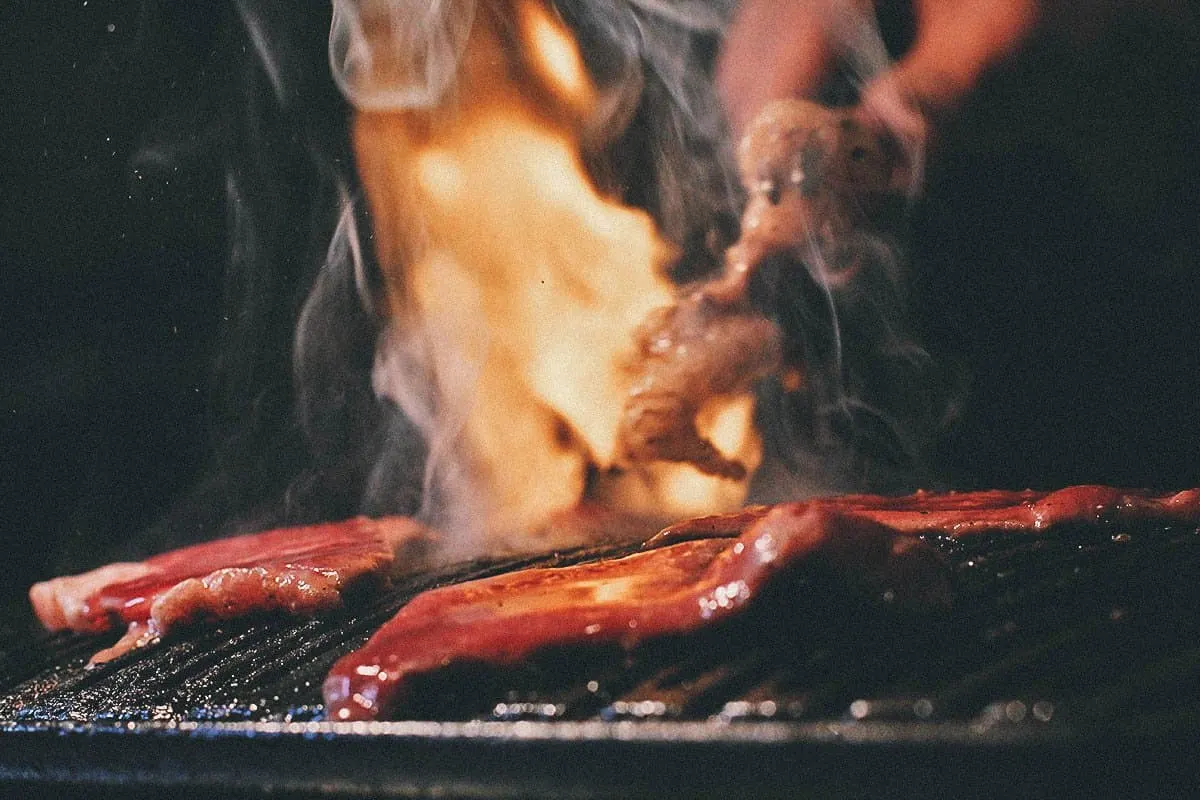
24. Miso Katsu
Miso katsu refers to a Nagoya specialty dish of pork tonkatsu served with a thick sauce made with Hatcho miso. It’s perhaps the one dish that best represents Nagoya meshi or Nagoya cuisine.
Tonkatsu refers to a breaded and deep-fried pork cutlet dish that’s very popular in Japan. It’s made with a 2-3 cm slice of pork loin or tenderloin coated with panko bread crumbs and deep-fried in oil. It’s typically served with rice, a savory-sweet tonkatsu sauce, shredded cabbage, and pickled vegetables.
Miso katsu is a Nagoya version of tonkatsu. The pork cutlet is exactly the same but what makes the dish different is the sauce.
Instead of being served with regular tonkatsu sauce made with the usual ingredients like soy sauce, ketchup, and Worcestershire sauce, the main ingredient in miso katsu sauce is Hatcho miso bean paste.
Hatcho miso is the most famous type of mame or red miso in Japan. Loaded with umami and touted to have many health benefits, it’s this red miso bean paste that gives Nagoya cuisine its distinctive flavor.
RECIPE: Miso katsu
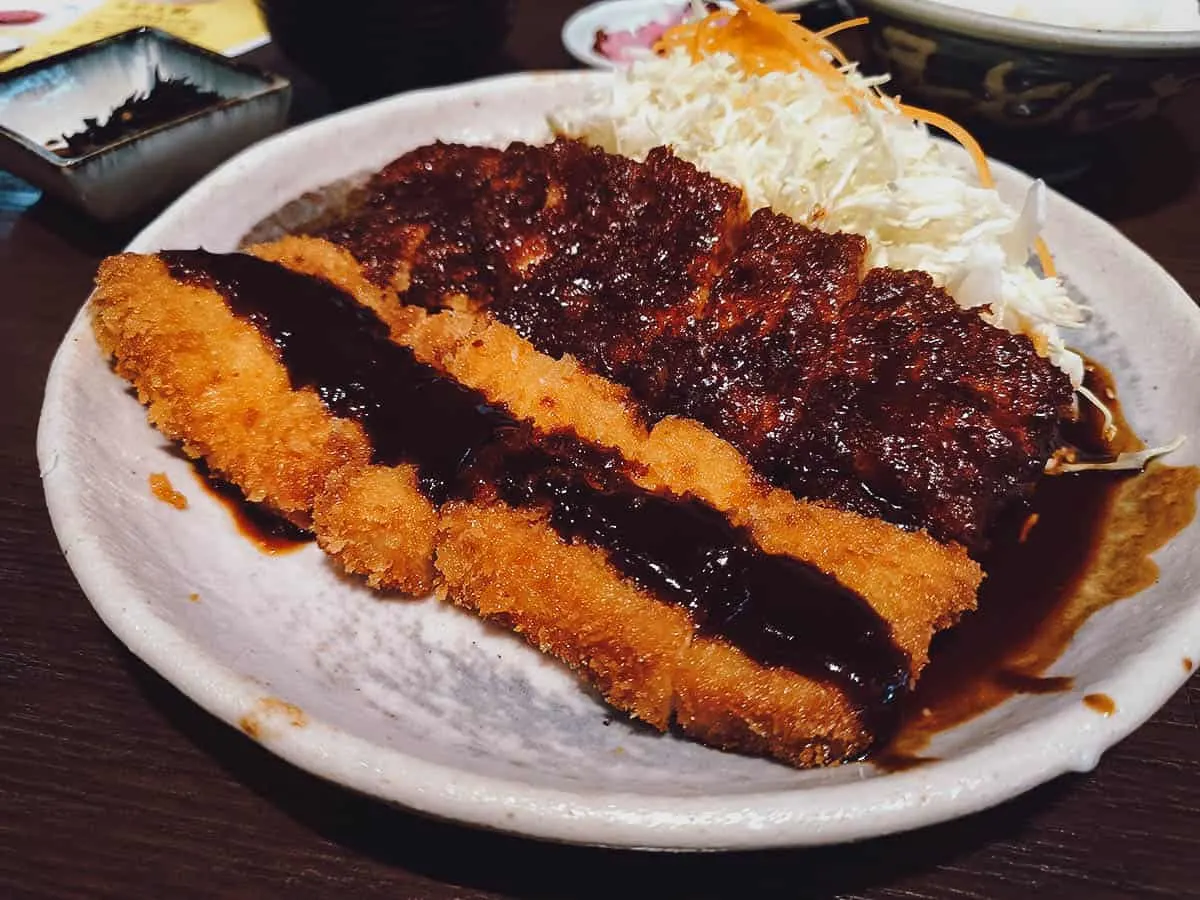
25. Motsunabe
If you like offal and hot pot, then you’re going to love this Fukuoka specialty. Motsunabe is a Japanese hot pot stew made with beef or pork offal. Beef intestines are most common though other types of offal can also be used.
Motsunabe is usually cooked in a shallow hot pot on your table. The offal is allowed to simmer for a few minutes in a soup base seasoned with soy sauce, garlic, and chili pepper. Other ingredients like cabbage, garlic chives, and champon noodles are later added to complete the dish.
Motsunabe hot pot is delicious, especially when eaten with rice. It’s one of my favorite things to do in Fukuoka. I’ve had it a few times but the best motsunabe I’ve tried was from the highly regarded Hakata Motsunabe Yamanaka Akasakaten restaurant.
RECIPE: Motsunabe
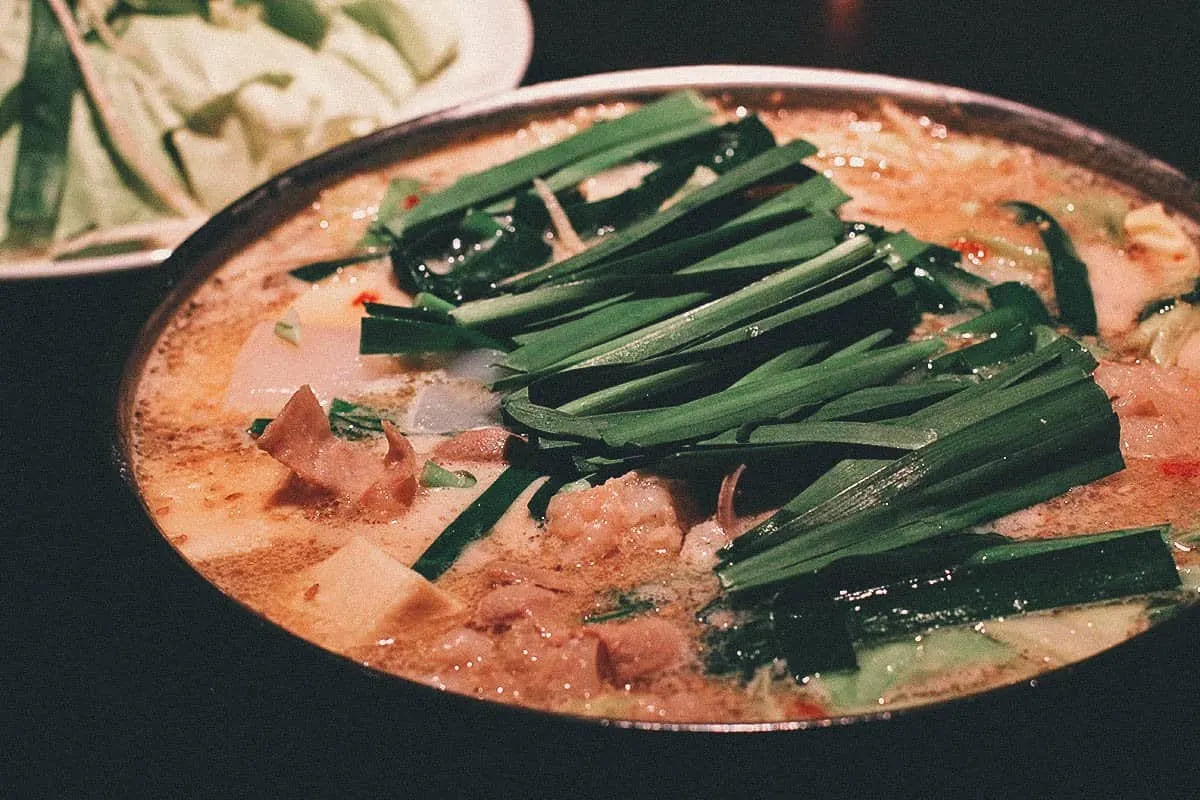
26. Jingisukan
Jingisukan (pronounced jing-giss kahn) or Genghis Khan is a mutton dish popular in Hokkaido. In typical yakiniku fashion, servers will bring the raw meat and vegetables to your table which you’ll cook yourself on a convex metal skillet over a gas stove or hot coals.
Jingisukan is rumored to have gotten its name in prewar Japan, when lamb was believed to be the meat of choice among soldiers in Mongolia. The dome-shaped metal skillet used today is meant to represent a soldier’s helmet which was allegedly used to cook food.
One of the most popular places to have jingisukan in Sapporo is the Sapporo Beer Museum.
RECIPE: Jingisukan
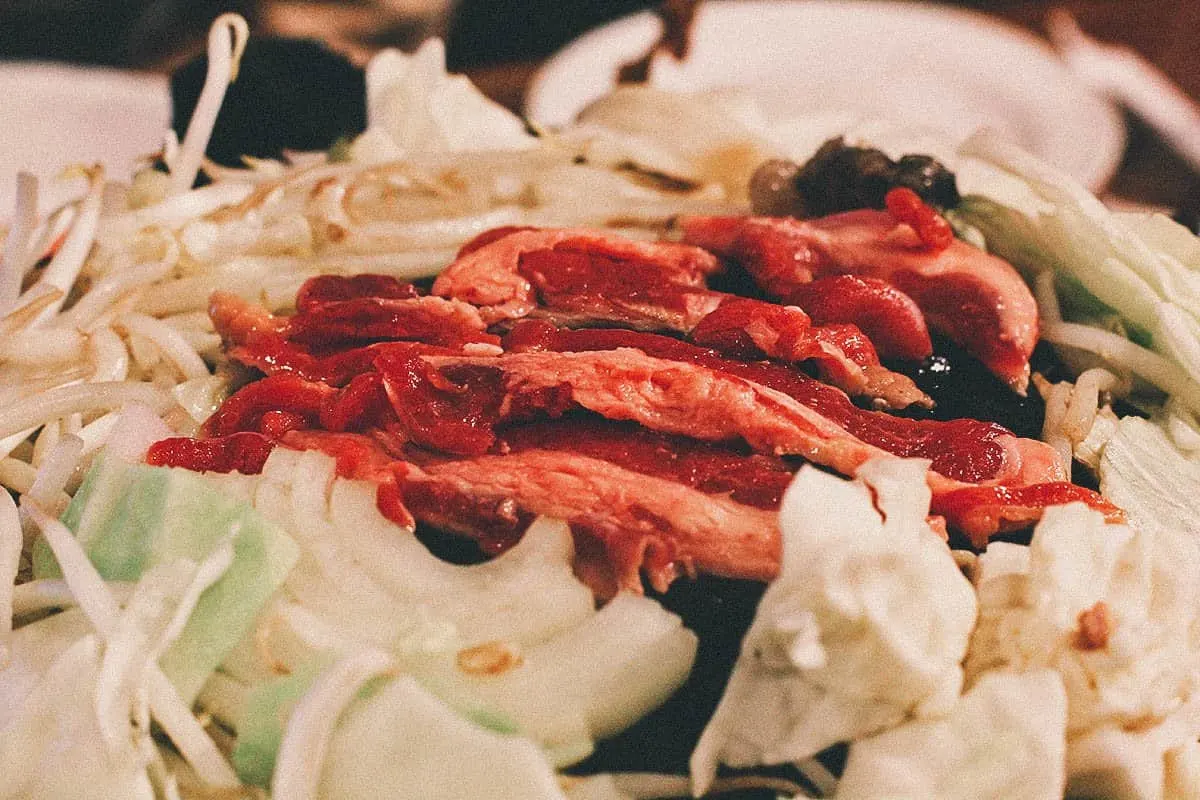
27. Basashi
Basashi refers to a Japanese dish of horse meat, specifically raw horse sashimi.
Horse meat in Japan is referred to as sakuraniku – meaning “cherry blossom meat” – because of its pinkish color. It’s a highly localized dish, a specialty in only a handful of prefectures in Japan, most notably Kumamoto and Nagano. Even for most Japanese, eating basashi is a rare occurrence.
We tried basashi at two restaurants in Kurokawa Onsen. Pretty much all the restaurants in that small onsen town was serving some form of horse meat. Aside from sushi, we had it in a croquette and in Japanese curry as well.
Kumamoto had an over-abundance of horses in the 1960s which they no longer needed for transport or agricultural work. It was around that time that the Japanese turned to horse meat as a regular food source. Today, there are horse farms and restaurants all throughout Kumamoto.
Basashi is typically served cold together with soy sauce, garlic, and wasabi. From what I understand, it’s served cold because it’s treated for bacteria and other parasites at -20°C for at least 48 hours.
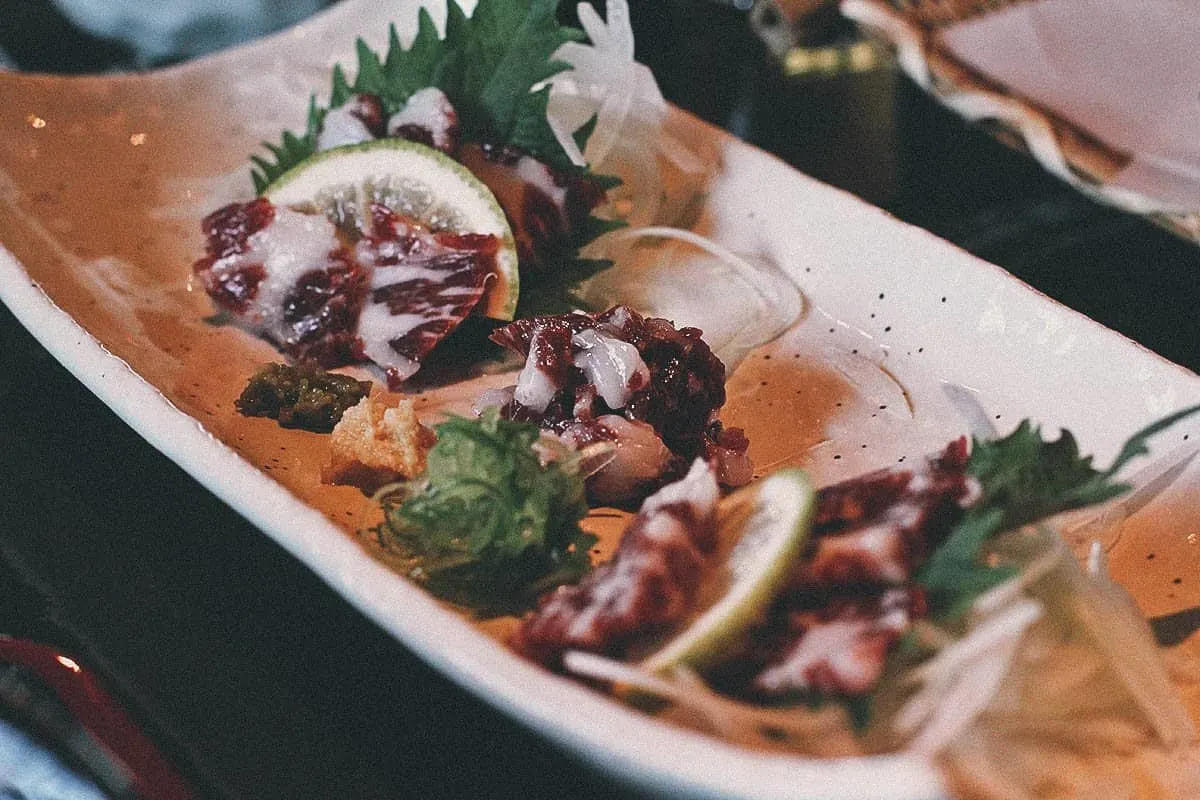
28. Hida Beef Sushi
Hida beef refers to wagyu produced from black-haired Japanese cattle raised in Gifu prefecture. Like Kobe beef, Hida beef is considered one of the most prized beef brands in Japan, revered for its intense marbling and juiciness.
Compared to Kobe beef which tends to be more balanced in its meat and fat distribution, Hida beef has more of the latter, giving you a truer melt-in-your-mouth experience.
We visted Takayama and Shirakawa-go and enjoyed Hida Beef in a variety of dishes like burgers, croquettes, rice balls, and steamed buns, but our hands down favorite was Hida Beef sushi. It really does melt in your mouth. Wow.
The thought of eating raw beef may be challenging for some but if you can get past it, then you’ll be rewarded with one of the best food experiences in Japan. Eating Hida Beef sushi really is one of the best things you can do in Takayama.
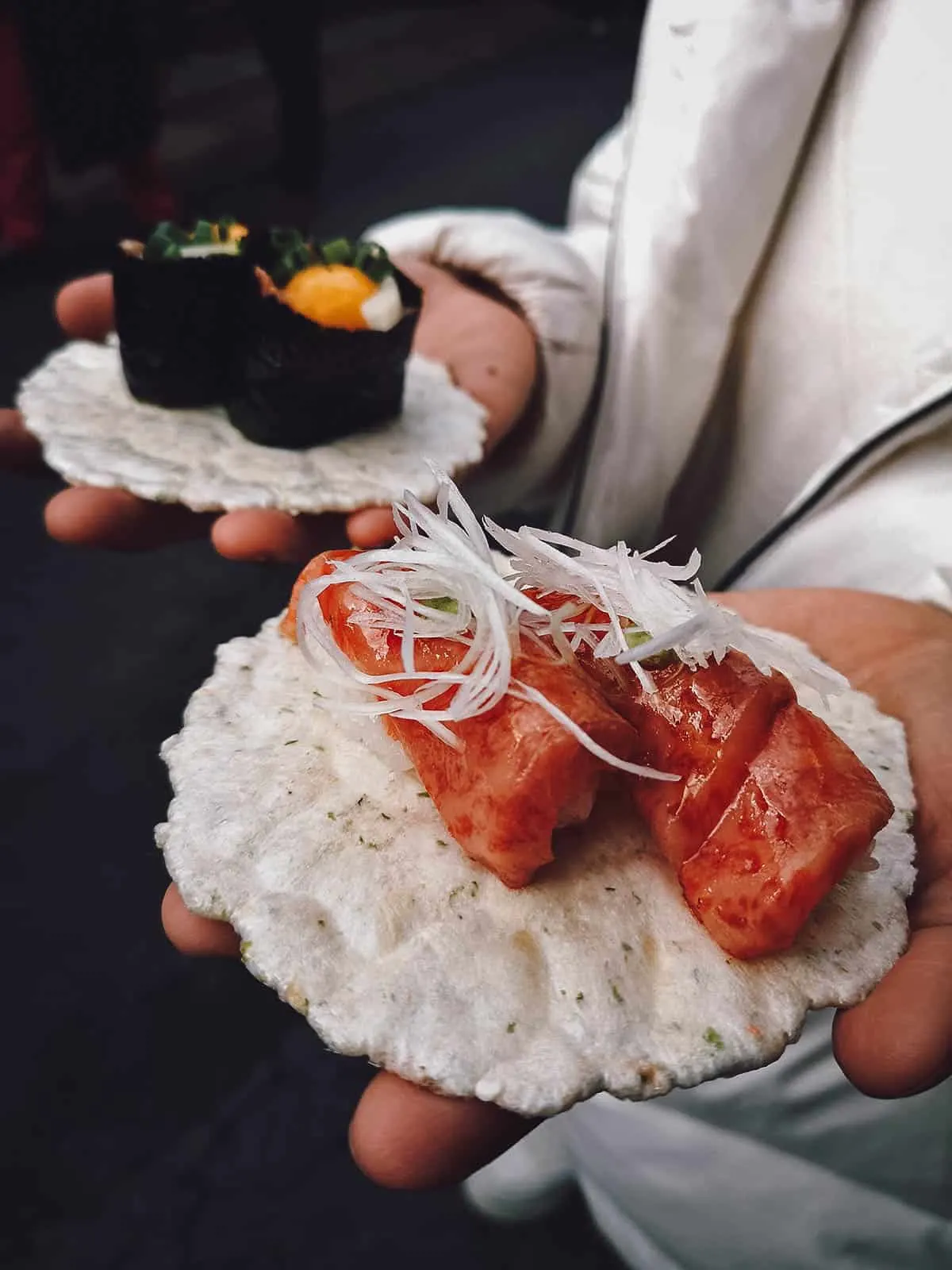
29. Kakuni Manju
Kakuni manju is a Japanese-style pork belly bun from Nagasaki. It’s basically a Japanese version of the Chinese gua bao.
The pork belly is simmered in dashi, soy sauce, mirin, sugar, and sake before being cooked for several hours over a low flame. This slow cooking process breaks the collagen down into gelatin which helps keep the meat moist while making it extremely tender.
The pork belly is then sandwiched in a soft bun – often with scallions and cucumber – and served out of bamboo steamers. You can find them pretty much anywhere in Nagasaki, especially around Chinatown.
RECIPE: Kakuni manju
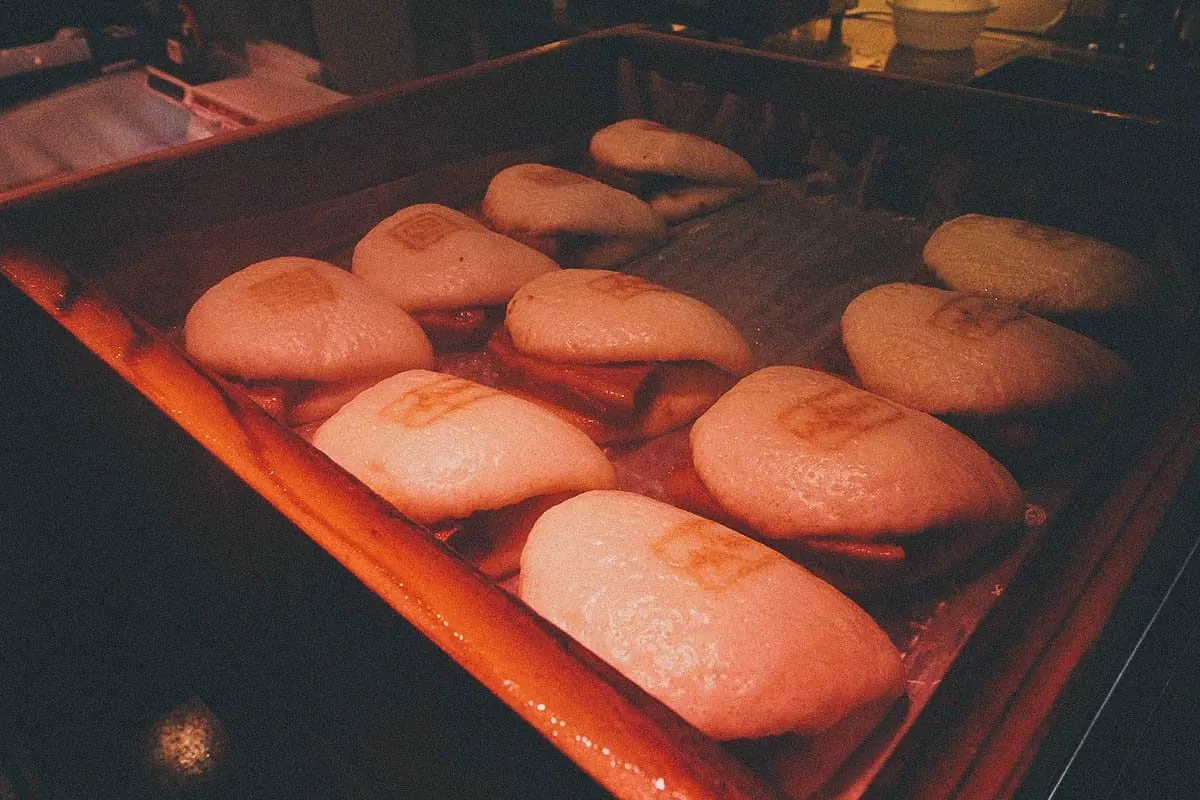
30. Tebasaki
Tebasaki refers to Japanese-style deep-fried chicken wings. They’re made with non-battered bone-in chicken wings that are double fried to achieve a supremely crisp but delicate coating.
Tebasaki is a popular Japanese dish that can be flavored with a variety of seasonings, though many izakayas will serve them coated in a sticky, savory-sweet glaze. It’s widely available throughout Japan but the dish may have its roots in Nagoya.
The best tebasaki is said to be made from Nagoya cochin, one of the most prized chicken breeds in Japan.
RECIPE: Tebasaki
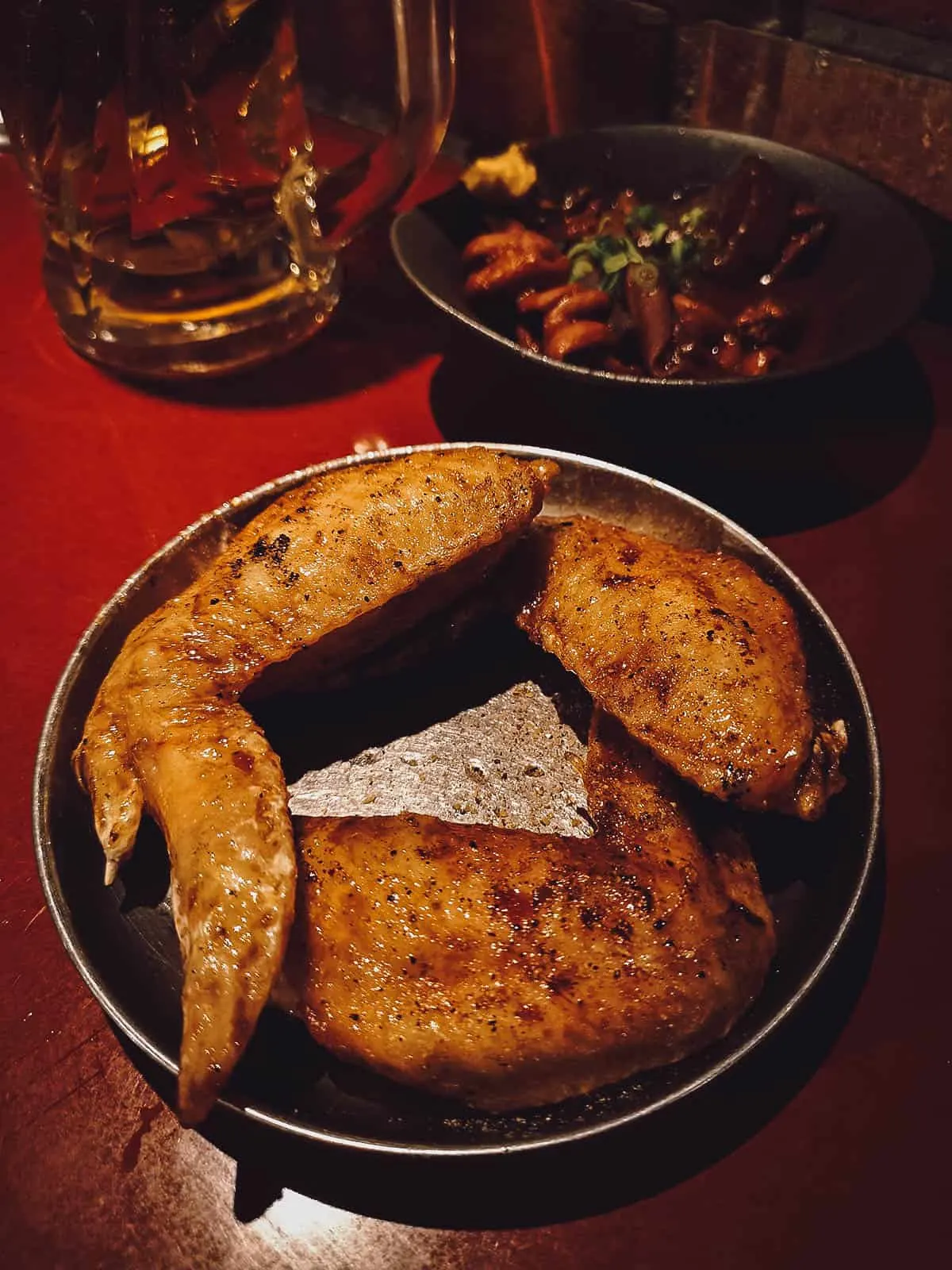
31. Doteni
Doteni refers to a Nagoya dish of beef tendon, innards, and daikon radish simmered in Hatcho miso sauce. Like tebasaki, it’s a staple izakaya dish that you need to try in Nagoya.
Doteni is one of my favorite dishes in Nagoya cuisine. Like miso katsu, the flavor from the Hatcho miso is what really makes this dish.
RECIPE: Horumon no doteni
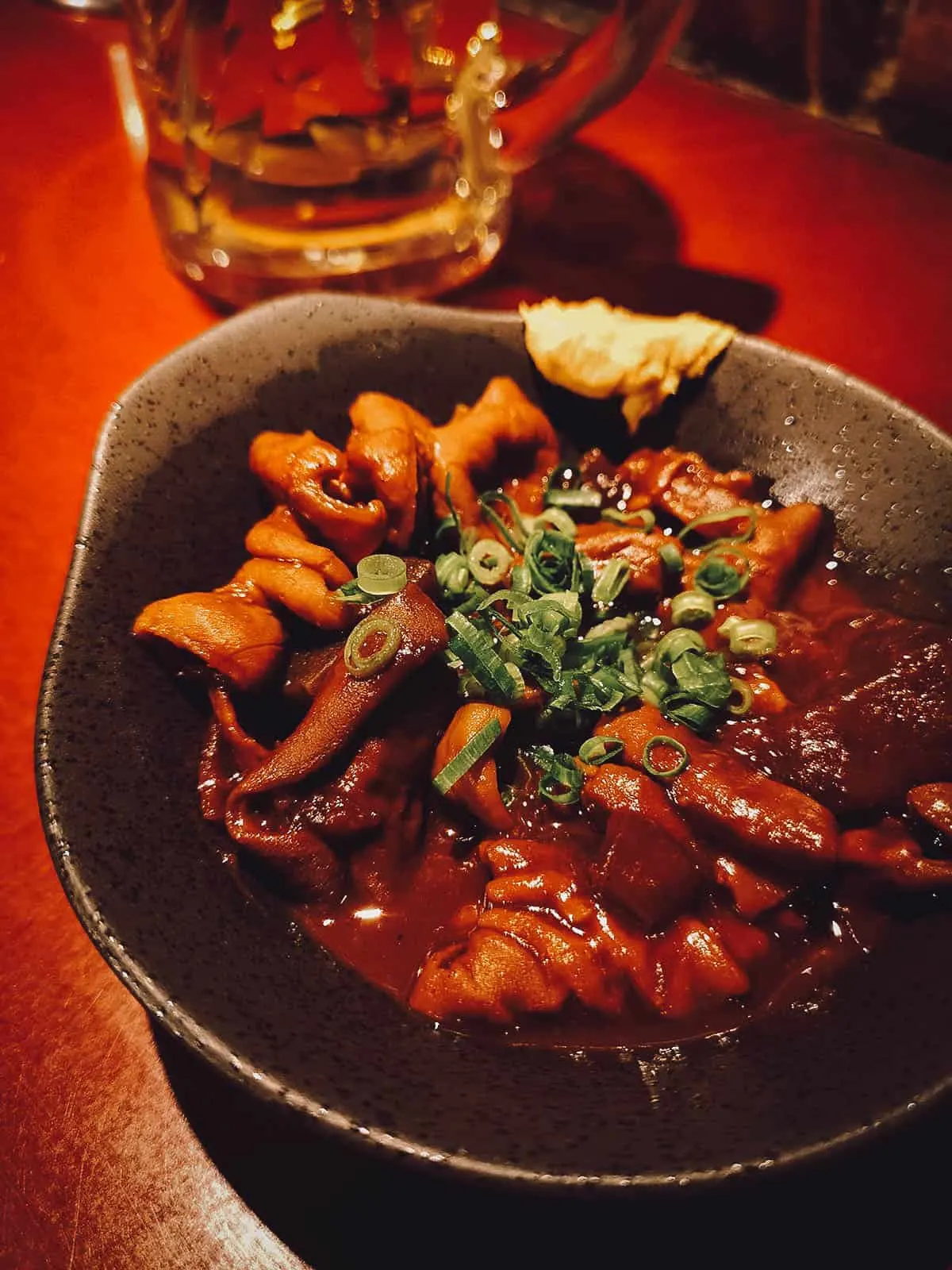
JAPANESE NOODLE DISHES
32. Udon
Along with ramen and soba, udon is one of the most popular noodle varieties in Japan. It refers to a type of thick chewy Japanese noodle made with wheat flour. It’s typically served hot in winter or chilled in summer and can be topped with ingredients like thinly chopped scallions, tempura, abura-age, and kamaboko (fish cakes).
Like ramen, the type of udon broth and toppings vary from region to region in Japan. Eastern udon tends to be darker brown in color while western udon is lighter. The broth’s color is determined by the type of soy sauce used.
Generally speaking, udon broth isn’t as flavorful as ramen broth, presumably to highlight the udon noodles which seem to be the real star of this beloved Japanese dish.
RECIPE: Kake udon
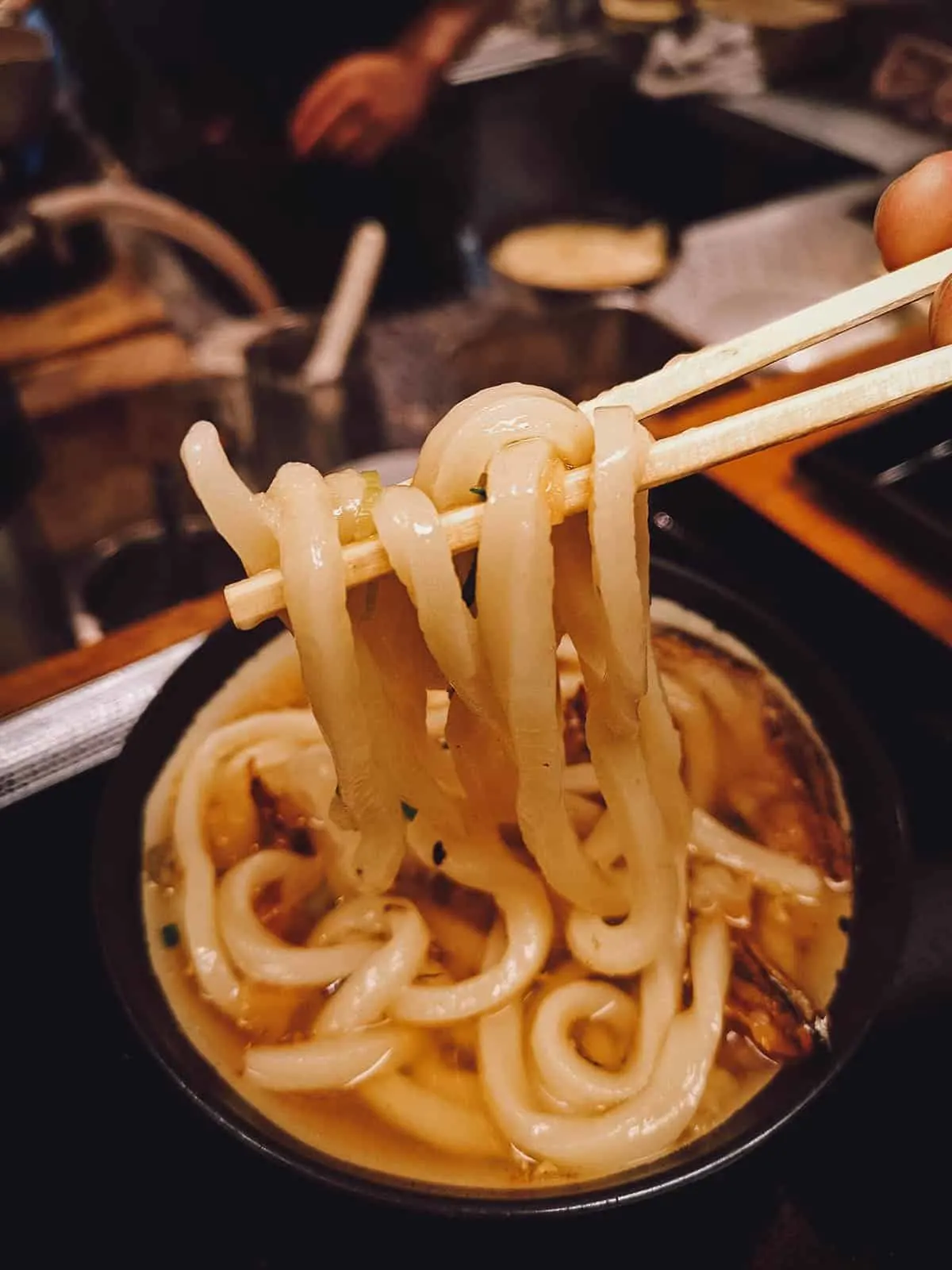
Kishimen is a type of udon dish from Nagoya. It’s made with udon noodles that are broad and flat.
I learned to make udon noodles in a Tokyo cooking class and the teacher told me to cut the noodles thinly, otherwise I’d be making Nagoya-style udon.
Like any udon dish, kishimen can be prepared hot or cold and seasoned with salt, soy sauce, miso, or Japanese curry. The most traditional version in Japan seems to be served in a hot broth with steamed fish cakes, spinach, deep-fried tofu, green onions, and bonito fish flakes.
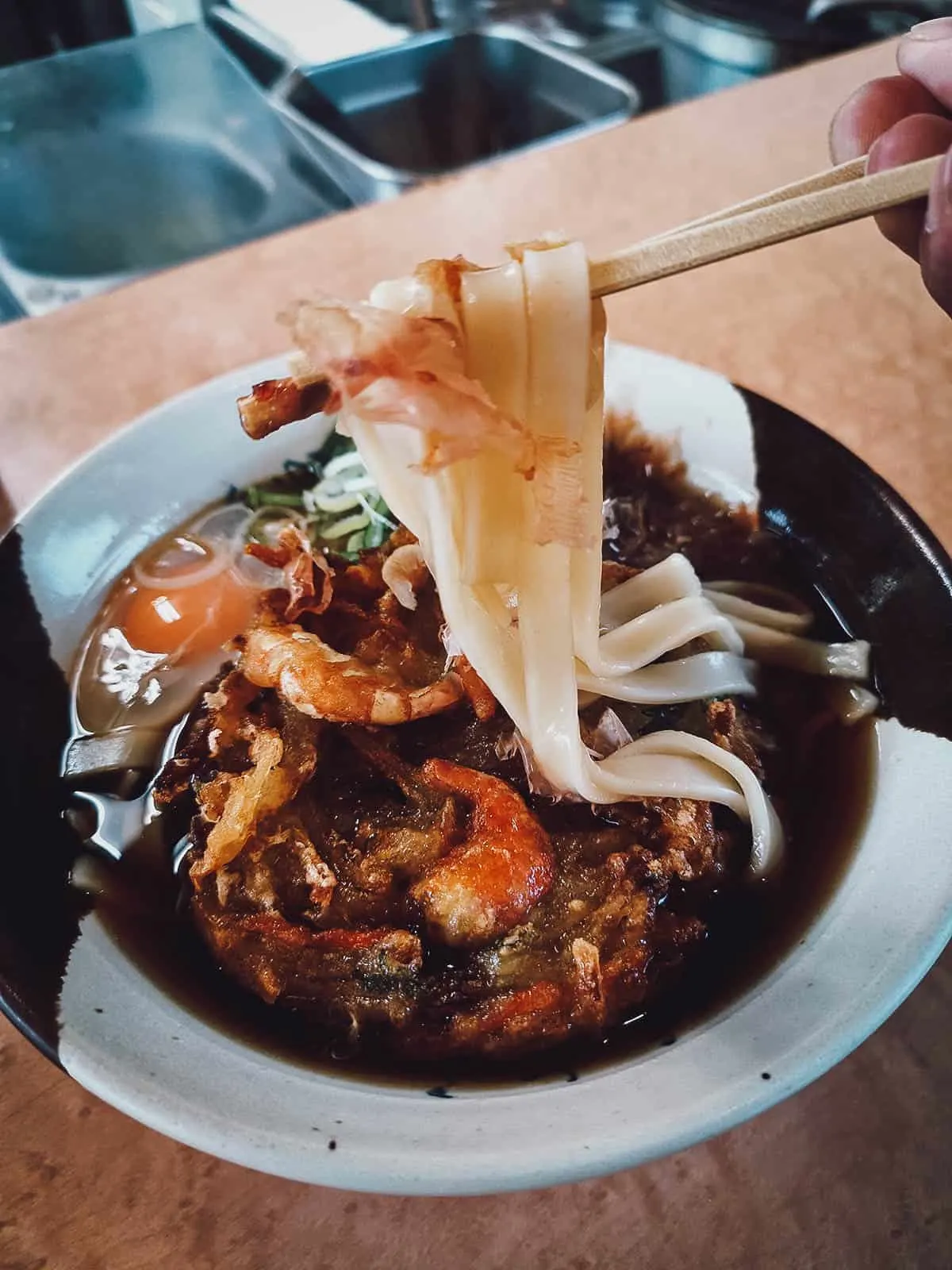
33. Soba
Soba refers to thin noodles made from buckwheat flour. They can be served cold with a dipping sauce called tsuyu, or in a hot broth as noodle soup.
Chilled soba noodles are often served on a bamboo tray (zaru) with a tsuyu of dashi, mirin, sweetened soy sauce, wasabi, scallion, and sesame seeds. To eat, you dip the buckwheat flour noodles into the tsuyu before slurping the noodles.
Eating them chilled is said to be the best way of appreciating soba noodles. Allowing them to soak in a hot soup often changes its texture. It’s the same reason why some people prefer tsukemen over regular ramen.
Soba is widely available throughout Japan but the best soba noodles are said to come from Nagano prefecture, where it’s known as Shinshu soba. Nagano’s drastic day and night temperature differences and its mountain soil rich in volcanic ash make it the ideal environment for growing soba.
Pictured below is the zaru soba from Kobayashi Soba in Matsumoto. They’ve been open for over a hundred years and are known for serving some of the very best soba in Japan.
RECIPE: Zaru soba
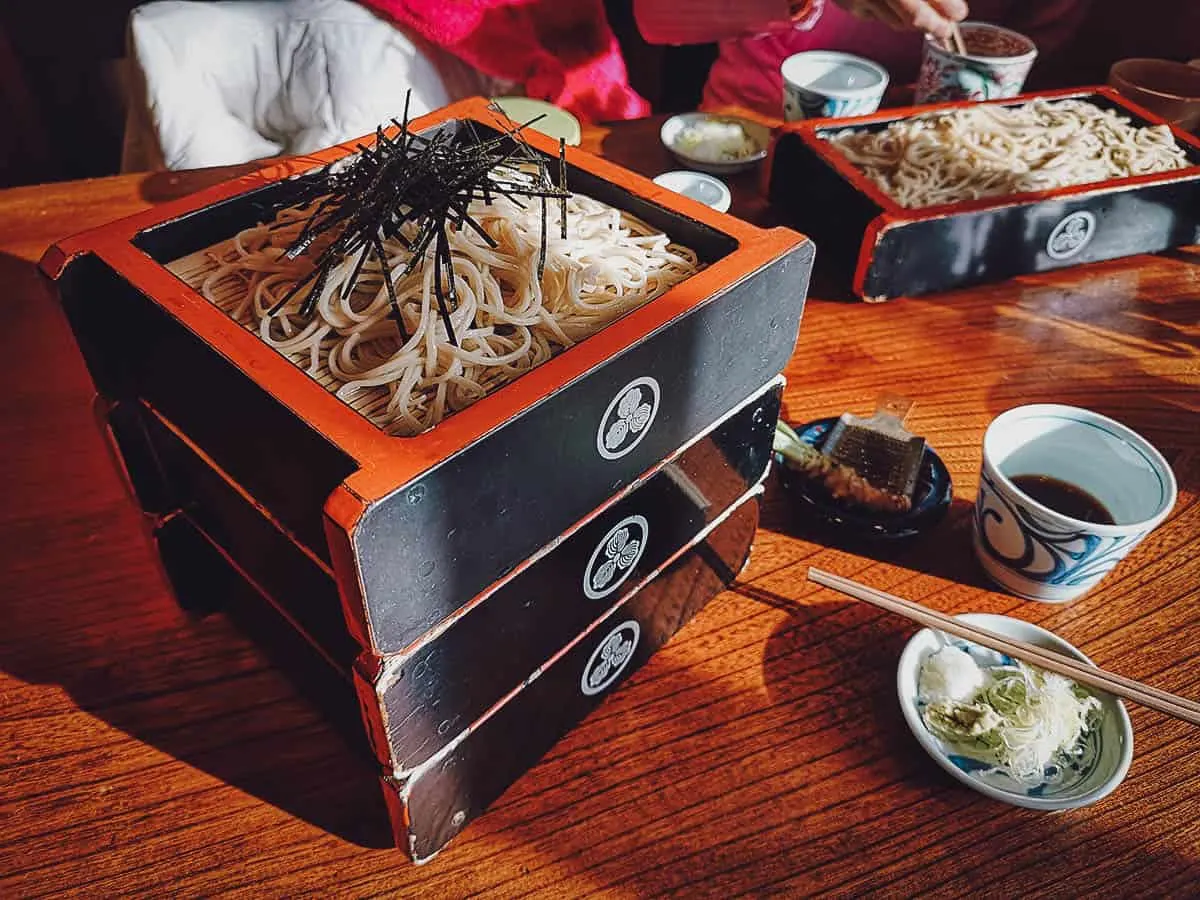
If you visit Matsumoto, then you may be interested in trying toji soba as well. It’s an interesting way of enjoying soba noodles that’s available only within certain areas in Nagano like Matsumoto.
Toji soba is similar to shabu-shabu. Using a small basket, you steep the soba buckwheat noodles in a hot broth for a few seconds before eating them with the vegetables inside the pot. It’s a popular Japanese winter dish and a unique way of enjoying soba in Matsumoto.
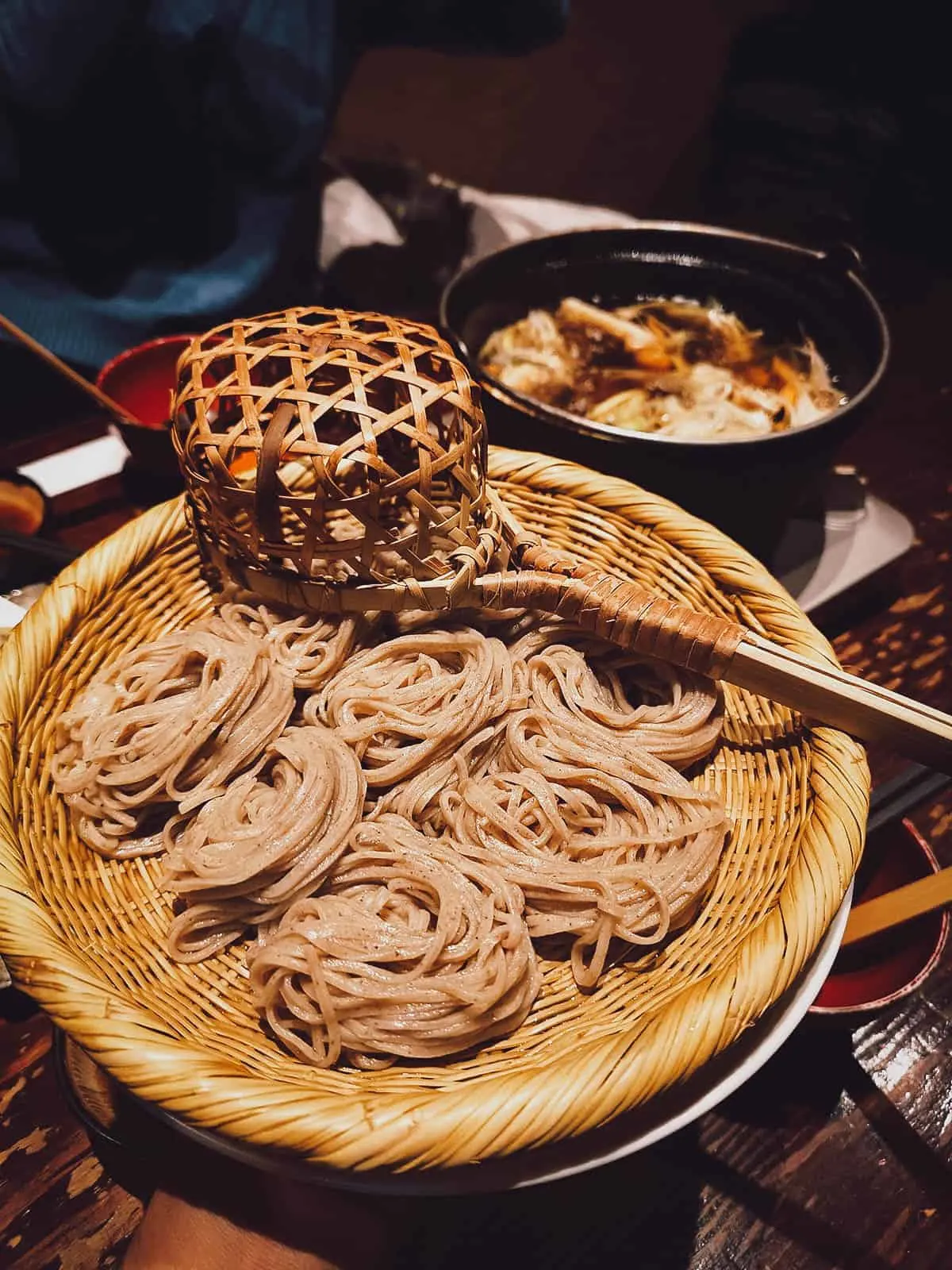
34. Champon
Like kakuni manju, champon is a Japanese-Chinese dish from Nagasaki. It’s a noodle soup dish made by frying pork, seafood, and vegetables with lard, then adding a soup made with chicken and pig bones. Champon ramen noodles are then added to the mix before boiling.
Champon was first served in Nagasaki by Chinese restaurant Shikairo. According to the restaurant, it was based on a dish in Fujian cuisine called tonniishiimen. It was created during the Meiji period to provide a cheap, filling meal for Chinese students attending school in Japan.
Champon is widely available in Nagasaki. We had it at Horaiken Bekkan, a highly regarded champon restaurant near the Atomic Bomb Museum.
RECIPE: Champon
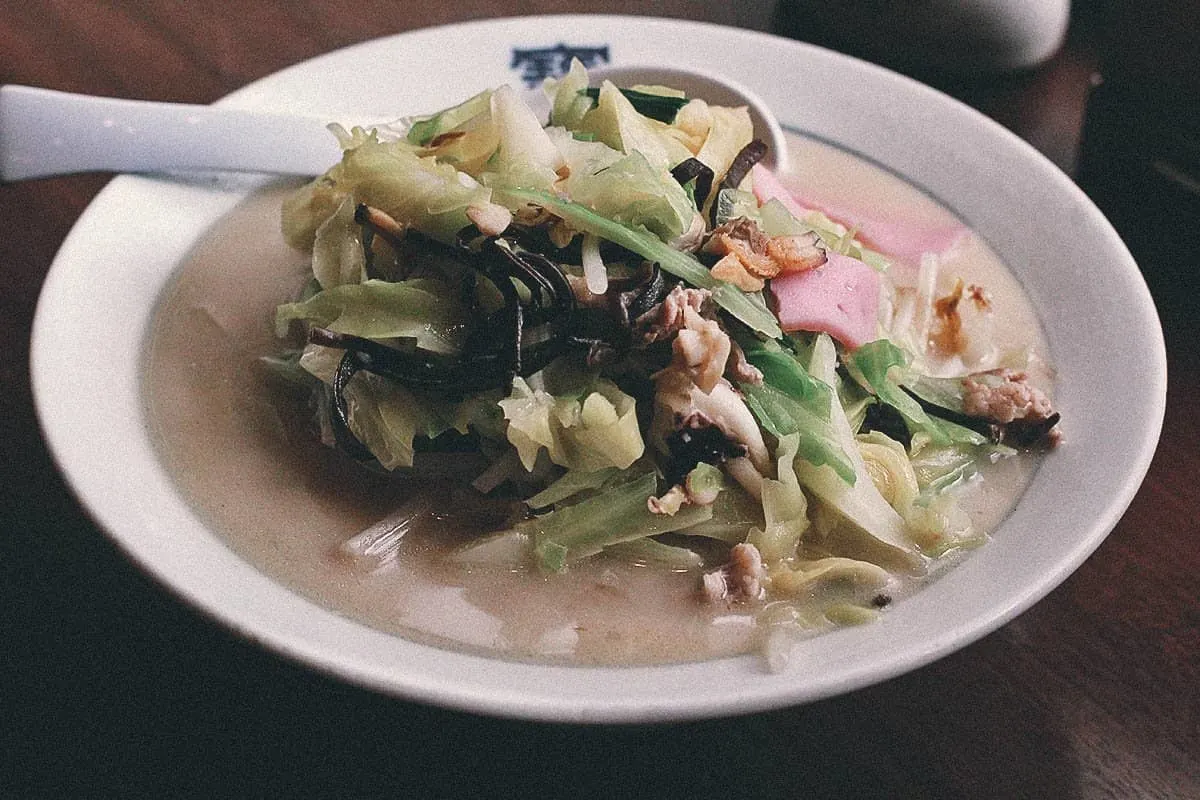
JAPANESE MIXED INGREDIENT DISHES
To be honest, I didn’t really know where to put these dishes. They aren’t predominantly meat or seafood dishes but I couldn’t categorize them as vegetarian either so I decided to create this section of mixed ingredient Japanese dishes.
35. Chawanmushi
Chawanmushi is a popular Japanese savory egg custard dish. In Japan, it’s traditionally served hot in winter and chilled in summer and is usually part of a larger set meal.
Chawanmushi recipes vary but it’s typically made with ingredients like shiitake mushroom, parsley, ginkgo, lily, chestnut, chicken, and different types of seafood.
Some accounts trace the origin of chawanmushi to 17th century Nagasaki. It’s said to be one of the dishes served in shippoku set meals which are large, banquet-type spreads containing a medley of Chinese, Western, and traditional Japanese dishes.
You can find chawanmushi anywhere in Japan. If you visit Nagasaki, then we suggest trying it at Yossou. They’ve been open since 1866 and make their signature chawanmushi with nine specific ingredients – white fish, chicken, shiitake mushrooms, kikurage mushrooms, bamboo shoots, ginkgo, kamaboko, wheat powder, and anago.
RECIPE: Chawanmushi
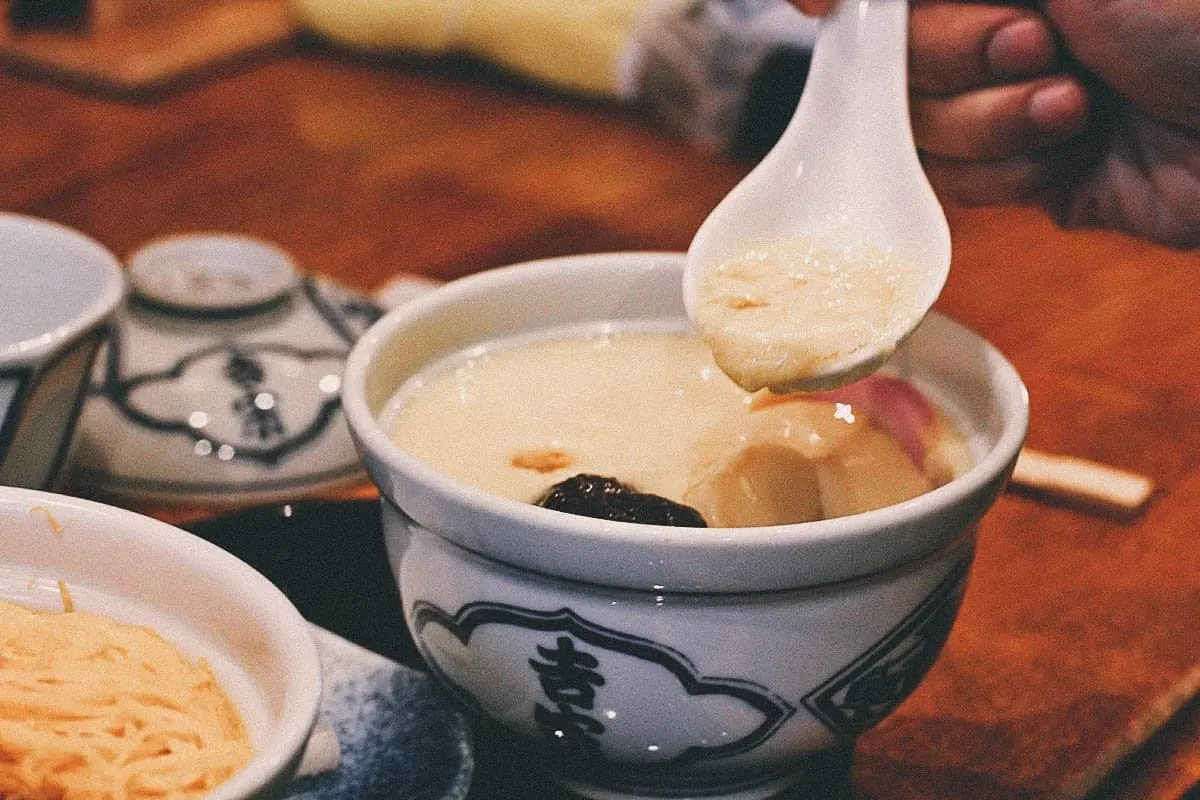
36. Oden
Oden refers to a type of nabemono (Japanese one-pot dish) made with any number of ingredients like chikuwa, konnyaku, ganmodoki, daikon, and boiled eggs stewed in a soy-flavored dashi broth.
It’s a popular Japanese dish enjoyed throughout the country – at restaurants, izakayas, even konbinis (convenience stores) like 7-Eleven. Ingredients vary between restaurants but it’s usually served with a side of karashi (Japanese mustard).
RECIPE: Oden
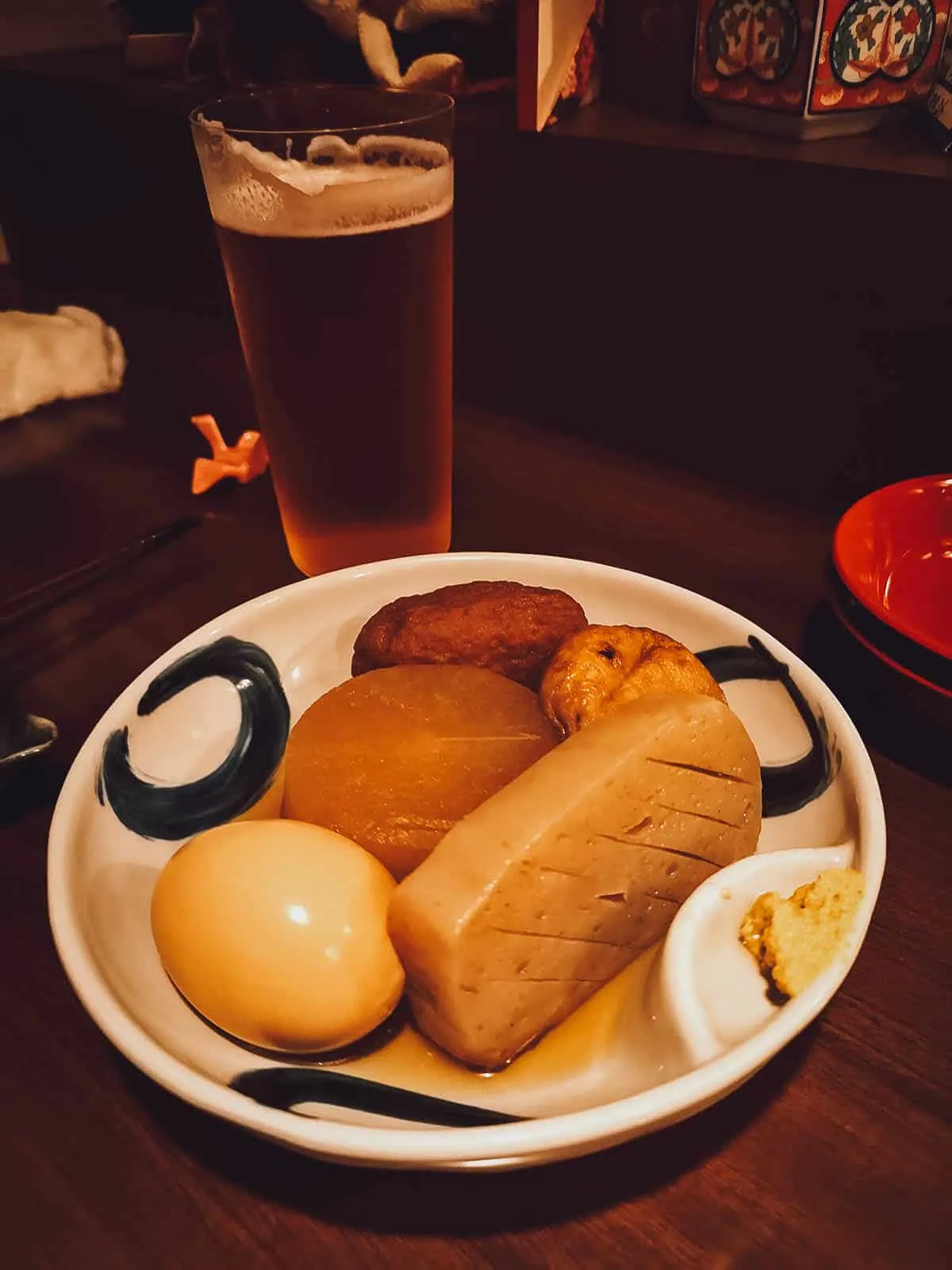
37. Onigiri
Onigiri is a type of Japanese snack made from rice, nori (seaweed), and a filling. They’re referred to as rice balls even though they aren’t always shaped like balls.
White rice is formed in triangular or cylindrical shapes and wrapped in nori. It’s typically filled with ingredients like tuna, salmon, umeboshi, katsuobushi, mentaiko, kombu, or any other salty/sour ingredient that can be used as a natural preservative.
In spite of its appearance and name, onigiri shouldn’t be confused as a type of sushi. Sushi is made with vinegared rice while onigiri is made with unseasoned white rice.
You’ll find different types of onigiri sold at every konbini in Japan. It’s a popular Japanese snack and personally my favorite thing to eat when I’m looking for a quick bite to eat in Japan.
RECIPE: Onigiri
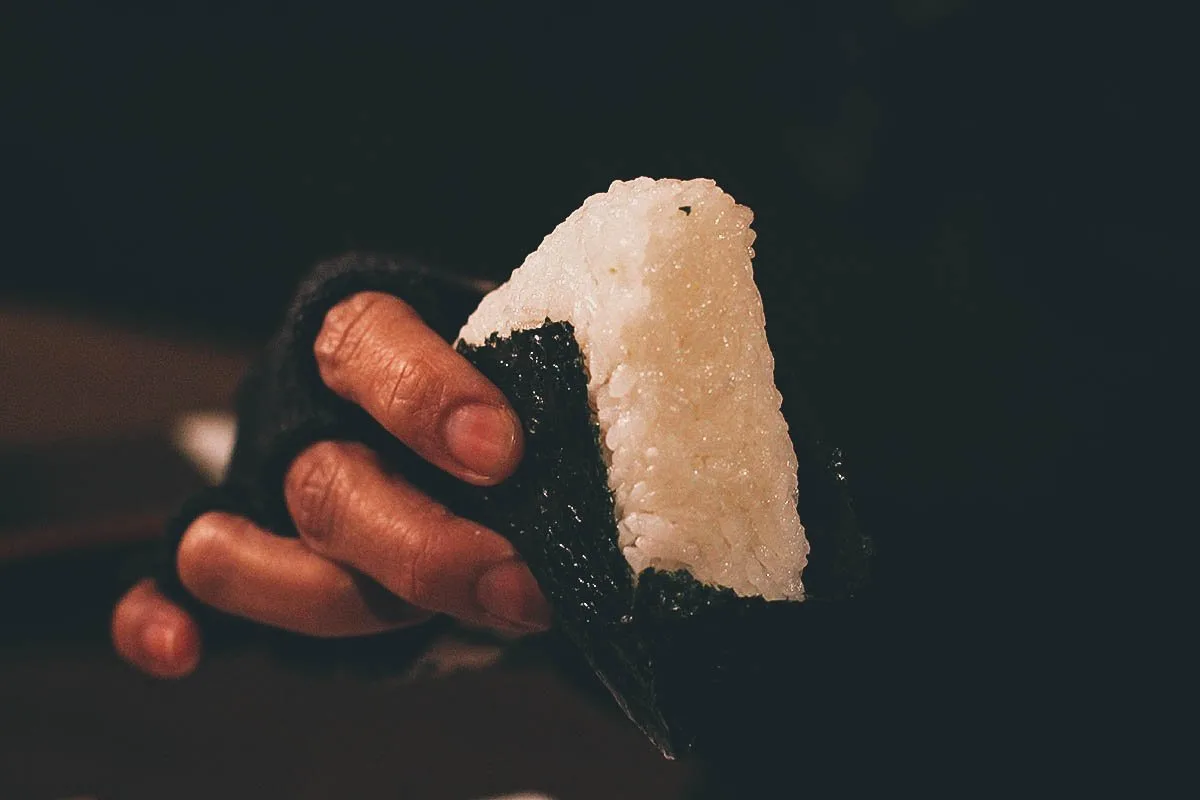
38. Monjayaki
Monjayaki is the quintessential Tokyo dish. According to my Japanese friend, you can’t talk about Tokyo food without talking about monjayaki.
Monjayaki refers to a Japanese dish made with pan-fried batter. It’s similar to okonomiyaki except the batter used to make it is much runnier due to the addition of dashi or water. When cooked, it has the texture of melted cheese and doesn’t quite solidify into pancake form the way okonomiyaki does.
Like okonomiyaki, monjayaki is usually cooked on your table. Shredded cabbage is spread out over the griddle before being poured over with the batter. The server then mixes it all up for a few minutes before allowing it to rest and cook for a few more minutes.
Monjayaki can be made with any number of ingredients like pork, octopus, squid, shrimp, and other types of seafood. To eat, you scoop small sections off using a spatula. It’s an interesting Japanese dish that you should try when you visit Tokyo.
RECIPE: Monjayaki
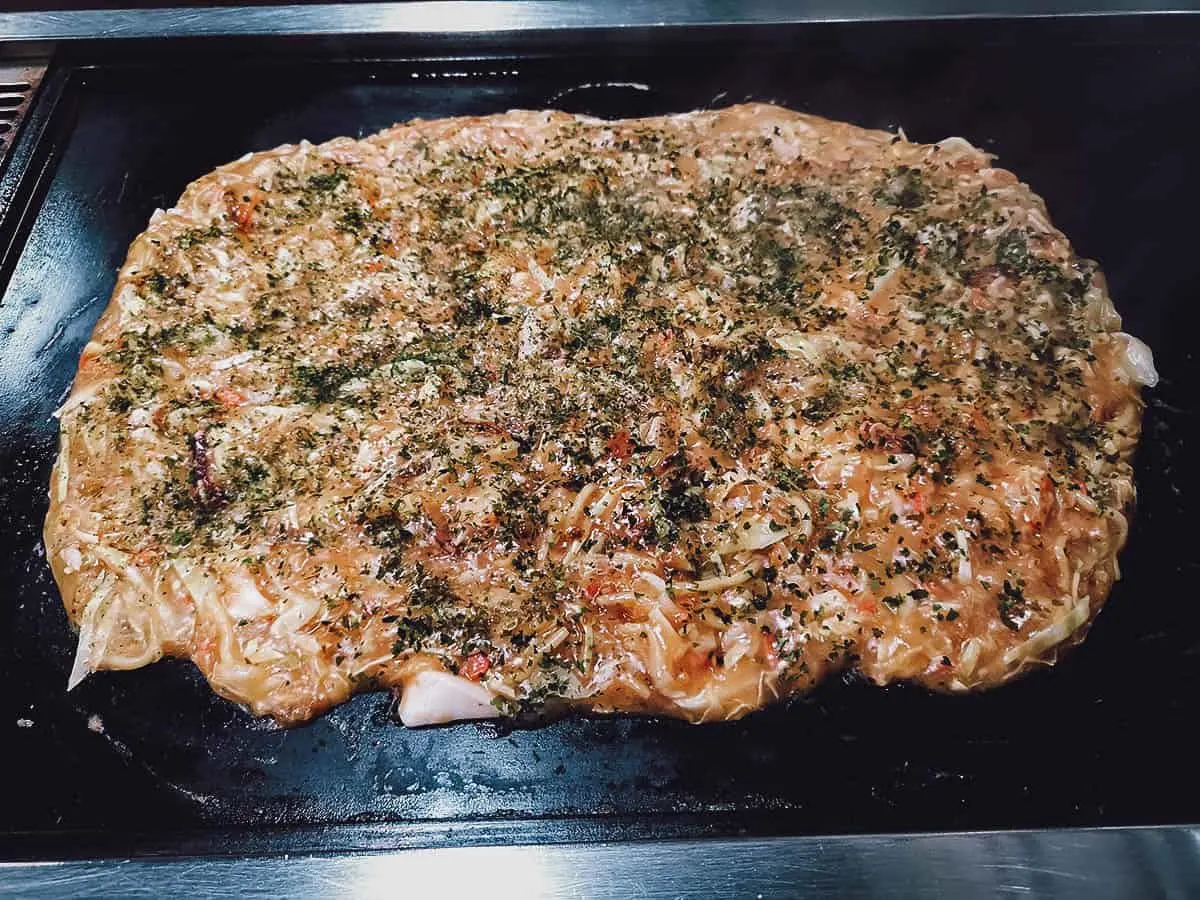
39. Tamago Kake Gohan
Often referred to as “TKG”, tamago kake gohan is a popular Japanese dish of steamed rice topped with raw egg and soy sauce.
According to my Japanese friend, it’s a type of Japanese comfort food that’s similar to an American PB&J sandwich. It’s a dish locals like to eat when they want something simple and comforting.
The Japanese often consume tamago kake gohan with just raw egg, white rice, and soy sauce, but it can be made with other ingredients as well like chicken.
RECIPE: Tamago kake gohan
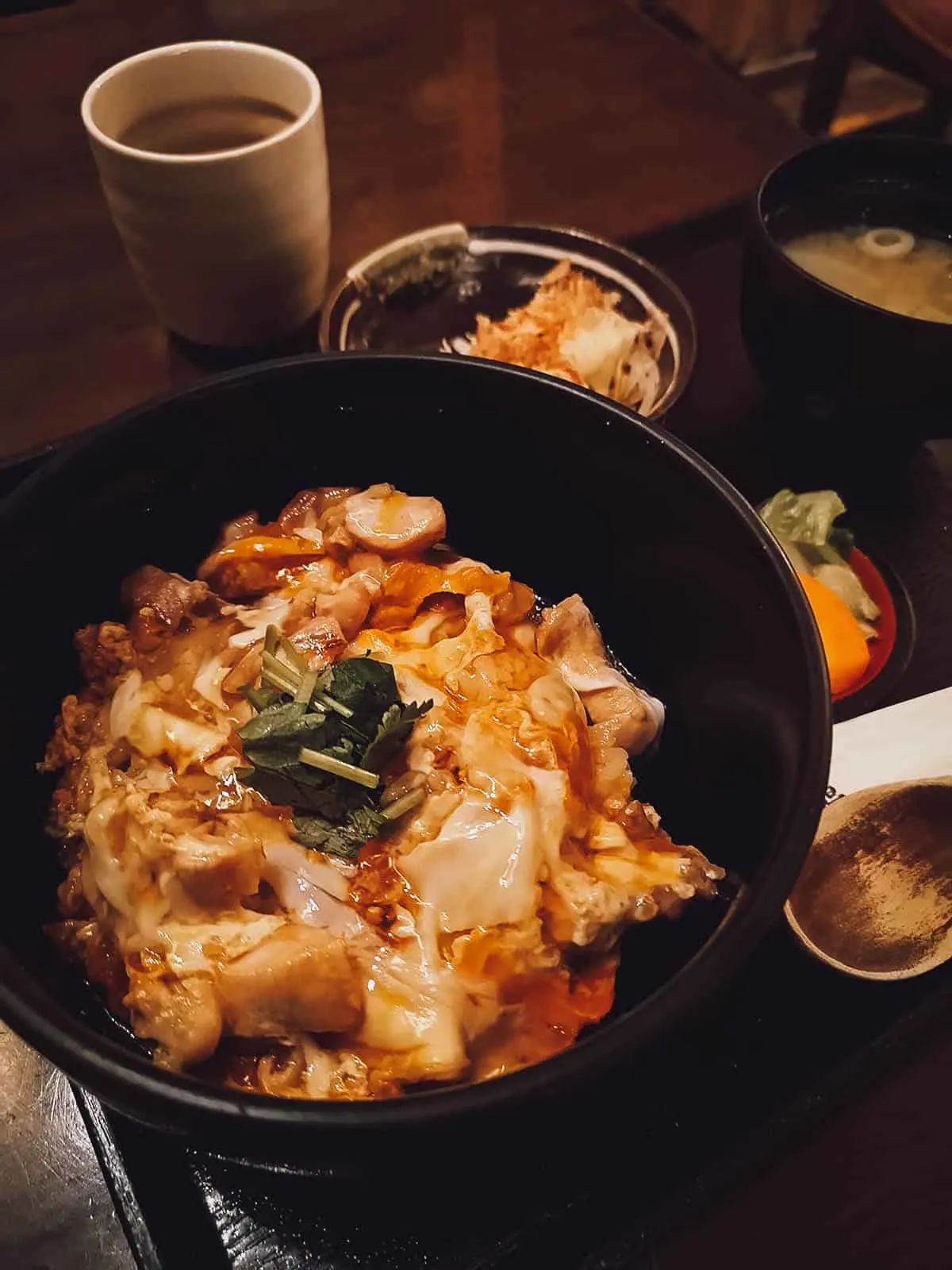
40. Kaiseki
Like yakiniku, kaiseki is more a Japanese culinary term than a dish. It refers to a traditional multi-course meal in Japan consisting of over ten small artfully prepared Japanese dishes.
You can think of kaiseki as the Japanese equivalent to western haute cuisine. It’s usually served at ryokans and small restaurants in Japan called ryotei over a course of several hours.
There’s no formula for kaiseki meals though there is a prescribed order to the dishes. Kaiseki typically consists of appetizers, a soup course (suimono), seasonal courses, cooked dishes, a rice course (shokuji), and dessert and tea.
Much is left to the creativity of the chef who’s free to omit any course except the suimono and shokuji courses. Kaiseki can be enjoyed throughout Japan though it’s said to have its roots in Kyoto.
If you visit Kyoto and want a truly special Japanese meal, then I suggest making arrangements for a kaiseki dinner. It’s one of the best culinary experiences you can have in Japan.
HOW-TO GUIDE: Preparing kaiseki ryori
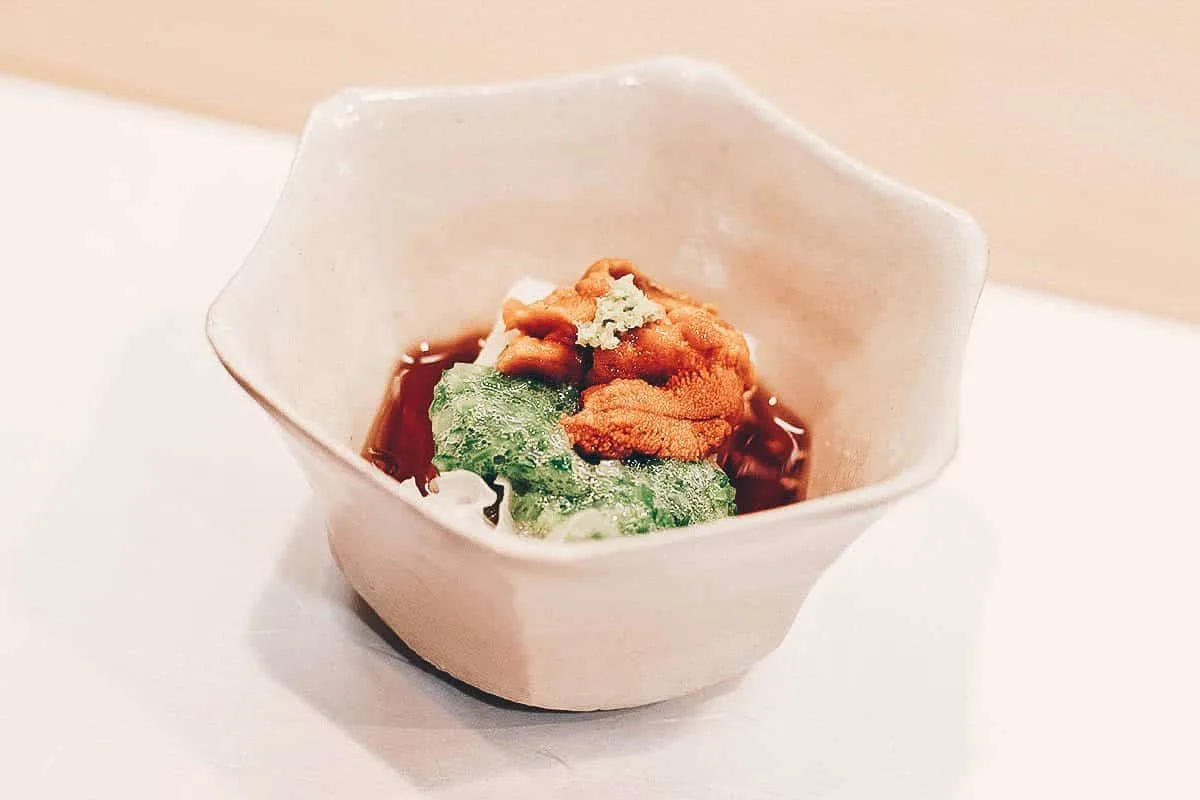
JAPANESE DESSERTS / DRINKS
41. Matcha
Matcha is an important part of Japanese culture. It refers to a finely ground powder of specially grown and processed green tea leaves.
Traditionally, matcha is mixed with hot water to make tea. It’s the central component in Japanese tea ceremonies which revolve around the preparation, serving, and drinking of matcha as hot tea. The Japanese drink it often as it’s touted to have many health benefits.
Pictured below is a cup of matcha with wagashi from an informal tea ceremony I enjoyed in Kanazawa. Wagashi are carefully crafted traditional Japanese sweets or confections that are usually served with green tea. Considered an art form in Japan, it comes in many shaped and can be made with a diverse array of ingredients and preparation methods.
The best matcha in Japan is said to come from Uji, a small town between Kyoto and Nara. The highest grade of matcha is referred to as ceremonial-grade matcha and is the type used in Japanese tea ceremonies.
RECIPE: Matcha
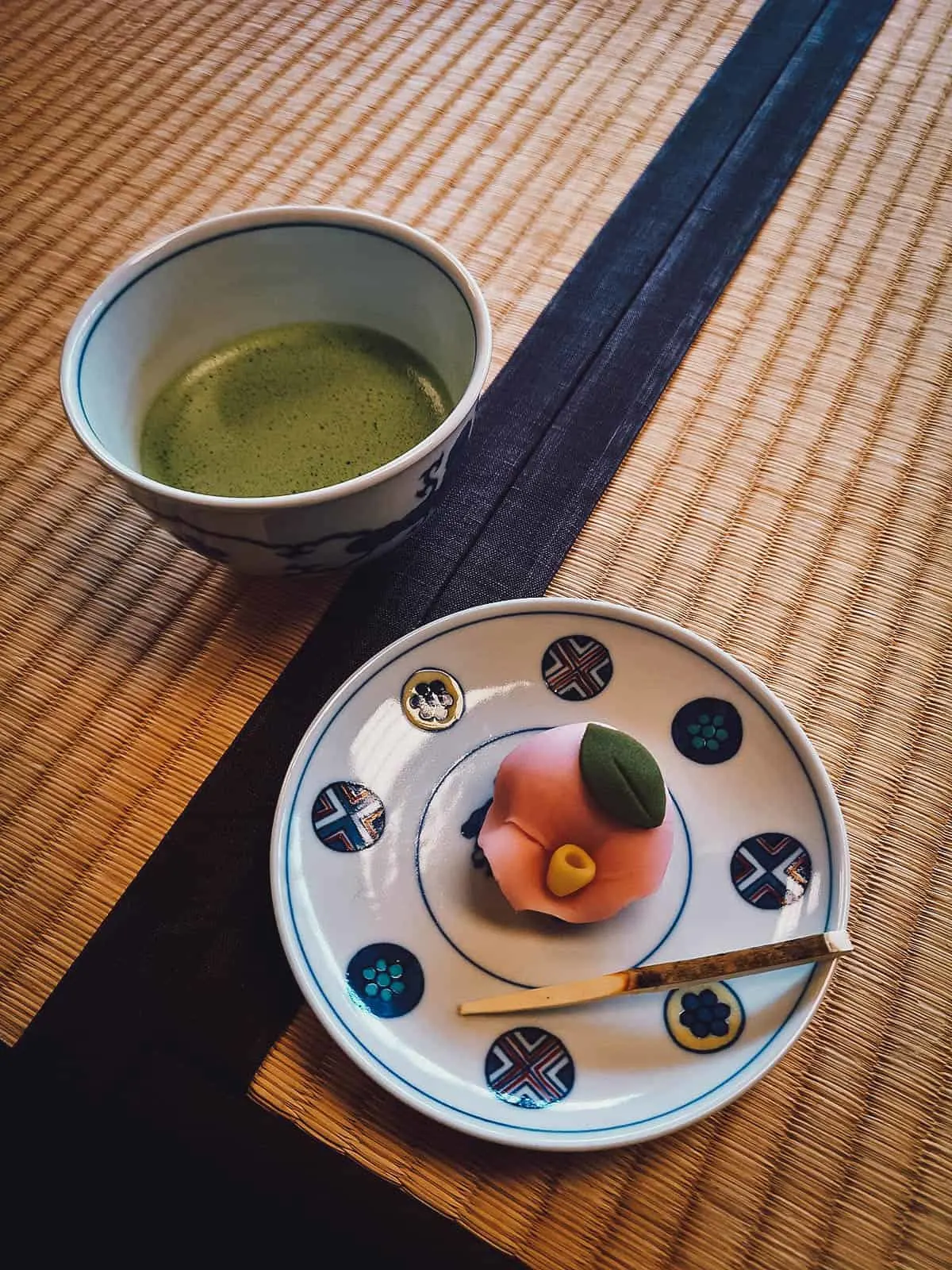
Matcha may be the central component in traditional Japanese tea ceremonies but the ingredient has found its way into many modern dishes as well.
Culinary-grade matcha is used to flavor a spectrum of trendy food products in Japan like mochi, ice cream, chocolates, candy, lattes, cakes, and pastries. It’s even used to flavor savory Japanese dishes like soba and tempura.
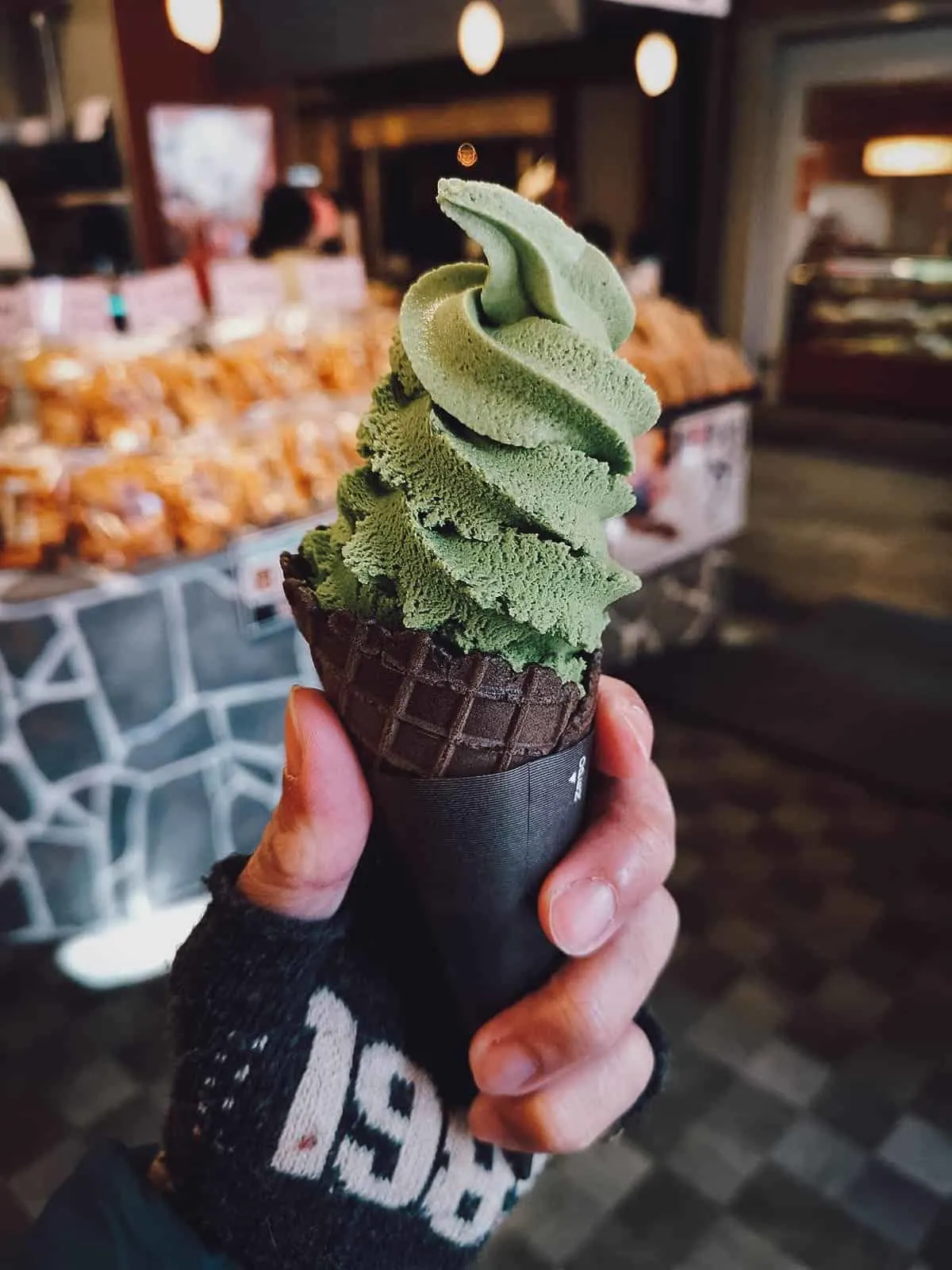
42. Mochi
Mochi is one of the most well-known Japanese sweets. It refers to a popular Japanese rice cake made from mochigome, a glutinous short-grain rice. The rice is pounded into a paste before being molded into the desired shape.
Mochi can be enjoyed year-round in Japan though it’s traditionally eaten to usher in the Japanese New Year. It’s often eaten on its own but it can also be used as an ingredient in many products like confections and ice cream. Apart from attracting good fortune, it’s believed that long strands of freshly made mochi symbolize a long life and good well-being.
If you visit Japan in spring, then be sure to look out for a special type of pink mochi called sakuramochi. It’s made to welcome spring in Japan and is filled with a sweet red bean paste and wrapped in a pickled cherry blossom leaf.
Mochi is traditionally made in a labor-intensive process called mochitsuki. The steamed rice is pounded with a heavy wooden mallet (kine) in a large mortar (usu).
Two people work in tandem – one pounds while the other turns and wets the mochi. They have to keep a steady rhythm so as not to crush the mochi-wetter’s hand with the heavy kine!
RECIPE: Mochi
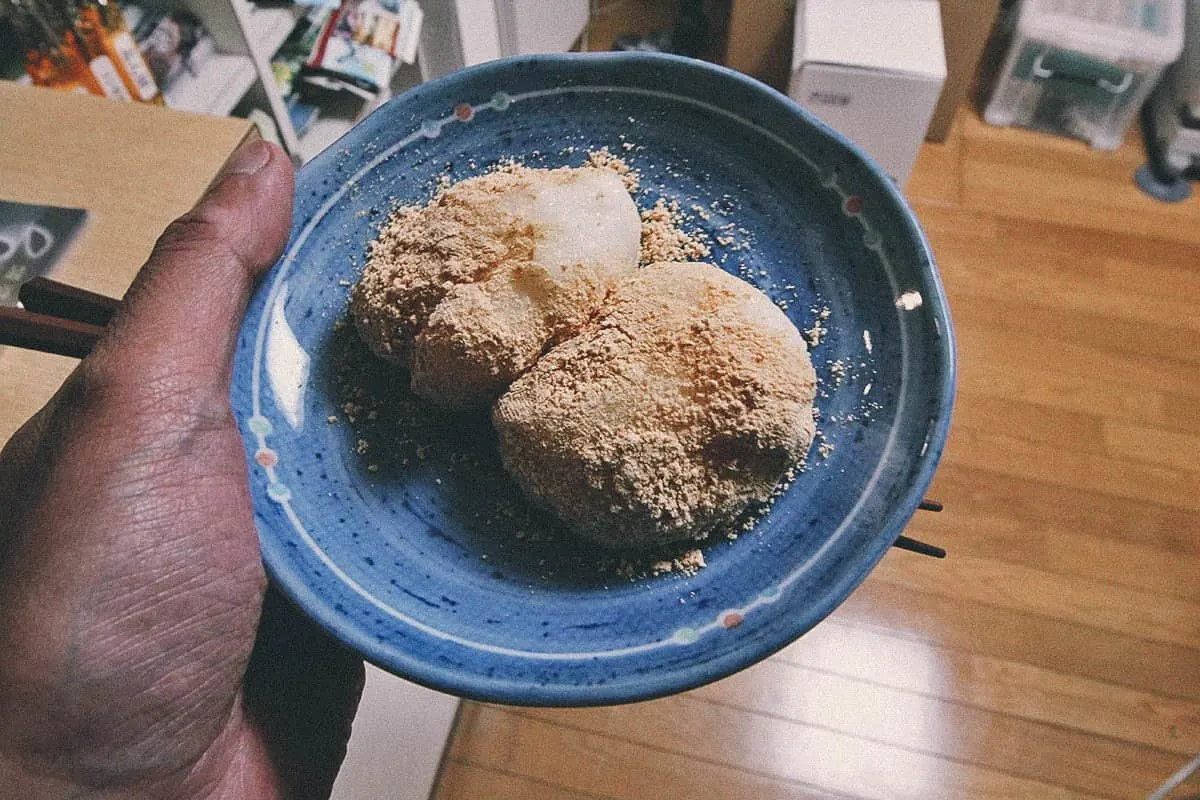
43. Hokkaido Dairy
Hokkaido is the biggest prefecture in Japan and home to a massive dairy industry. They produce about half of the country’s milk and 90% of its cheese.
Dairy from Hokkaido is more expensive than dairy from other prefectures because of its reputation for quality and freshness. It’s so highly regarded that you’ll often find labels on packages proudly showing they were made with Hokkaido dairy.
This is true even outside of Japan. Many dessert and pastry shops in Asia will often create and highlight products made with Hokkaido dairy.
There are terrific dairy products everywhere in Hokkaido but the best we found were in Otaru, a small port city less than an hour northwest of Sapporo. You can try it in pastries, cookies, custard, and other Japanese desserts, though the most popular is soft serve ice cream.
Take a stroll down Sakaimachi Street and sample goodies at its many dairy shops. Be sure to stop at the hugely popular LeTao to pick up one of these double fromage cheeseckaes. It’s insanely delicious.
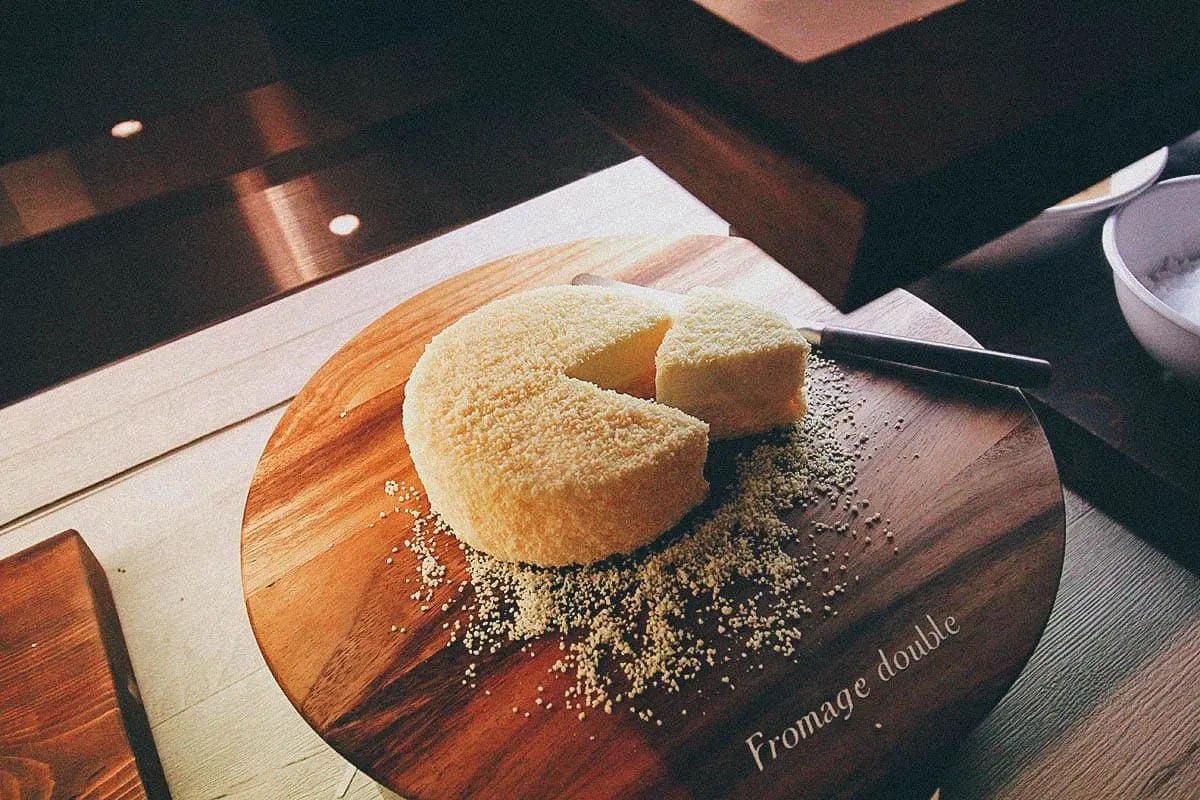
44. Castella Cake
Castella is a Japanese sponge cake made with sugar, flour, eggs, and starch syrup. It was brought to Japan by Portuguese merchants in the 16th century through Nagasaki, which at the time was the only Japanese port open to foreign commerce.
Today, castella cake is considered a specialty of Nagasaki, its name derived from the Portuguese dish Pao de Castela meaning “bread from Castile”.
Castella cake is available at many shops in the city and is one of Nagasaki’s most popular tourist gift items. We bought a few boxes at popular Castella chain Bunmeido.
RECIPE: Castella cake
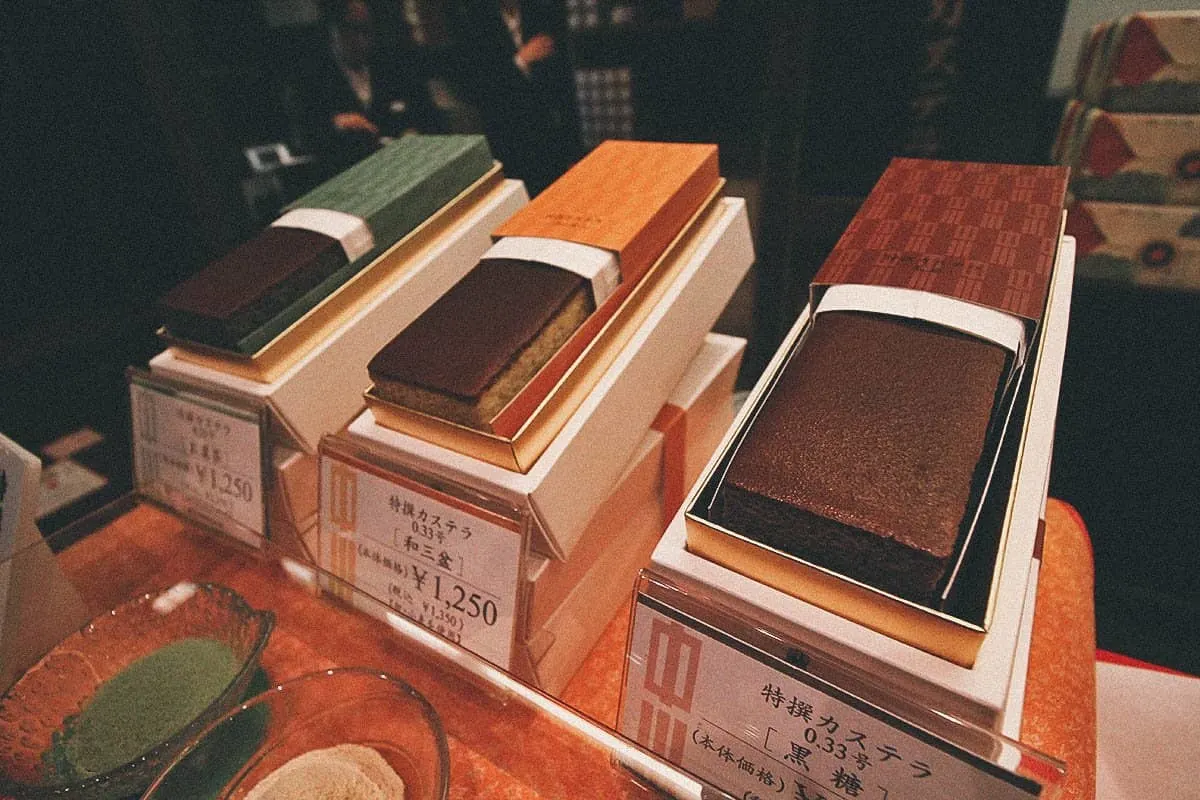
45. Sake
Sake is the national beverage of Japan. It refers to an alcoholic drink made by fermenting rice that’s been polished to remove the bran.
Sake is referred to as Japanese rice wine though its brewing process is actually closer to beer than wine. Like beer, sake is produced by converting starch into sugars which ferment into alcohol.
I went on a sake tasting tour in Kyoto’s Fushimi district and I was fascinated by the process. Like wine, you can pair different types of sake with certain dishes to bring out the flavor and character of the sake and food.
If you’d like to learn more about sake in Kyoto, then you can book a sake tasting tour through Magical Trip.
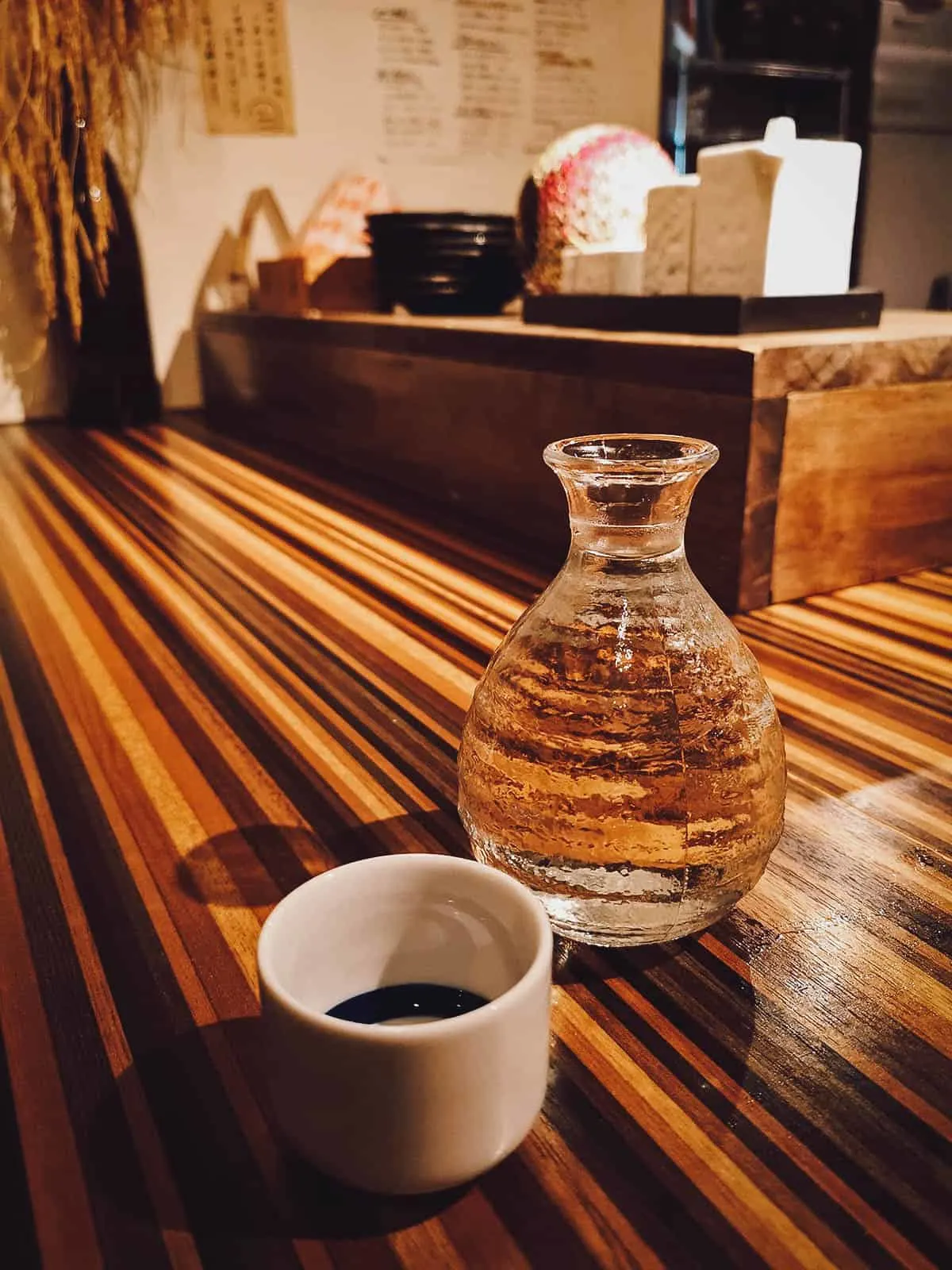
JAPANESE FOOD TOURS
No one knows Japanese food better than a local, so what better way to experience Japanese cuisine than by going on a food tour? A knowledgeable local will take you to the city’s best spots and markets and explain every dish to you in more detail.
We’ve gone on food tours in Tokyo and Kyoto and enjoyed them both very much. If you’re visiting Japan, then check out Get Your Guide and byFood for a list of food tours in Tokyo, Osaka, and other destinations throughout the country.
JAPANESE COOKING CLASSES
Aside from food tours, we enjoy taking cooking classes when we travel. For me, it’s one of the best ways to learn about the local cuisine because you get to see the different ingredients and methods that go into making it.
As described, I took a cooking class in Tokyo where I learned to make Japanese dishes like tempura, udon, and tamagoyaki. Before your trip, check out Cookly and byFood for a list of cooking classes in Tokyo and in other cities throughout Japan.
FINAL THOUGHTS ON JAPANESE FOOD
We’ve been to Japan many times but I feel like we’re only beginning to scratch the surface of Japanese cuisine. We’ve visited less than half of the 47 prefectures in Japan so this Japanese food guide still has a long way to go.
As described, it’s a labor of love that I’ll be expanding and refining after every trip to Japan. We enjoy the food in Japan so much that we plan on visiting at least once a year every year until we’ve explored every prefecture and experienced most of its regional Japanese food.
As always, I’m a food enthusiast, not an expert, so if you spot any mistakes or wrong information, then feel free to let me know in the comments section below. I’d love to hear your suggestions for any must-try Japanese dishes as well.
Thanks for reading and have a wonderful time eating your way through Japan!
Disclosure
Some of the links in this Japanese food guide are affiliate links. We’ll get a small commission if you make a purchase at no additional cost to you. We only recommend products and services that we use ourselves and firmly believe in. We really appreciate your support as it helps us make more of these free travel guides. Thank you!


Tara
Saturday 3rd of February 2024
Thank you for such an informative article. I was wondering if you had any recommendations for someone who doesn't like sweetness in their savory foods (I noticed a lot of the food is topped with sweet sauces). I prefer salty, spicy foods and I'm traveling to Japan in a few weeks and would love some recommendations.
JB & Renée
Wednesday 7th of February 2024
Hi Tara, ramen and udon are the first dishes that came to mind. Karaage would be nice too. Which cities in Japan are you visiting?
Grace
Thursday 18th of May 2023
Hey, are these ALL your photos? They look incredible and if they are, you must have been in Japan for awhile. You tried so many dishes! 😊
JB & Renée
Sunday 21st of May 2023
Thanks Grace! Unless given attribution under the photo, then yes, they're all mine. We visit Japan often so I have years worth of photos.
Robert
Monday 16th of May 2022
Very nice article. I really liked the detail and easy read (including specialties by prefecture/location). One thing I would like to add. Motsunabe is Korean in origin (just like mentaiko even though it was not listed in the article).
"The roots of Motsunabe date back to World War II. It starts when Koreans who worked as coal miners at that time cooked hormones and leeks. They cooked this in aluminum pots and ate them with soy sauce flavor. Since then, in addition to beef and pork tripe and leeks, ingredients and flavors have changed little by little. So by the 1960s, sesame oil, peppers, green onions, etc. were added to the food in a sukiyaki style."
https://foodinjapan.org/kyushu/fukuoka/motsunabe/
They still eat in Korea where offal is still popular.
JB & Renée
Wednesday 18th of May 2022
Thank you for sharing that Robert! I love reading about the origins of food. That makes perfect sense actually. Motsunabe does seem like more of a Korean dish than Japanese. You've just inspired us to have a closer look at offal on our next trip to Korea. Thank you!
Marcus Lim
Friday 11th of February 2022
This article is amazing, I am already feeling hungry
JB & Renée
Sunday 20th of February 2022
Happy to hear that Marcus!
Rakhinationwide
Monday 15th of March 2021
What a fabulous post!! Very interesting.
JB & Renée
Tuesday 23rd of March 2021
@Rakhinationwide: Thank you. :)